WESTERN WINGSHOOTING AT ITS BEST
TROPHY
DALL’S RAMS OF THE YUKON
7GIANT BUCK
CLUES
THE ALLURE OF FALCONRY HUNTING ADVENTURES WITH KIDS
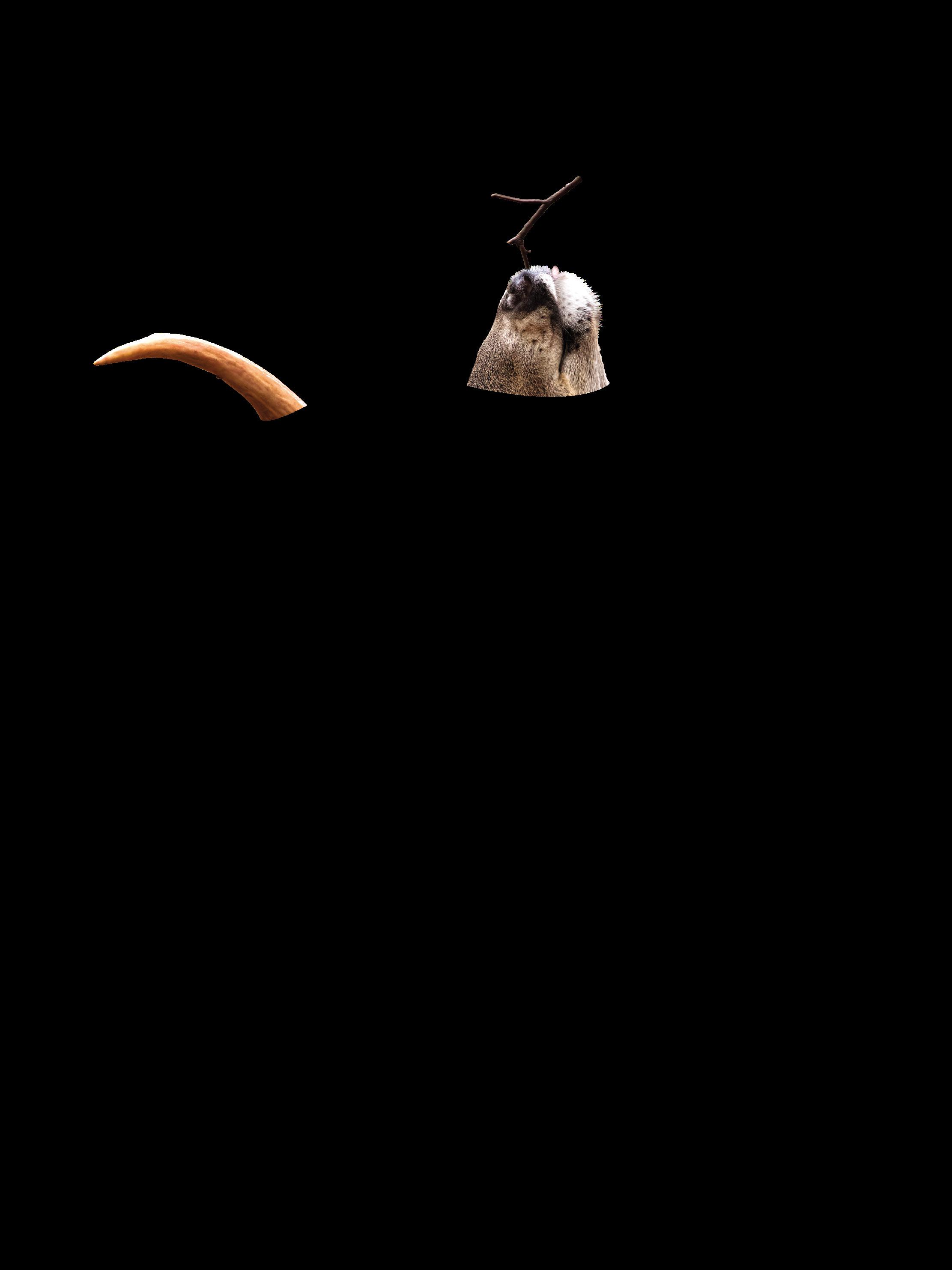
BONUS : NED RIGS • STEELHEAD • CISCOES • FLY RODS















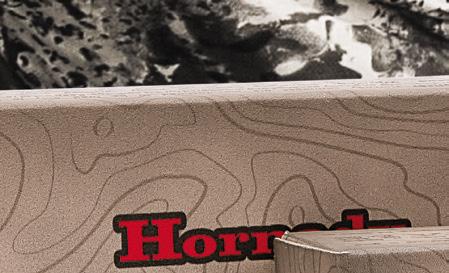
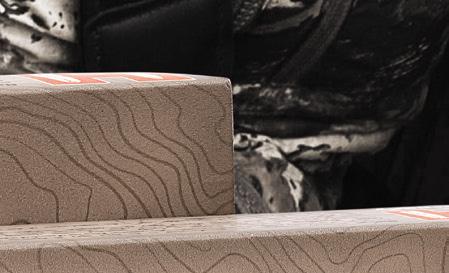
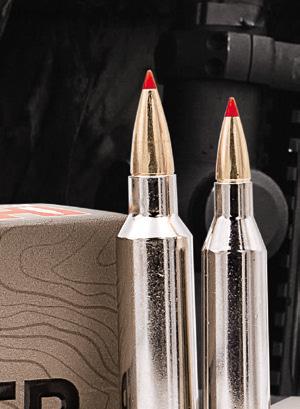
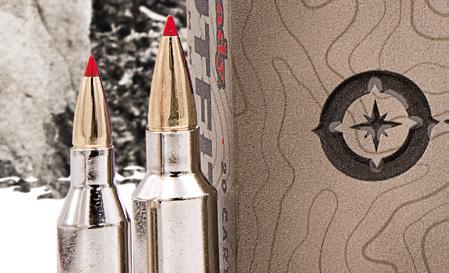
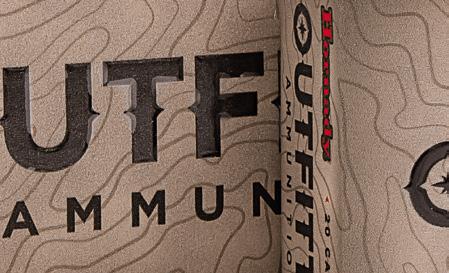

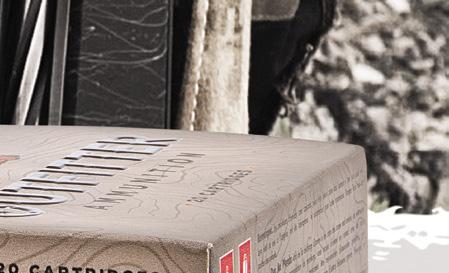


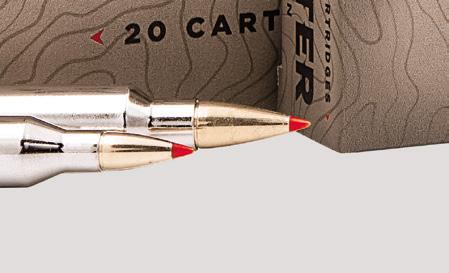

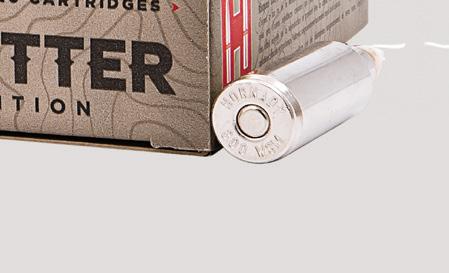
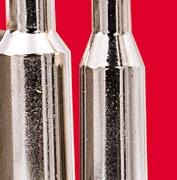

























Loaded with the advanced BULLET 800-338-3220 | HORNADY.COM NEW ADVENTURES AWAIT No hunt is too wild. No location too extreme. Trust your hunt to Outfitter ® ammunition. From its watertight nickel-plated cases to its rugged CX ™ bullets, it’s the ammo that can keep up with Jim Shockey — wherever adventure takes him. No matter where adventure takes you, rely on Outfitter ® ammunition. 243 WIN | 257 WBY MAG | 6.5 CREEDMOOR | 270 WIN | 270 WSM | 7MM PRC | 7MM REM MAG | 7MM WSM | 308 WIN 30-06 SPRG | 300 WSM | 300 WIN MAG | 300 WBY MAG | 300 REM ULTRA MAG | 338 WIN MAG | 375 RUGER | 375 H&H MAG SCAN TO LEARN MORE
FEATURES
32
SIGN, SIGN, EVERYWHERE A SIGN
How to interpret rubs, tracks, droppings, scrapes and more to boost your odds of connecting with a trophy white-tailed buck this fall
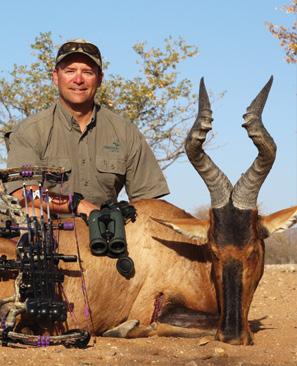
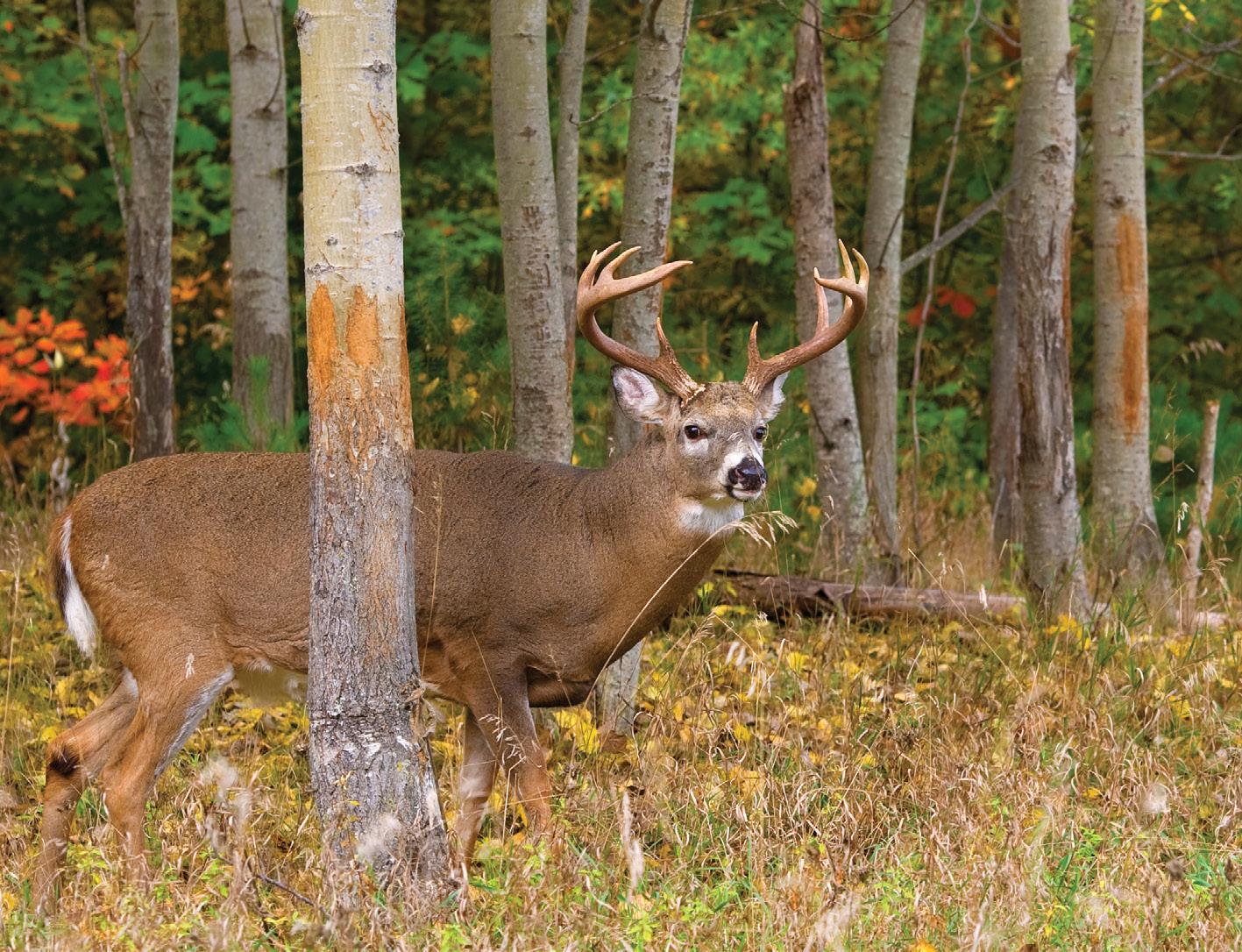
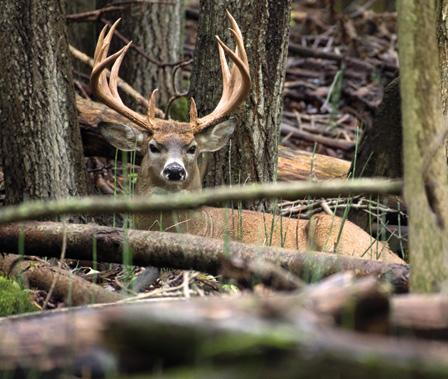 BY MARK RAYCROFT
BY MARK RAYCROFT
42
WINGS OVER THE WEST
From waterfowl, snipe and cranes to pheasant, grouse and partridge, the Prairie provinces offer wingshooters unparalleled opportunities
BY KEN BAILEY
48
FAMILY AFIELD
Don’t let having young kids keep you from outdoor adventures, including backcountry hunts. With the right planning, you can bring them along instead

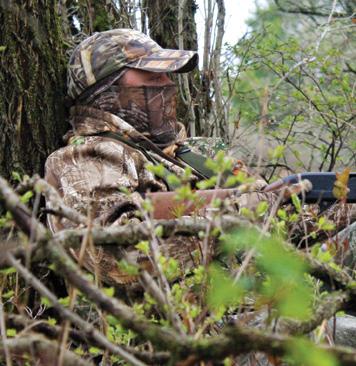
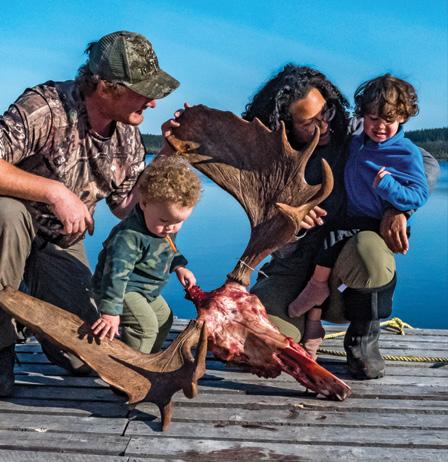 BY JIM BAIRD
BY JIM BAIRD
54
LOFTY GOAL
When you’re obsessed with sheep, the Yukon’s high country beckons. The tale of one hunter’s quest for a really, really old ram
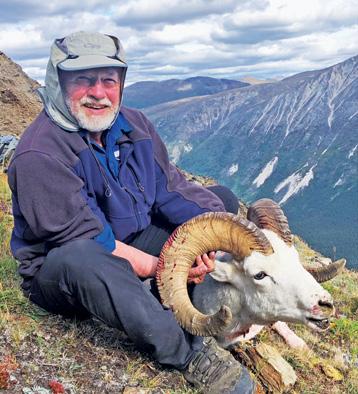 BY VERN PETERS
BY VERN PETERS
60
UP IN THE AIR
A primer on the challenge and thrill of hunting upland birds, waterfowl and small game with trained birds of prey
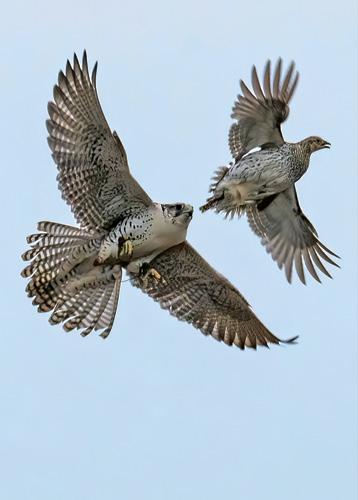
 BY RICK BRYNE
BY RICK BRYNE
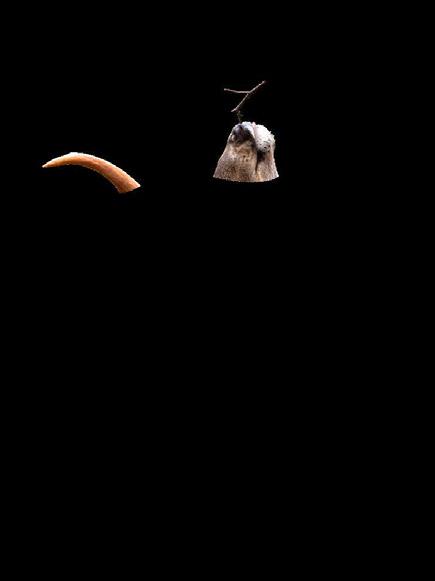
64
FORAGE FREE- FOR-ALL
How hunting down the prolific cisco can help you catch more giant walleye, lake trout, pike, bass and muskies this fall
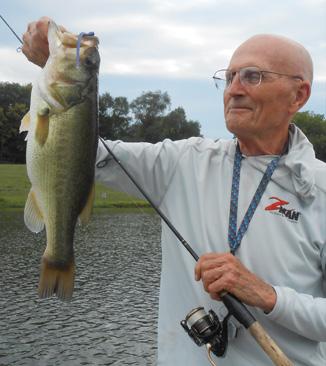
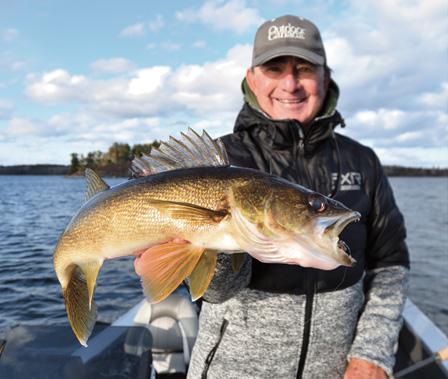
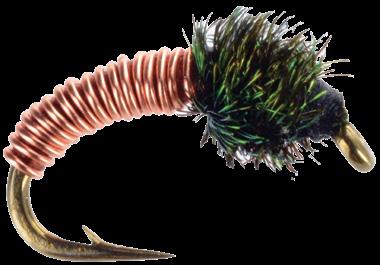 BY GORD PYZER
BY GORD PYZER
70
PRESSURE TACTICS
When fall’s angling hordes descend on your river’s most popular steelhead stretches, target these secret fish-holding spots instead
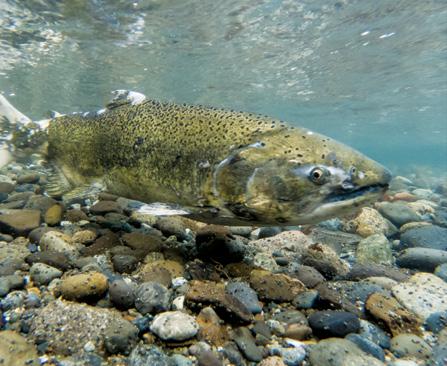 BY MIKE FITZGERALD
BY MIKE FITZGERALD
HUNTING SPECIAL VOL. 51, ISSUE 4 COVER LINES 24 Ned Rigs 26 Fly Rods 32 7 Giant Buck Clues 42 Western Wingshooting at its Best 48 Hunting Adventures with Kids 54 Trophy Dall’s Rams of the Yukon 60 The Allure of Falconry 64 Ciscoes 70 Steelhead COVER SHOT A WHITE-TAILED BUCK WETS THE LICKING BRANCH ABOVE HIS SCRAPE DURING LAST OCTOBER’S PRE-RUT IN SOUTHERN ONTARIO’S HARDWOODS.
BY MARK RAYCROFT DEPARTMENTS & COLUMNS 22 24 28 74 4 DISPATCHES Our readers write 8 OUTLOOK More prize-winning work BY PATRICK WALSH 1O JOURNAL Outdoor inspiration and information BY STAFF & CONTRIBUTORS 22 FAIR GAME The need for a new Pacific salmon recovery plan BY RYAN STUART 24 ON THE WATER Why shorter rods are best for fishing Ned rigs BY GORD PYZER 26 FLY FISHING Making the case for medium-action fly rods BY SCOTT GARDNER 28 BOWHUNTING Comparing compound bow draw weights BY KEVIN WILSON 30 IN THE FIELD How to ensure hunting access on private land BY KEN BAILEY 74 HOMAGE The sit BY MIKE FITZGERALD BONUS : NED RIGS • STEELHEAD • CISCOES • FLY RODS 7GIANT BUCK CLUES TROPHY DALL’S RAMS OF THE YUKON WESTERN WINGSHOOTING AT ITS BEST THE ALLURE OF FALCONRY HUNTING ADVENTURES WITH KIDS
PHOTO
32
WWW.OUTDOORCANADA.CA | 3 OUTDOOR CANADA [ HUNTING SPECIAL 2023 ]
MISSED THE MARK
T.J. Schwanky’s critique of recent changes to manage waterfowl hunting pressure in Manitoba contains errors and omissions (“Foreign fix,” July/August, West edition). And we strongly disagree with his assertion the changes were “more about optics than science.” In fact, these changes began decades ago based on surveys of resident hunters, increasing competition for access to waterfowl hunting, and a rare consensus between resident outfitters and hunters, to which the government responded.
Schwanky’s article downplays or omits several important trends, most notably the proliferation of U.S. hunters purchasing Manitoba land, with exclusive access to host guests on a paid and unpaid basis. Then there are the steps several U.S. jurisdictions have already taken to also restrict non-resident waterfowl hunters.
Schwanky bolsters his argument by citing Ducks Unlimited Canada’s opposition to Manitoba’s new measures, which he says is based on the principle of a shared resource and a thinly veiled threat of reduced U.S. funding for Ca-
nadian conservation. Let’s please keep in mind the precarious position DU is in, as many of the association’s major U.S. donors enjoy unfettered access to waterfowl hunting in Canada.
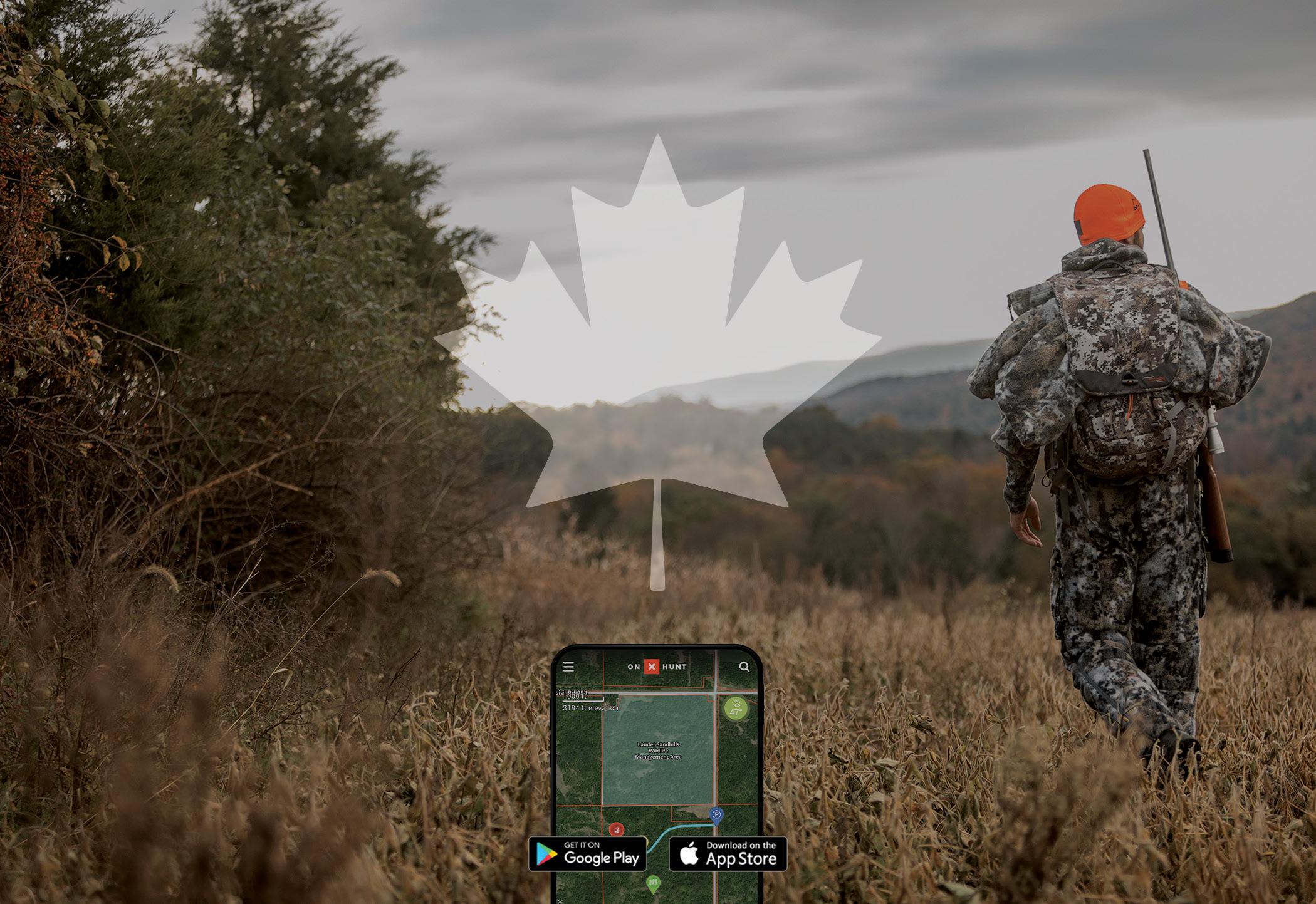
The initial steps Manitoba has taken represent compromise by all sides. Contrary to Schwanky’s implicit portrayal of resident outfitters as greedy, the Manitoba Lodges and Outfitters Association has, in fact, agreed to a nearly 50 per cent reduction in its overall numbers, and a cap on the number of foreign clients. At the same time, residents agreed to tolerate current levels of freelance foreign hunters and a grandfathering of foreign hunters who purchased land and exclusive access for their traditional hunting parties and family.
As the representative organization for resident hunters, the Manitoba Wildlife Federation would have preferred fewer foreign hunters, but we’re pleased with this outcome. It will benefit all parties, and ensure quality hunting opportunities for all, including visiting hunters.
While Schwanky acknowledges the problem and criticizes Manitoba’s response, he fails to offer an alternative. As a spectator, he may enjoy that luxury, but not in the arena of real-life problems requiring solutions. Manitoba has taken a very important initial step to address the number-one challenge facing current and future generations of resident waterfowl hunters—and for that we commend it.
CHRIS HEALD, EXECUTIVE DIRECTOR MANITOBA WILDLIFE FEDERATION
T.J. Schwanky replies: I appreciate this is a contentious issue in Manitoba, and all across the prairie provinces. You seem to have read much more into my column than was actually there. For the most part, I took a neutral approach, presenting the arguments from all sides for balance. I appreciate the MWF disagrees with many of those opinions, but for the most part I was just the messenger. Don’t shoot me! I do hope these measures increase resident access. OC
PLEASE E-MAIL YOUR COMMENTS TO EDITORIAL@OUTDOORCANADA.CA. ALSO CONNECT WITH US ON INSTAGRAM (@OUTDOORCANADAMAGAZINE), TWITTER (@OUTDOORCANADA AND @OUTDOORCANADAW) AND FACEBOOK (FACEBOOK.COM/OUTDOORCANADA).

OUR READERS WRITE DISPATCHES OUR READERS WRITE
8
ESTABLISHED
1972
EDITOR-IN-CHIEF & BRAND MANAGER Patrick Walsh
MANAGING EDITOR Bob Sexton
ASSOCIATE EDITOR & WEB EDITOR Scott Gardner
ART DIRECTOR Sandra Cheung
FISHING EDITOR Gord Pyzer

HUNTING EDITOR Ken Bailey
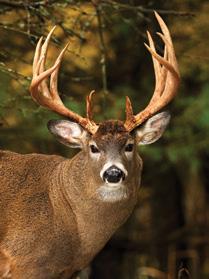
PUBLISHER Mark Yelic
NATIONAL ACCOUNT MANAGERS
Rosemary Bubanovich, Dave Harkley
RETAIL AND CLASSIFIED ACCOUNT MANAGER Chris Holmes
MARKETING MANAGER Desiree Miller
DIRECTOR OF RETAIL MARKETING Craig Sweetman
AD TRAFFIC COORDINATOR Michaela Ludwig
DIGITAL COORDINATOR Lauren Novak
CIRCULATION & CUSTOMER SERVICE
Marissa Miller, Lauren Novak
CONTROLLER Anthea Williams

OUTDOOR CANADA IS PUBLISHED BY OUTDOOR GROUP MEDIA LTD.

Outdoor Canada magazine (ISSN 0315-0542) is published six times a year by Outdoor Group Media Ltd.: Fishing Special; May/June; July/August; Hunting Special; November/December; and January/February.
Printed in Canada by TC Transcontinental.
SUBSCRIPTION RATES: Canada, one year (six issues), $24.95 plus tax. U.S., one year, $39.95. Foreign, one year, $69.95. Send name, address and cheque or money order to:
Outdoor Canada, 802-1166 Alberni St., Vancouver, B.C. V6E 3Z3



MAIL PREFERENCE: Occasionally, we make our subscriber list available to carefully screened companies whose products and services may be of interest to our readers. If you want your name removed, contact us via the subscripton contact below.




Publication Mail Agreement No. 42925023. Send address corrections and return undeliverable Canadian addresses to: Outdoor Canada, 802-1166 Alberni St., Vancouver, B.C. V6E 3Z3


USPS #014-581. U.S. Office of publication, 4600 Witmer Industrial Estates, Unit #4, Niagara Falls, N.Y .14305. U.S. Periodicals Postage paid at Niagara Falls, N.Y. Postmaster: Send address changes to Outdoor Canada, P.O. Box 1054, Niagara Falls, N.Y. 14304-5709. Indexed in Canadian Magazine by Micromedia Ltd.
EDITORIAL SUBMISSIONS: We welcome query letters and e-mails, but assume no responsibility for unsolicited material. Distributed by Comag Marketing Group. ©2023 Outdoor Canada. All rights reserved. Reproduction of any article, photo or artwork without written permission of the publisher is strictly forbidden. The publisher assumes no responsibility for unsolicited material.
Subscriptions and customer service: 1-800-898-8811
Subscriptions e-mail: service@outdoorcanada.ca


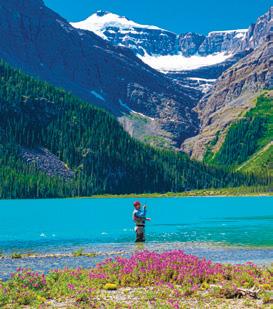
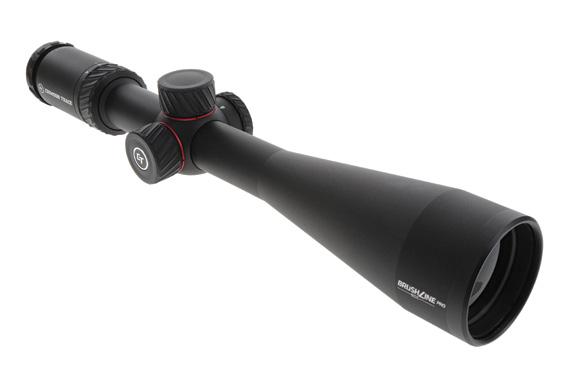





Customer service website: www.outdoorcanada.ca/subscribe

MAILING ADDRESS: Outdoor Canada, 802-1166 Alberni St., Vancouver, B.C. V6E 3Z3


















General inquiries: (604) 428-0259
Editorial e-mail: editorial@outdoorcanada.ca

Members of the Manitoba Wildlife Federation, Saskatchewan Wildlife Federation and Alberta Fish & Game Association must contact their respective organizations regarding subscription questions or changes.
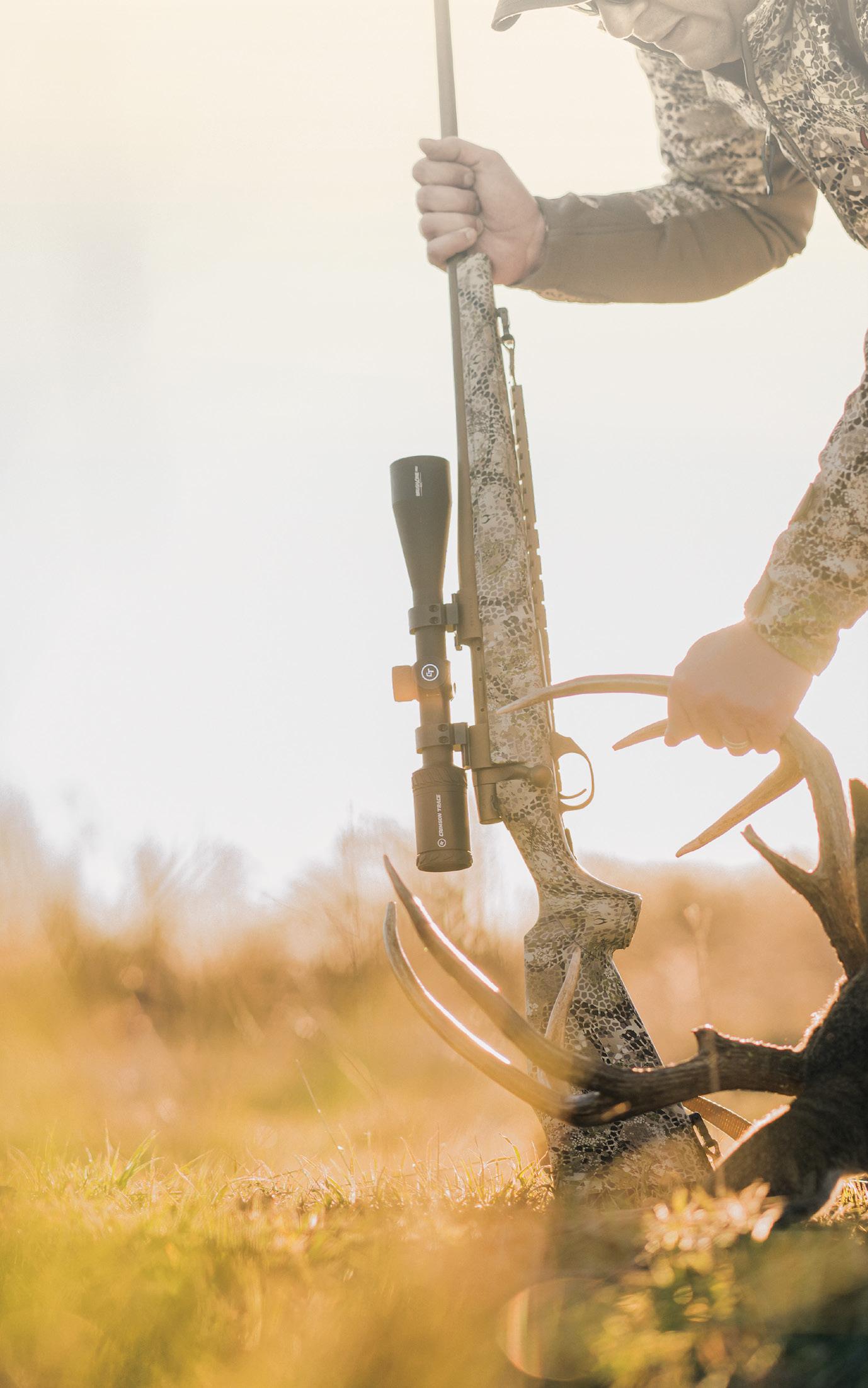
SEPTEMBER/OCTOBER 2023 GET OUTDOORS ALL YEAR LONG BONUS 50 PRO TIPS FOR HUNTING (& CATCHING) MUSKIES Hunting SPECIAL ISSUE HUNTING & FISHING MAGAZINE HOT SPOTS GUIDE 50 MOOSE CARIBOU MULE DEER MUCH MORE 2022 5MOOSECALLING ESSENTIALS TOP BUCK SECRETS FIELD STRATEGIES FOR DOWNING MORE DUCKS THE FORGOTTEN ALLURE OF GUNNING FOR SNIPE + 2022 FLY-FISHING BASICS CHANNEL CATS FISHING HATS 50HOT SPOTS! MUSKIES BASS WALLEYE TROUT PIKE SALMON PANFISH & MORE! ALL-NEW GEAR GUIDE CATCH MORE LEECHES MEET THE ORIGINAL IZUMI EXPERT FAVOURITES of Canada s Great Outdoors Celebrating SPECIAL 50TH ANNIVERSARY EDITION BONUS PHOTO CONTEST WINNERS REINDEER LAKE ADVENTURE FISHING & HUNTING MAGAZINE Order online outdoorcanada.ca/subscribe Call 1-800-663-7611 | service@outdoorgroupmedia.com MAILED RIGHT TO YOUR DOOR
HUNTING
DRYLAND DUCKS
www.outdoorcanada.ca
Top 50 whitetail tips
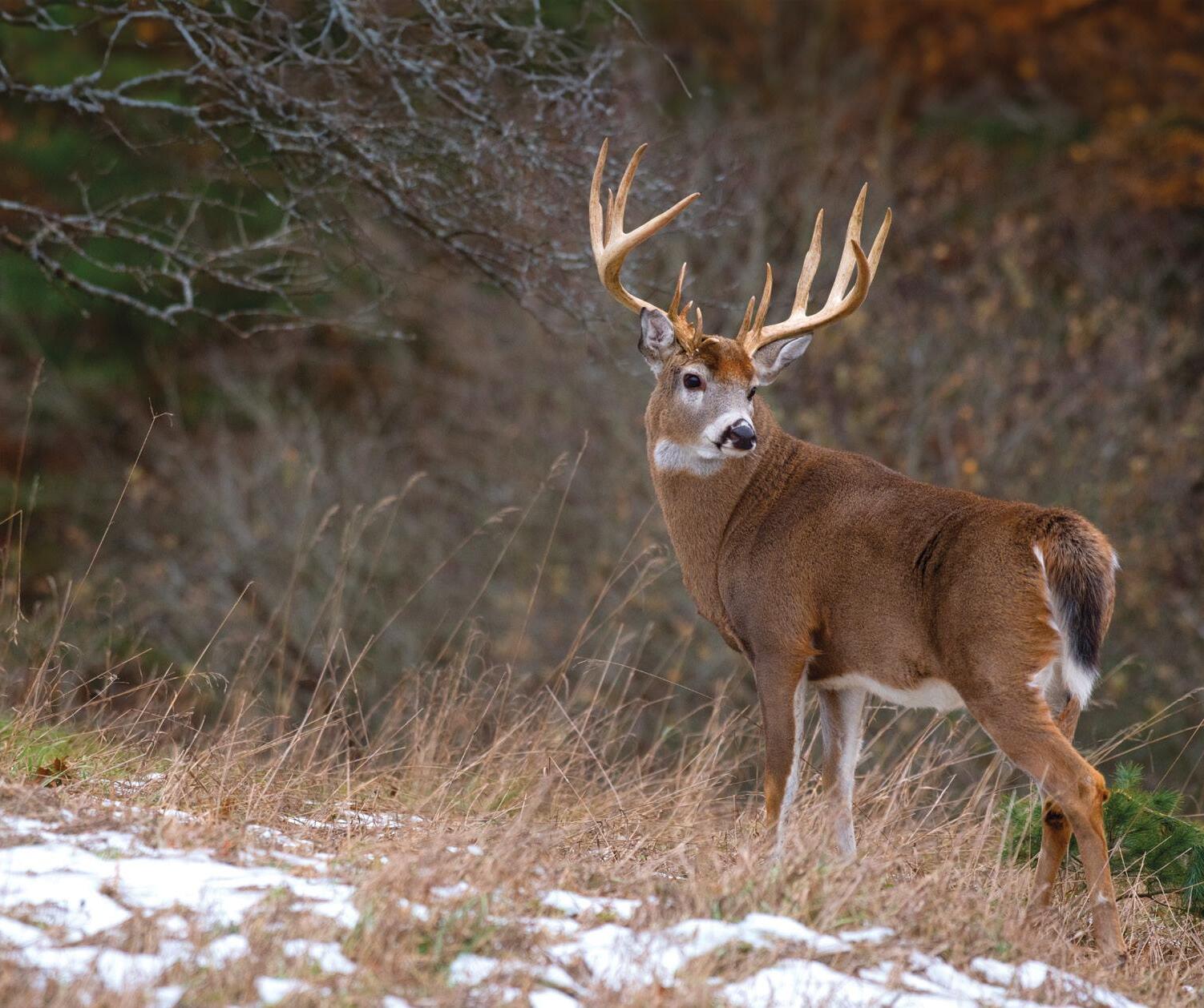
Outdoor Canada’s long-time hunting editor, Ken Bailey, shot his first white-tailed buck more than four decades ago during a classic spot-and-stalk encounter, hopscotching across a southern Alberta hayfield. Every fall since then, he’s been avidly pursuing Canada’s most popular big-game animal. His 50 all-time top tips for hunting big bucks include many of the lessons he’s learned along the way, complete with expert advice from hunting partners and seasoned guides. outdoorcanada.ca/50whitetailtips
CONNECT WITH US
Join us on Facebook Facebook.com/OutdoorCanada

Follow us on Twitter @OutdoorCanada @OutdoorCanadaW

Follow us on Instagram @outdoorcanadamagazine

Follow editor-in-chief Patrick Walsh on Twitter & Instagram @OutdoorWalsh


Follow associate editor Scott Gardner on Twitter @OutdoorGardner
Across Canada, agricultural fields can offer some great hunting for dabbling ducks. From scouting to decoying to choosing loads, this primer explains how to hunt these popular waterfowl on dry land. outdoorcanada.ca/drylandducks
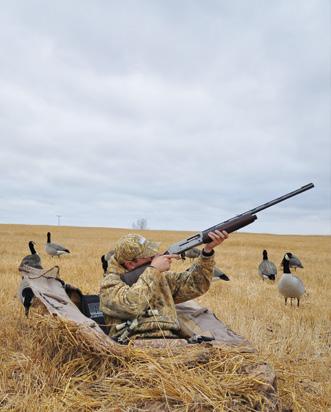
CALLING MOOSE
Calling moose isn’t overly difficult, but it does require some finesse. These five detailed scenarios explain where, when and how to produce the kind of sweet moose music that pulls in big bulls. outdoorcanada.ca/callingmoose
HUNTING SNIPE
Snipe may have fallen off the radar of most hunters, but the promise of a challenging and exciting day afield remains. Our expert pointers explain exactly how to hunt these fascinating shorebirds. outdoorcanada.ca/huntingsnipe
FISHING
MUSKIE SLAYERS
To tackle monster muskies, you need three essential types of lure. This primer explains the difference between diveand-rise lures, glide baits and twitch baits, along with tips on when and how to use them.

outdoorcanada.ca/muskieslayers
FALL PERCH
Autumn is the prime time for tussling with schools of jumbo perch—if you can find them. This detailed feature explains how to locate perch by first finding their forage, then using special rigs to seal the deal. outdoorcanada.ca/fallperch
ON THE WATER ONLINE
Outdoor Canada fishing editor Gord Pyzer regularly posts fishing tips, gear reviews and more on his blog, “On the Water Online.” Check in often to stay on top of exciting trends in the world of angling. outdoorcanada.ca/blogs
ONLINE NOW
6 | OUTDOOR CANADA [ HUNTING SPECIAL 2023 ] WWW.OUTDOORCANADA.CA

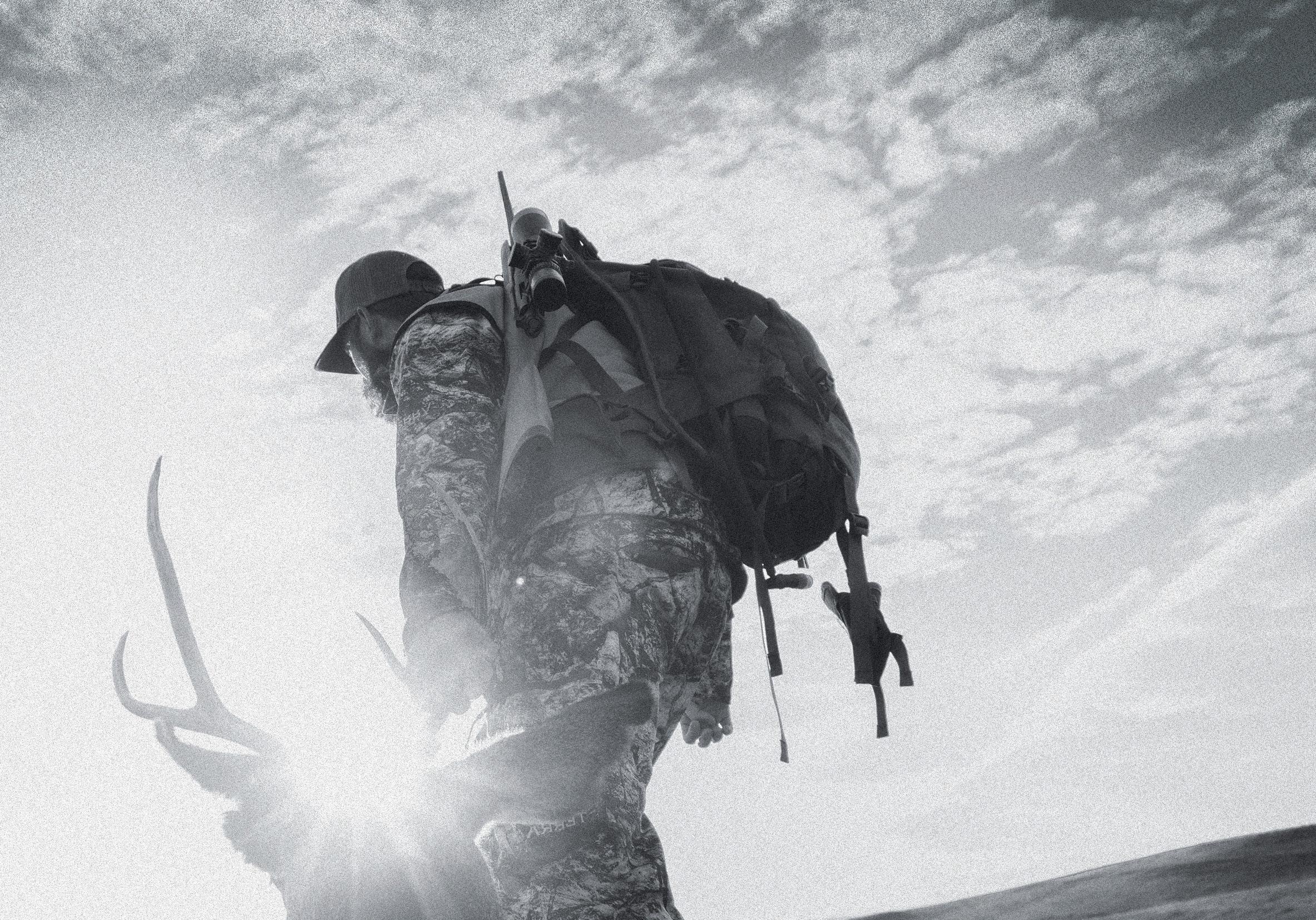

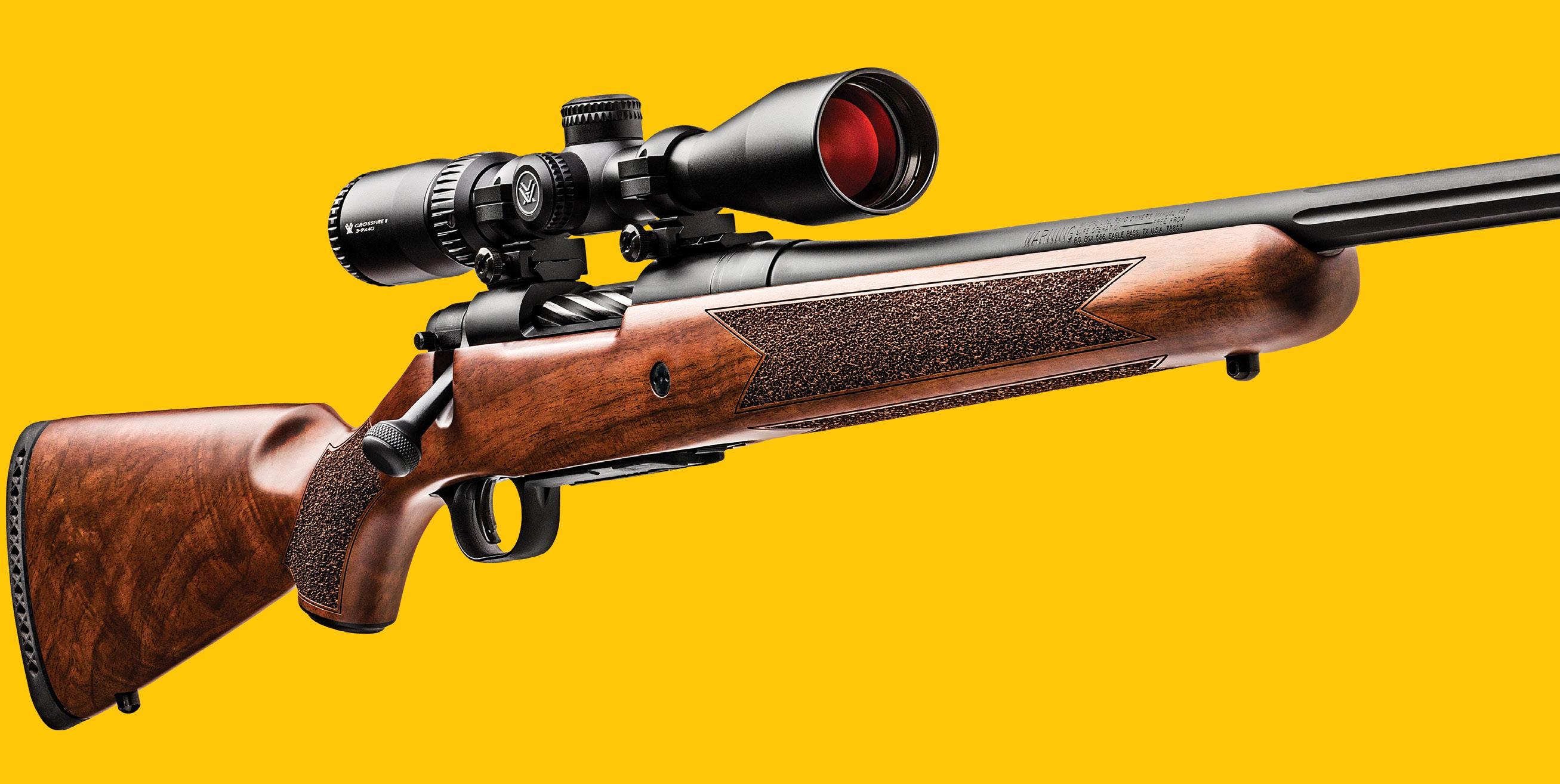
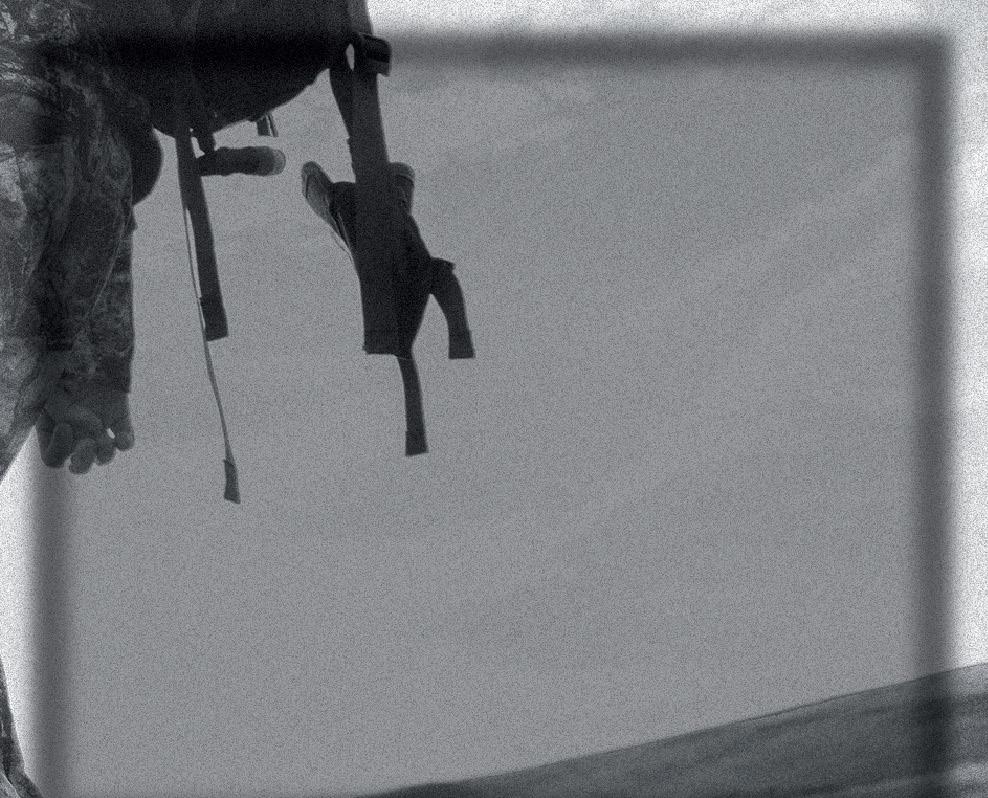


MOSSBERG | PATRIOT ™ RIFLES © 2023 O.F. Mossberg & Sons, Inc. RIFLES BUILT FOR THE LONG HAUL. SAFETY TIP Store firearms securely, inaccessible to children and unauthorized users. Consult and comply with any and all applicable federal, state, and local: laws, regulations, requirements, and/or restrictions, including but not limited to those regarding the purchase, ownership, use, transport, and carrying of a firearm. Not all products are available in all states and jurisdictions. SCAN CODE FOR MORE INFO u
ZEISS AUTHORIZED RETAILERS ONTARIO
TACKLE WORLD, SUDBURY
AL FLAHERTY’S, TORONTO
ELLWOOD EPPS SPORTING GOODS, SEVERN


GENERAL GUN AND SUPPLY, WINDSOR
TRIGGERS AND BOW, BURFORD
TILLSONBURG GUN SHOP LTD., TILLSONBURG
BULLS EYE SPORTS LONDON INC, LONDON

EAST HILL OUTDOORS INC., ORONO
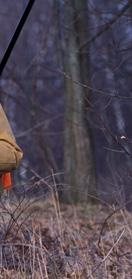
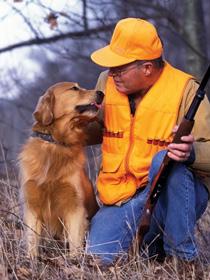

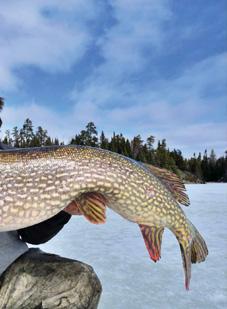
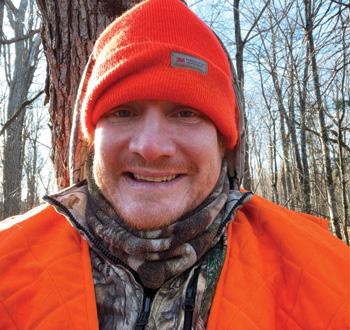
SOLELY OUTDOORS INC., MARKHAM














RANGEVIEW SPORTS, NEW MARKET
MANITOBA
MACDONALD'S SPORTING GOODS LTD, PORTAGE LA PRAIRIE
WOLVERINE SUPPLIES, VIRDEN
HEIGHTS ARCHERY AND HUNTNG, WINNIPEG
RAT RIVER OUTDOORS, ST-PIERRE-JOLYS
SASKATCHEWAN
TNT GUN WORKS, REGINA
NORTH PRO SPORTS INC, SASKATOON
EAGLE FIREARMS LTD., TISDALE













PREECEVILLE ARCHERY, PREECEVILLE
ALBERTA
P&D ENTERPRISES, EDMONTON
BASHAW SPORTS CENTRE, BASHAW
LAC LA BICHE SPORTING GOODS LT, LAC LA BICHE


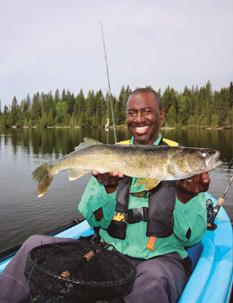
CANADIAN TIRE, CALGARY
WAREHOUSE SPORTS, ST PAUL
WOLVERINE GUNS & TACKLE, RED DEER COUNTY
BARTON'S BIG COUNTRY OUTDOORS, GRANDE PRAIRIE
TRAPPER GORD INC, DEBOLT
CALGARY SHOOTING CENTRE, CALGARY
PROPHET RIVER FIREARMS, LLOYDMINSTER
CANADIAN TIRE 634, LETHBRIDGE
FULCRUM OUTDOORS, FORT MACLEOD
SIGHTS AND ARMS LTD., ST. ALBERT
BACKCOUNTRY SUPPLIES, HARDISTY
LA CRETE HOME HARDWARE, LA CRETE
MURF'S OUTDOOR EQUIPMENT, SUNDRE
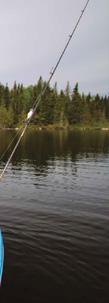
SYLVESTRE SPORTS, BONNYVILLE
Honoured work
EVERY YEAR, WE excitedly await the results of the Outdoor Writers of Canada’s annual National Communication Awards. I’m proud to say our staff and contributors typically fare well in this professional competition, and this year was no different. Yet again, work appearing in Outdoor Canada garnered the most honours (nine in total) of all media, testament to our ongoing commitment to creating a top-notch outdoor magazine.
This year, the awards gods smiled on three of our number in particular. Long-time contributor Mark Raycroft was aptly awarded for his considerable skill behind the lens, earning a first-place finish, two seconds and a third in the two photography categories (that’s one of his winning images, top right). Also see Mark’s contributor note, below.
On the writing side, meanwhile, associate editor Scott Gardner was our shining star, winning first (for “Winging it”) and second in the fishing feature category, and third in columns. And finally, perennial winner Gord Pyzer, our esteemed fishing editor, earned second in columns and third in fishing features (for “Pro pike ploys”). Nicely done, gentlemen! Thank you for making us shine.
I’d also like to congratulate all of this year’s other winners, as well as thank the judges and category sponsors (Tourism Saskatchewan, Shimano and our parent company, Outdoor Group Media). For a complete list of the winners, please visit: www.outdoorcanada.ca/2023owcawards. OC
CONTRIBUTORS
Along with the Outdoor Writers of Canada awards for his work in this magazine (see above), wildlife photographer Mark Raycroft and his wife, Pili Palm-Leis, also won second prize for best book: Caribou: Wind Walkers of the Northern Wilderness. Mark’s awesome photos can be found throughout this issue, starting on the cover.
Best described as a professional adventurer, Magnetawan, Ontario’s Jim Baird and his brother, Ted, were the season 4 winners of the History Channel’s reality-TV survival show Alone. Now he’s hosting Home in the Wild on Nat Geo TV, chronicling his young family’s adventures. See “Family Afield” (page 48) for his tips on trekking with tots.

A retired outdoor ed teacher, Vern Peters embarked on his first Yukon sheep hunt in 1972 with only a homemade sleeping bag, flimsy aluminum-frame pack and plastic sheeting for shelter. The Whitehorse resident has since gone on to enjoy many more quests for Dall’s sheep. He recounts one of his most memorable starting on page 54.


An avid hunter and angler, and the former owner of a retail sporting goods store, Rick Bryne is the current president of the Saskatchewan Falconry Association (SFA). A passionate falconer along with his wife, Gail, he’s been heading afield with his bird Hermione since 2015. On page 60, he shares the SFA’s primer on falconry.



OUTLOOK BY
PATRICK WALSH
8 | OUTDOOR CANADA [ HUNTING SPECIAL 2023 ]
HARDWATER SPECial 2023 PRO PIKE PLOYS-WINGING IT O BFebruary 2021, was clear COVID-19 restrictionstry lakes enjoy much. thought about my beloved fishing kayak, O beverages. But mostly, we were drinking in the B WINGING IT pointers and setters, meet of Canada’s most popular dog breeds for heading afield HUNT ’EM UP ’EM! night continHeading eld reaches whole buddy scouting wizard with
Reliability in everyday hunting. Even under the toughest conditions.
The Conquest V4 line of high-performance riflescopes combine the tried-and-true ZEISS optics concept with a rugged and functional design. Their compact design and perfect balance between a wide field of view and large magnification range is ideal for all types of hunting. The V4 models are equipped with a 4x zoom and functional, high-precision, and fully reliable mechanical components.







Distributed in Canada exclusively by Gentec International • gentec-intl.com gentec-intl.com/brands/zeiss Purchase any V4 Riflescope V4 RIFLESCOPES INSTANT REBATE PROMOTION RUNS Until September 30, 2023 See your Zeiss retailer for details. INSTANT REBATE $200 and receive
V4 Reticle Options Z-PLEX ZBi ZMOAi-T20 ZMOAi-T30 #60 #60 ZMOA T30
NUMBERS GAME
Square kilometres of habitat lost to wildfires in Canada as of June 26 alone, topping the annual record of 75,596 square kilometres set in 1989, according to the National Forestry Database. As Canada reached the grim milestone, 490 fires were burning across the country. At press time, there were 885 active fires.

76,129 $10,000
Total fines levied against a northern B.C. fishing charter operator for feeding and interacting with wild seals to entertain paying guests. Curtis Malcom Ireland maintained he didn’t know it was illegal under the federal Fisheries Act to disturb marine mammals.

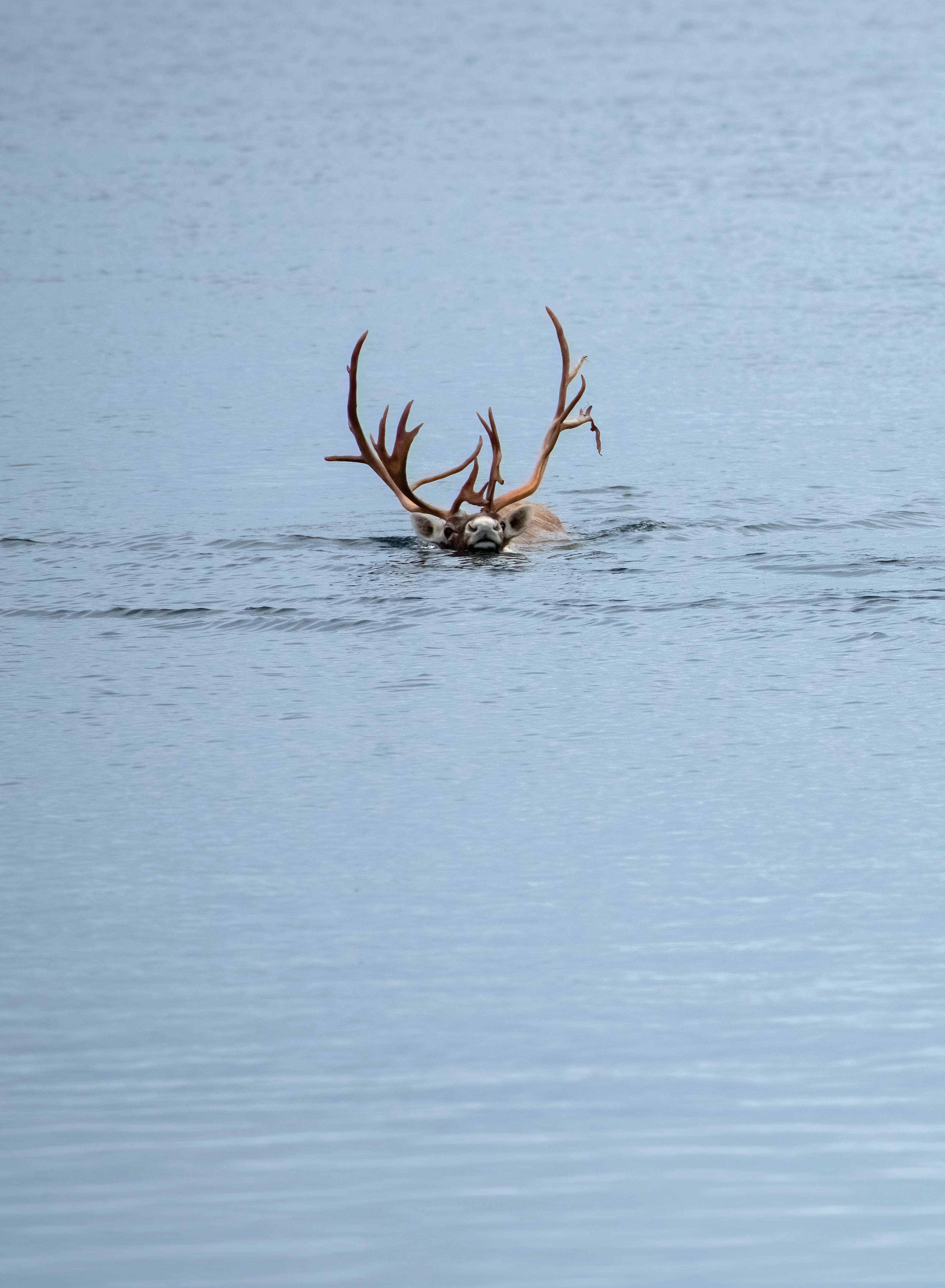
$173 million
Money developers spent in June to buy 212 hectares of once-protected land in southern Ontario. The property lies entirely within a preserve considered the crown jewel of the ecologically important Greenbelt, part of which was opened to development last fall by Premier Doug Ford’s government.
10 | OUTDOOR CANADA [ HUNTING SPECIAL 2023 ]
OUTDOOR INFORMATION & INSPIRATION
JOURNAL
SCENE
Wait up, ladies! Showing that woodland caribou are excellent swimmers, a large bull follows his harem across an Atlantic Ocean cove in the wilds of Newfoundland during last October’s rut.
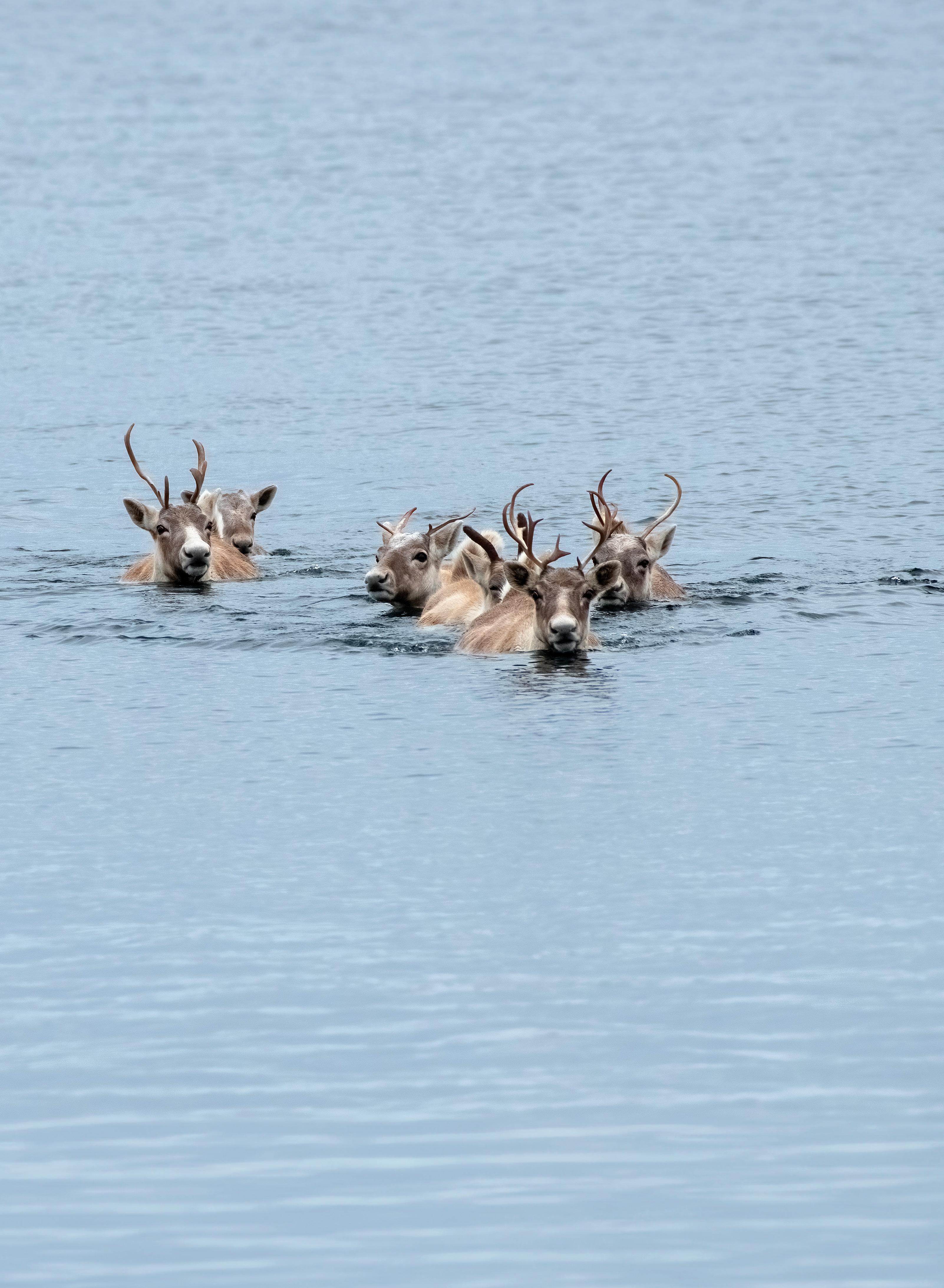
ON THE RECORD
22,000 30,000
Sockeye salmon expected to have returned to the Yukon’s Alsek River as of September, marking the second year in a row for an aboveaverage run. Fisheries managers are pleasantly perplexed about the reasons for the increase, considering they predicted only 11,000 fish would return.

Hectares of privately owned Alberta grasslands and wetlands to be conserved through an agreement with the Nature Conservancy of Canada and Ducks Unlimited Canada. Once completed, the pact with 130yearold McIntyre Ranch will represent the largestever conservation project on private Prairie property.
gonna grow up and have lots of babies.”
—Fort Nelson B.C.’s Mark Skage defends his decision to let an abandoned moose calf climb into his truck to escape a nearby black bear. Skage was later fired from his job at AFD Petroleum Inc. for breaking the firm’s wildlife protocols. “Her babies will have babies,” he told CBC News, citing the conservation aspect of his decision.
“I think it’s a positive. I believe that in my heart.”

WWW.OUTDOORCANADA.C A | 11
“She’s
PHOTO BY MARK RAYCROFT
TUBE TIPS
GRUNT LIKE THE REAL DEAL TO TRICK WARY WHITE-TAILED BUCKS
 BY MIKE HUNGLE
BY MIKE HUNGLE
CALLS CAN BE productive when you’re hunting white-tailed deer, and one of the best options is the grunt tube. With its deep guttural sounds, it can be used to both attract bucks and stop them in their tracks. Here’s how to make the most out of this versatile call.
MIND THE WIND When choosing a location to call from, the wind direction is key. Incoming bucks will be on the alert looking for other deer, and they’ll almost always circle around downwind. With that in mind, find an area that offers an adequate downwind shooting lane. When hunting with a partner, have the shooter set up 50 metres downwind from the caller.
GET THEIR ATTENTION Start calling by making two or three short grunts every 15 to 20 minutes, which serves to announce your presence. If any bucks are within earshot, the chances are good they’ll come to investigate. Stop calling once you know a buck is coming in, as you’ve already got his attention and he wants to find you. If he loses interest or starts to move away, however, call again. This time, make only one or two soft grunts, with the tube pointing away from the buck. That way, it will seem like you’re moving away from him.
MAKE THEM PAUSE During the rut, bucks will quickly trot along with their nose to the ground following the trail of a doe. They’ll generally be moving too fast for a good shooting opportunity, however, so you need to make them briefly stop. To get a buck to pause, place your grunt tube in your mouth and raise your gun or bow. Then once the buck is in range and you have a clear shot, give the tube a quick toot. That will often make him freeze, giving you a chance at a stationary target. Just be quick, though, since the buck won’t stand still for long.
BRING THEM IN If you see a distant buck, but he’s not coming your way, try hailing him down with a single, two- or three-second-long grunt to get his attention. Often, that will bring the buck straight toward you. If he doesn’t come, try again, making your hail call louder and longer. Once the buck decides to head your way, stay quiet and don’t call unless he stops.
AVOID FREEZING UP One last tip: If you’re hunting and it drops below 0°C, you’ll quickly find that your grunt tube will freeze up. To avoid that, turn the call around and inhale through it instead to make grunts. OC
IN SEASON
BLACK BEARS
Hunters often overlook fall black bears in favour of ungulates, but bear meat and hides are at their best late in the year. Since they’ll be in a feeding frenzy of sorts fattening up for winter, bears near agricultural lands will feed heavily on grains, especially oats, as well as fruits where available. Forest bears, meanwhile, will focus on berries and nuts. Find where they’re feeding—scat is good evidence— then set up with a favourable wind, wait and let them come to you. When hunting in big country, glass for bears in burns and clearcuts with nearby heavy timber, or on the north-facing slopes of drainages where you have good sight lines. Throughout early fall, daytime temperatures can be warm, so hunt the shoulder hours. As temperatures cool, however, bears will become more active throughout the day. Since these predators are opportunistic feeders, calling can also produce in the fall.
 BAILEY
BAILEY
WALLEYE
My good friend and professional angler Derek Strub is widely acclaimed for his bass-fishing prowess using a drop-shot rig, so it’s probably no surprise

he uses the same rig to catch walleye in the fall. Unlike most drop-shot anglers, however, Strub never spools his spinning reel with braided line. Instead, he opts for fluorocarbon—and for a truly fascinating reason. Since super-lines are so sensitive and don’t stretch, he says, it’s easy to overwork your baits, which turns off neutral and negative walleye. Fluorocarbon, on the other hand, provides just the right amount of elasticity and absorbs the tiniest amount of perceptiveness to help you land more and bigger fall walleye. And when you drop-shot with fluorocarbon, adds Strub, you tend to give the walleye an extra second or two to get the bait well inside their mouth. —GORD
PYZER
TAG OUT WITH A STRATEGIC GRUNT OUTDOOR SMARTS
JOURNAL
12 | OUTDOOR CANADA [ HUNTING SPECIAL 2023 ]
MIKE HUNGLE (TROPHY DEER); KEN BAILEY (BLACK BEAR ); DEREK STRUBB (WALLEYE)
—KEN
TROPHY WALL
HOT SHOTS
PHOTOGRAPHIC MEMORIES OF FUN DAYS AFIELD AND ON THE WATER
WE ENJOY SEEING pictures of your fishing and hunting accomplishments—and learning the stories behind them. Please e-mail us your images, along with any relevant details (who, what, where and when), and we’ll post them on Instagram and publish our favourites here.
Corey Chase slipped out for a quick hunt on his family’s farm in Anagance, New Brunswick, after Thanksgiving dinner last October when he arrowed this dandy 10-point white-tailed buck. “I was starting to believe this deer was unhuntable,” he says, noting he’d been actively pursuing it for three seasons.

Thunder Bay, Ontario’s Stephane Hunt was moose hunting just outside his hometown last October when he knocked down this monster bull. On hand to share in the moment were his hunting buddies Allan Wing, Ben Belanger and Allen Dyck. The impressive antlers stretched the tape to 601⁄2 inches.



Last September, Levi Trask shot this trophy moose exactly one year after his brother, Marin, took a bull in the same area near Hinton, Alberta. “To say I was excited is an understatement,” says the Meadow Lake, Saskatchewan, hunter, noting the giant rack measured 583⁄4 inches across.
Featuring a unique double throat patch and a split ear, this typical mule deer earned Nick Henry a place in Boone and Crockett’s record book with a score of 182 0⁄8. The Prince George, B.C., hunter took the deer near Churn Creek, also garnering him a spot in B.C.’s provincial wildlife records. OC
WWW.OUTDOORCANADA.CA | 13
8PLEASE E-MAIL YOUR PHOTOGRAPHS AND RELEVANT DETAILS TO EDITORIAL@OUTDOORCANADA.CA. ALSO BE SURE TO CHECK OUT OUR INSTAGRAM PAGE: @OUTDOORCANADAMAGAZINE.
NEW BLOOD

TO AVOID A CONSERVATION CRISIS, WE NEED MORE YOUNG HUNTERS
 BY ROBERT PYE
BY ROBERT PYE


HUNTERS BRING IN


waterfowlers and duck stamp collectors. As a result, I believe we could reach a conservation crisis.
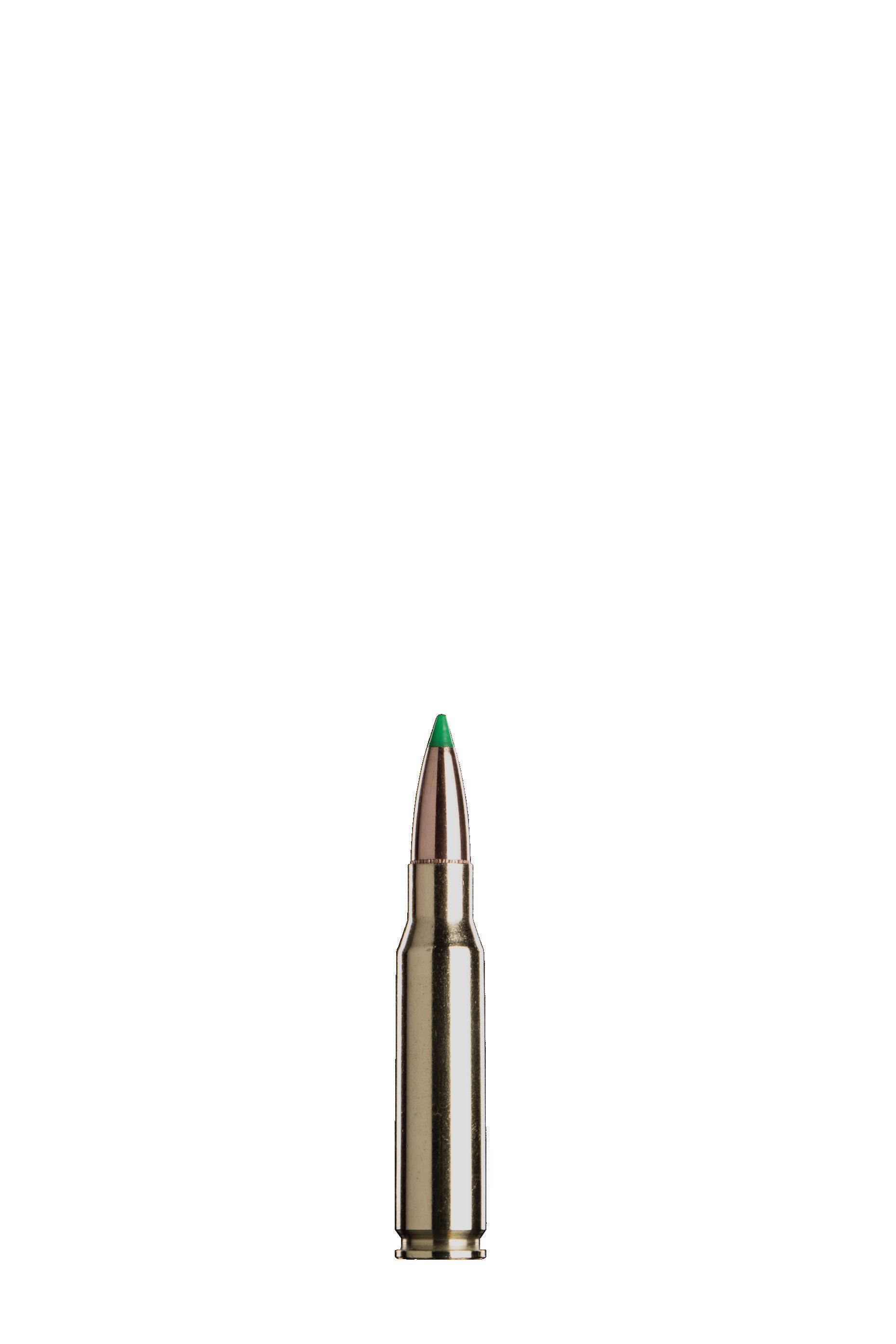
Through their outdoor passion, hunters contribute to conserving marshes and shorelands that support biodiversity, capture carbon and help prevent floods. But fewer hunters means fewer dollars for the likes of Ottawa’s already underfunded migratory bird stamp program, which pays conservation bills. In the wake of climate change and the more-homesbuilt-faster mantra, we simply need to find creative ways to recruit more new hunters to our ranks. The good news is, governments and hunting organizations are already aiming for such
Free migratory bird hunting permits for youths aged 18 and under, introduced last year by the Canadian Wildlife Service, is perhaps the single-most progressive new move toward water-
EASTERN VIEW
R F LAT L R TAKE R R U BB R U BB ED L E C A NC ELE B OOM ST VI TAM E R ASE R SEASO N O FFIN N A I EAPE R HEA R S E P MEAT ON THE TA WI DO W RIV E R E R ASE RIV E R O F F S WI T C H ® C M Y CM MY CY CMY K 2023 Nosler BT Ammo Half page Ad 7x4.8125.pdf 1 7/20/2023 9:15:47 AM
fowler Heritage Day. I’d like to see this approach also applied at the provincial level for youth hunting licences.
No doubt, the feds in charge of migratory bird hunting see the potential trajectory. Losing sales that they never had to begin with is a smart move to possibly recruit new lifelong waterfowl hunters—the best hope to restore funding to Wildlife Habitat Canada’s oversubscribed conservation grant program. (By the way, the price of the duck stamp has not changed in 32 years, so seasoned hunters can’t cry foul about getting nickel-and-dimed.)

EASE OF ENTRY



Busy family schedules and tight budgets often stop hunting in its tracks before it can even be discovered. Online hunter education courses

bedroom—conveniently between his hockey and school schedules—for just $60. Such fast and affordable services for busy families will surely help move the needle on hunter recruitment. In fact, I think it will ensure a growth rate the hunting community hasn’t witnessed since the legal hunting age was lowered from 15 to 12 in some provinces.
CULTURE OF INCLUSION
Signs that new hunters are welcome often surface during volunteer events at local gun clubs and so on, with photo ops for the dozen or so kids in attendance (many of whom already come from hunting families). Before these future hunters even get home, however, how many veteran hunters age out of the conservation ranks instead? No, a net gain for hunting will
Despite the naysayers, what we need now are more once-impossible dreams, such as hunter apprenticeship programs, new hunting seasons, Sunday gun hunting, expanded archery opportunities, online hunter education, and tags available for purchase by apprentice hunters rather than forcing them to share their mentors’ tag.


I also think it’s time to let kids enter deer and moose draw systems in my home province of Ontario. New hunters are just as qualified as any other accredited hunter, and in my deer woods, no one deserves a crack at filling a doe tag more than a young gun.





Touting the take-a-kid-hunting messaging only works when the hunting system we deal with is equally forward-thinking and ambitious. Meanwhile, new and veteran hunters alike

BURRISOPTICS.CA
Well known for integrating powerful rangefinders into optics, Burris introduces the Signature 10x42 LRF binocular for fast and precise ranging from 5 to 2600 yards. Ultrasharp HD glass & an easy-to-read display offer comfortable glassing & blazing fast ranging for both hunters & shooters.
BULL SECRETS
FALL TACTICS FROM THE MAN WHO WROTE THE BOOK ON MOOSE HUNTING
BY BOB SEXTON
ALONG-TIME HUNTING guide and outdoor personality, Thunder Bay, Ontario’s Jon Remus takes both science and his personal experience into account when scouting and hunting. “If you keep your mind, ears and eyes open on every trip outdoors, you’ll definitely learn something new every time,” says the host of YouTube’s Venture North Outdoors Show. Recently, the 58-year-old published the book Hunting Woodland Moose: Canadian Guides Share Their Secret Tips, a compilation of top moose-hunting tactics. We asked him to share his own top secrets for hunting big fall bulls.
SCOUTING One of the keys to moose-hunting success is year-round scouting, says Remus. “I love the old football coach saying that luck is where preparation meets opportunity,” he says. “Is it luck that you’re in the right spot at the right time because you did the right scouting and found the most active moose track? No.” Remus recommends using Google Earth to study the area you’re planning to hunt, and casting a wide net to get intel from various sources. “All summer long, ask fishing outfitters, road crews, fishermen and pilots where they’ve seen cows feeding,” he says. “Cows bring the earliest, prime bulls.”
HABITAT According to Remus, the best spots to hunt prime bulls are back bays, in particular where they empty into creeks lined with golden grass as they flow into mixed hardwood forests. Areas recovering from wildfires are also very productive. “If you want some of the most fantastic moose hunting ever, go to a seven-year-old forest fire area,” he says, adding that such regions are productive because of new tree growth, especially poplar. “When the trees reach 12 to 14 feet high, they’re still only three inches in diameter. I call them jail bar poplar because they look like jail bars. Still, they provide full cover for the moose, and every one of those trees is a food source.”
CALLING The biggest mistake hunters make is to not impart a sense of emotion in their calls, Remus says. “They listen to an instructor or tape or read about sounding it out, but the emotional part of it is the wavering, the change in how much air you push out,” he says, noting many hunters achieve a certain tone, then simply hold it, leaving out the emotional wavering. “If I’m the cow and I’m exposing myself to my enemies—wolves, bears or mountain lions—I’m letting you know I’m not in heat for four months,” Remus says. “There’s an urgency to the call.” At the same time, you should start off with soft and quiet calls. “Whether it’s a dawn or dusk sequence, you don’t get louder and louder, then go home,” he says. “It’s a climax up and down over a period of time.” OC
DOG SENSE
GO FETCH!
For the most part, gun dogs love retrieving because it pleases their handlers and fuels their desire to hunt. Sometimes, though, a dog will refuse to fetch due to factors such as freezing water, foul-tasting birds and fatigue. To prevent this, use the conditioned retrieve training drill to teach your dog there are consequences for non-compliance. It’s not easy, quick or fun, but the end result is a reliable retriever. Here’s how to make sure the “fetch” command consistently results in a retrieve.
THE DRILL
Though not essential, this drill initially works best on a training table because the raised platform simplifies the process. The primary gear includes a thick wooden dowel (about 20 centimetres long), a leash, training bumpers and, ultimately, frozen and live birds. Start by practising the “hold” and “give” commands for a few days, and praise the dog for successfully obeying. The next step involves ear pinching to get the dog to grab the training dowel (toe-hitching or stimulus from an e-collar can also work). Simply press the dog’s ear against the collar buckle, command “fetch” and the dog will sooner or later open his mouth. When that happens, pop the dowel in his mouth and immediately stop pinching the ear. Then command “hold” (with praise), before ending with the “give” command. Repeat this drill over several weeks until the retrieve conditioning is complete. Ultimately, the dog should learn to avoid an ear pinch by automatically picking up the dowel whenever he hears the “fetch” command.
THE PROGRESS
Once your dog is consistently picking up the dowel on the training table, it’s time to incorporate short and long retrieves on the ground. Toss the dowel a short distance, then command “fetch.” Keep the dog on a check cord, and if he refuses to fetch, bring him back and pinch his ear while leading him to the dowel. Once the dog is consistently returning the dowel, start using bumpers instead, followed by real birds. —LOWELL

 STRAUSS
STRAUSS
JON REMUS (REMUS)’; LOWELL STRAUSS (DOG)
FOR THE BEST TIMES TO FISH AND
OUR SOLUNAR CHARTS AT WWW. OUTDOORCANADA.CA/TIMES. 8
HUNT, CONSULT
8
LEARN MORE ABOUT JON REMUS AND HIS BOOK ON MOOSE HUNTING AT WWW.VENTURENORTHOUTDOORS.COM.
FIELD GUIDE
JON REMUS SAYS PREPARATION IS KEY TO SUCCESS
16 | OUTDOOR CANADA [ HUNTING SPECIAL 2023 ]
DUCK RISOTTO
BREASTS PAN-SEARED TO TASTY PERFECTION, AND SERVED WITH SAVOURY BLACKBERRY JUS
RECIPE & PHOTO BY CAMERON TAIT
THERE’S NO BETTER time to serve wild duck than right after a successful day’s hunt. Unlike geese, duck requires little time to prepare and marinate, and it can be cooked to medium or even medium rare. And paired with this creamy risotto and light blackberry jus, it’s sure to rival the delicious offerings of the finest restaurants. Serves 2

1] Place the breasts in a container with the olive oil, zest and pepper; refrigerate for 24 hours.
2] Blend all the sauce ingredients (except the slurry) in a small saucepan and place over medium heat for 20 minutes. Add the slurry and stir to prevent lumps, then bring to a simmer before removing from heat. Push mixture through a fine strainer, then set aside.
3] Remove the breasts from the fridge, wipe off the zest and let sit at room temperature while cooking the risotto (next step).
5] In a small saucepan, melt the butter over medium heat, then add the onion and sweat until translucent. Add the rice (only use arborio for risotto) and stir for 1 minute to coat in butter, then add the wine and stir to combine. Reduce for one minute, then turn heat to low.
6] Add the chicken stock ¼ cup at a time, stirring occasionally. When all the stock is added, check to make sure the rice is tender; if not, add another ¼ cup stock. Add the cheese and parsley, then salt and pepper. Remove from heat and cover.
7] In a non-stick pan over medium heat, add a small amount of olive oil then place the breasts skin side down. Sear for three minutes on the first side, then turn over and continue cooking until the internal temperature reaches at least 130°F for medium rare (approximately 3 to 5 minutes, depending on the size of the breasts).
8] Remove the breasts from the pan and rest on paper towel for 5 minutes; in the meantime, gently reheat the sauce and risotto.
9] Thinly slice the breasts against the grain, place on the risotto and drizzle with the sauce. Serve immediately with seasonal vegetables. OC
• 2 duck breasts, skin on
• 2 tbsp olive oil
• Zest of 1⁄2 orange
• Pinch fresh ground black pepper
BLACKBERRY SAUCE
• 6 oz fresh blackberries
• 1⁄4 cup balsamic vinegar
• Juice of one orange
• 1 tsp vanilla extract
• 2 tbsp maple syrup
• Pinch kosher salt and pepper
• Slurry (1 tsp cornstarch, 2 tsp cold water)
RISOTTO
• 2 tbsp salted butter
• 1⁄4 yellow onion, small dice
• 2⁄3 cup arborio rice
• 1⁄4 cup white wine
• 2 cups chicken stock
• 1⁄4 cup grated Parmesan cheese
• Pinch chopped parsley
• Salt and pepper, to taste
TABLE FARE TO WATCH CAMERON TAIT PREPARE HIS VARIOUS DISHES, GO TO WWW.OUTDOORCANADA.CA/FOOD. 8
WWW.OUTDOORCANADA.CA | 17
MADE TOUGH
A BROWNING AND ZEISS COMBO FOR THE RIGOURS OF MOUNTAIN HUNTS
BY MARK HOFFMAN
HUNTING MOUNTAIN GAME is addictive, and you never leave the high country unchanged. There’s just something about those lofty alpine vistas that reaches down into your soul and forever etches into your memory. My first mountain hunts date back to an era when the concept of mountain rifles was only a figment of our collective imagination. We all had visions of what such a rifle might look like, but unfortunately, a commercially made model did not exist at the time. But that was then. Today, our options are vastly improved, with many of the major firearms manufacturers now marketing mountain rifles.
Prominent among them is Browning, and one of the newer additions to Browning’s well-built and very popular X-Bolt line of rifles is the Mountain Pro Long Range. While this is a production rifle, it includes several features normally associated with more expensive custom models, leading Browning to refer to it as a “semi-custom” rifle. This includes specialized finishing touches and higher-end construction materials.
Let’s start with the true carbon-fibre stock. It’s filled with noise-dampening foam, making for a more rigid and lightweight stock than you’d find on previous models, such as the X-Bolt Pro. The stock also features a slimmer forend, a slight palm swell on the grip and a splotchy, two-tone Cerakote finish, all adding to the rifle’s overall aesthetic appeal.
Moving on, the stainless-steel barrel and action feature a Cerakote Burnt Bronze finish, and the barrel is lapped for consistent accuracy and easier bore cleaning, with no break-in required. The spiral fluted, 26-inch, heavy sporter contour barrel also features a threaded muzzle and a Hawg muzzle brake, which promises to reduce recoil by 76 per cent. Then there’s the spiral fluted bolt, also with a rust-resistant Cerakote Burnt Bronze finish.
What truly separates the Mountain Pro from previous X-Bolt Pro models, however, is that it weighs a quarter of a pound less. At six pounds 12 ounces, in fact, it’s lighter than many standard sporter rifles, even with its 26-inch heavy sporter barrel.

As for standard X-Bolt features, it includes a free-floated barrel bedded in the front and rear of the action to maintain barrel-to-stock spacing for consistent accuracy. It also has a bolt unlock button for improved safety during unloading, a short 60-degree bolt lift, a detachable rotary magazine, a three-lever
Feather Trigger, an Inflex recoil pad and, finally, an X-Lock scope mount system that utilizes four screws per base rather than the standard two.
TEST RESULTS
After unboxing my Mountain Pro test model, my immediate question was, is this a mountain rifle or not? Well, the answer depends on your definition of what constitutes a mountain rifle.
Considering its 26-inch heavy sporter barrel, I don’t see myself hunting mountain goats or sheep with the Mountain Pro anytime soon, but that’s not to say it doesn’t have its place in the mountains. This is a well-built rifle that can certainly withstand the rigours of a mountain hunt, making it right at home in any high-country cut block or flatland hayfield where a long-range shot is in the offing.
As for the rifle’s overall appearance, I liked the combined look of the slimmed-down styling of the stock, the clean lines, the two-tone finish on the stock and forend, the spiral fluted barrel and bolt, and the Cerakote Burnt Bronze finish on the barrel and action. I also appreciated the Mountain Pro’s muzzle-forward balance, no doubt provided by the long, heavy sporter barrel.
For my test, I attached a Zeiss Conquest V4 6-24x50 scope (see next page), torquing all eight Browning X-Lock scope mount screws to 15 pounds. On a postal scale, the combo weighed in at nine pounds two ounces. Next, I checked the trigger pull weight, which was at three pounds 14 ounces. That was a bit heavier than I like, so I adjusted it down to three pounds, where it provided a consistent no-creep break. Finally, I measured the length of the magazine to ensure none of my handloads were too long; I was able to seat all my loads within 0.015 inches of the lands without exceeding the 2.9-inch length.
On the range, my evaluation was broken into two sessions. I first shot a variety of handloads, factory hunting ammo and factory match ammo at 100 yards. I then evaluated the 300-yard potential of the top three 100-yard hunting ammo performers. While my handloads delivered consistent MOA type accuracy at 100
JOURNAL
MARK
HOFFMAN (SHOOTER, TARGET); BROWNING (RIFLE); ZEISS (SCOPE); KEN BAILEY (MILK RIVER RIDGE, WHITESHELL REGION); BIG MOOSE CAMP (MUSKIE)
JOURNAL FIREARMS REVIEW A GREAT CHOICE FOR HIGH-COUNTRY CARIBOU OR ELK 18 | OUTDOOR CANADA [ HUNTING SPECIAL 2023 ]
yards with an overall average of 1.039 inches, the results were not what I expected. Not one group approached or bettered a half-inch, while a couple of the factory hunting and match ammo loads did. In fact, Hornady Match 120-grain ELD Match fell just shy of that mythical quarter-inch group. Actually, the rifle liked all of the factory match ammo, with a combined average of 0.538 inches. At 300 yards, meanwhile, Winchester Expedition Long Range 142-grain AccuBond LR separated itself from the pack with a 1.39inch group (pictured at right).
Also well worth noting was the lack of felt recoil, akin to shooting a .222 Remington; no doubt the Hawg muzzle brake and the weight of the rifle itself were significant contributors. While very effective, the Hawg was extremely loud, so be sure to wear good hearing protection. What also stood out was the optical quality of the Conquest V4. With the magnification set at 24x, the details on my 300yard targets were so well defined I was able to make quick and precise deadon holds. That’s ideal for long-range
THE CONQUEST V4
Having already been very impressed with the optical quality of the Zeiss Conquest V4 scope, this latest V4 with its new reticle and 6-24x magnification made for an easy choice for this test. Based on the ZMOAiT20 reticle, which is ideal for hunting in open terrain or over long distances, the new ZMOAi-20 reticle features a thicker reticle line at 24x. That makes the crosshair more visible against dark game, a bonus for those of us whose eyes are not what they used to be.

While 24x is not required on most mountain hunts, I opted for that

shots when time is of the essence.
All in all, the rugged Mountain Pro Long Range paired with the Conquest V4 offered outstanding performance, making it an excellent choice for game as large as Mountain caribou or even elk—no matter where you’re hunting.
FOR THE COMPLETE TEST RESULTS, GO TO WWW.OUTDOORCANADA.CA/MPLRTEST.
SCOPE SPECS
• Calibre: 6.5 Creedmoor

• Barrel length: 26"

• Overall length: 46"
• Length of pull: 135⁄8 "
• Weight: 6 lb 12 oz
• Rate of twist: 1 in 7"
• Drop at comb: 11⁄16 "
• Drop at heel: ½"
• Magazine capacity: 4
also features the most powerful magnification in the V4 line.
Although marketed as a lowerpriced Zeiss scope, the V4 is not short on quality—I’d be hard-pressed to distinguish between its optical quality and that of the more expensive V6. Features include a 30mm tube, a target-style elevation turret, 4x zoom, high-definition glass, 90 per cent light transmission and much more. It also offers parallax adjustability between 10 yards and infinity, and comes with a limited lifetime warranty and a five-year no-fault warranty in case of accidental damage. OC
SCOPE SPECS
• Magnification: 6-24x
• Tube diameter: 30mm
• Objective lens: 50mm
• Length: 14.5"
• Weight: 24.3 oz
• Field of view at 100 yards: 19' to 5'
• Parallax setting: 10 yards to infinity
• Eye relief: 3.54"
GETAWAYS MILK RIVER RIDGE
From coulees to rolling pastures to irrigated cropland, the diverse landscape around southern Alberta’s Milk River Ridge provides superb habitat for Hungarian partridge, sharp-tailed grouse and ring-necked pheasants—and that makes for excellent hunting over well-trained pointing or flushing dogs. For guiding info, contact the Alberta Professional Outfitters Society. www.apos.ab.ca
—KEN BAILEY
WHITESHELL REGION
Ring-necked ducks are often difficult to locate because of their tendency to select hidden ponds or remote bays on larger lakes, where they peacefully feed on wild rice and other vegetation. Not so in Manitoba’s Whiteshell region, which is chock full of these honey holes. The guides at Wild North Waterfowlers can put you in just the right spots. (204) 226-8718
 —KEN BAILEY
—KEN BAILEY
LAKE NOSBONSING
Located near North Bay, Ontario, Lake Nosbonsing is a muskie, northern pike, walleye, bass and perch fishing gem that’s often overshadowed by giant Lake Nipissing to the west. The lake’s lush vegetation is the key to finding fish, as everything gravitates towards it. Big Moose Camp, which offers cottages and trailers, can set you up with a guide. www.bigmoosecamp.com —GORD PYZER

WWW.OUTDOORCANADA.CA | 19
8
NATURE CALLS
THE LATEST ACCESSORIES FOR GETTING BIG GAME, PREDATORS AND WATERFOWL IN CLOSE
BY THE EDITORS
GAME CALLS ARE a valuable hunting tool, designed to boost your chances of success by enticing game into range for a clean shot. Whether you’re hunting waterfowl, predators or big game, there are countless calls to suit a wide variety of hunting scenarios, skill levels and budgets. Here are some of the latest offerings on the market.
NOBULL (US$24.99)
Hunter Specialties, www.hunterspec.com
Key features: Rigid frame and soft rubber makes for realistic grunts and growls; snort-wheeze attachment; makes loud and soft calls. The promise: “Covers all the bases of hunting rutted-up mature bucks.”

THE CLOSER (US$15.99)
Woodhaven Custom Calls, www.woodhaven customcalls.com
Key features: Produces realistic doe estrous bleats, as well as distress bleats and bawls of a young deer; makes both soft and loud calls; compact design. The promise: “Extremely user friendly.”
NOTHING BUT GREEN POLYCARB (US$39.99)
Zink Calls, www.zinkcalls.com
Key features: Budget-friendly polycarbonate version of Zink’s original custom acrylic duck call; single-reed design; easy to use. The promise: “Even novice callers can produce undeniably realistic sounds.”



DYING RABBIT (US$10.99)
Flextone, www.flextonegamecalls.com
Key features: Attracts coyotes and other predators with both close- and long-calls mimicking a rabbit in distress; flexible body to control the volume and tone. The promise: “Predators will find it hard to resist.”

18”
SHORT MAG
Ken Capling Outdoors, www.kencapling.com
Key features: to-carry version of the original Moose Mag; makes cow calls and bull grunts; designed by famed moose caller Ken Capling; hand made in Canada. The promise: still punch through dense forest.”
JOURNAL 20 | OUTDOOR CANADA [ HUNTING SPECIAL 2023 ]
THE GOODS
SUPER REVOLT (US$749.99)
Lucky Duck, www.luckyduck.com
Key features: Preloaded with 200 live animal sounds to lure in predators; capacity for 2,000 sounds; can play two calls at once; includes tripod, motorized decoy and battery kit. The promise: “Rugged and durable.”

NEW & NOTEWORTHY
RTV-X1120
Equipped with a three-cylinder diesel engine, solid steel frame, variable hydraulic transmission and independent four-wheel suspension, Kubota’s powerful new RTV-X1120 (starting at $22,260) is geared for both rugged backcountry adventure and heavy lifting around camp. Other features include three-point seatbelts, alloy wheels and half doors. Kubota, www.kubota.ca

ON HUNTING
GREY GHOST POLY (US$30)
Buck Gardner Calls, www.buckgardner.com
Key features: Shorter barrel and insert for making fast double-clucks, and a higher pitch for loud, ringing goose honks; comes with Quick-Tune or Broken-In pitch options. The promise: “Nearly indestructible polycarbonate.”
Where does hunting fit in with today’s society? That’s the question tackled in the non-fiction book On Hunting (US$25.49), by Dave Grossman, Linda K. Miller and Keith A. Cunningham. Covering everything from ethics and skills to tradition and conservation, the 413-page study is sure to spark many a campfire debate. BroadStreet, www.broadstreetpublishing.com
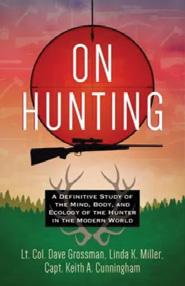
FASTEEL+
UNLEASHED V2 BUGLE TUBE ($97.90)

Phelps Game Calls, www.phelpsgamecalls.com
Key features: Makes elk bugles, screams, chuckles and grunts; flared mouthpiece for diaphragm calling; easy-to-use external mouthpiece for beginner callers. The promise: “Small and light with superb sound.”
NSU 3 PACK ($32.29)
Rocky Mountain Hunting Calls, www.buglingbull.com
Key features: Kit includes three elk diaphragm calls designed for various palate types; easy to use; makes calf, cow, spike and bull calls. The promise: “Our newest, most innovative diaphragm to date.” OC



Designed for allweather waterfowl hunting, Kent’s three-inch, 12-gauge Fasteel+ shells ($42/ box of 25) feature a layer each of two different sizes of plated-steel shot, allowing the smaller shot to draft behind the larger shot for a tighter pattern. Combined with doublebase powder and premium wads, the 1¼-ounce loads promise fewer cripples. Kent, www.kentdirect.ca


BATTLE ROPE
2.0
Breakthrough Clean’s Battle Rope 2.0 (US$16.99) makes gun barrel cleaning a cinch with its integrated flipout pull handle that doubles as a weight, allowing the cable to easily feed through the barrel. The integrated bronze brush then scrubs away stubborn carbon, while the thick rope wipes up residue. Breakthrough Clean, www.breakthroughclean.com
MANUFACTURERS
WHY DO WE SOMETIMES SHOW U.S. PRICES? FIND OUT WHY AT WWW.OUTDOORCANADA.CA/COST. 8 WWW.OUTDOORCANADA.CA | 21
BY RYAN STUART
BY GEORGE GRUENEFELD
Hatching a plan
OPINIONS DIFFER ON HOW TO REJUVENATE B.C.’S BELEAGUERED SALMON
B.C.’S PHILLIPS RIVER is one of the few places where a hatchery has actually helped recover a Pacific salmon population. Returns of chinook increased from less than 500 fish in the early 2000s to consistent runs of 2,000-plus over the past decade, prompting the Gillard Pass Fisheries Association to end its hatchery program on the river in 2019.
The very fact the runs have returned and the hatchery is no longer needed represents hope for salmon recovery on the B.C. coast. To mimic this success, however, a fundamental shift is needed in how most of the province’s hatcheries now operate.
According to the president of the Gillard Pass Fisheries Association, Rupert Gale, the group’s hatchery program followed the usual playbook in the early 2000s: collect eggs and milt from spawning wild salmon in the fall; incubate the eggs over the winter; then in May or June, roughly 90 days after they hatch, release the smolts into the Phillips or nearby ocean. Of the 200,000 so-called S0s the program released annually, only 100 to 500 adult fish would return to spawn. “It was not a great success,” says Gale.
The returns were, however, about average for chinook hatcheries across B.C. Many blame the low returns on poor marine conditions, while others say the unnatural breeding inherent in hatcheries produces inferior salmon. Then there’s veteran hatchery manager Carol Schmitt, who came to the rescue on the Phillips. She believes the hatcheries themselves are the problem.
“The eggs are perfect,” says the owner/operator of Omega Pacific, a private chinook salmon hatchery on Vancouver Island. “It’s how they are looked after and raised that is compromising the juveniles’ survival.”
A DIFFERENT HATCHERY APPROACH
Behind Schmitt’s opinion is 43 years of experience raising smolts for oceanbased fish farms. Omega grows its smolts slowly, she says, keeping them in the freshwater hatchery environment for a full year before moving them to the ocean. This regime, Schmitt contends, produces more resilient smolts and better mimics the life cycle of wild chinook.
Head-to-head results suggests she’s right. Every spring from 2010 until 2015, Omega Pacific released approximately 40,000 yearling chinook smolts—referred to as S1s—into the Phillips River alongside 160,000 S0s raised at the Gillard hatchery. Both broods were wire-tagged for tracking. Subsequent research showed commercial and recreational fisheries caught a higher ratio of S1s than S0s, and that the S1s returned to spawn both in higher numbers and as bigger fish.

Gale agrees the Omega hatchery regime played an important role in the Phil-

lips recovery, but he also credits a reduction in logging activity, habitat enhancement projects, and reduced fishing pressure. Schmitt is more adamant about the overall benefits of her approach. “If DFO incorporates our practices, it will transform the B.C. coast,” she says. “There would be lots of fish for harvest and to return to streams. It would be a wonderful thing.”
OTTAWA HAS OTHER PLANS
For its part, however, Fisheries and Oceans Canada (DFO) has not adopted the Omega regime. Adam Silverstein, the regional manager for hatchery reform and modernization at DFO, says that’s because studies— including a recent analysis by the Pacific Salmon Foundation—have found little evidence yearling smolts make a difference to fish survival or spawning success. “We’ve done experiments on all kinds of different release strategies,” he says. “There are no broad rules to apply to gain massive increases.”
The DFO does think it could do better, however. In 2021, Ottawa announced the $661-million Pacific Salmon Strategy Initiative, which includes the biggest investment in salmon enhancement since the federal hatchery program began in 1977. Some of the money will go to opening new hatcheries in the B.C. Interior, where there is little infrastructure and several endangered populations. Other funds, meanwhile, will go to better understanding the genetics of different salmon populations and applying that knowledge at the hatchery level. For the Gillard Pass Fisheries Association, that could at least open the door to using more of Omega’s S1 smolts for its new chinook hatchery program on the glacier-fed Southgate River. Research shows most chinook smolts spend a year in the frigid, silty river “growing up to size” before migrating to the ocean. Says Gale: “Omega’s S1s could be a really great tool on the Southgate.”
When it comes to restoring Pacific salmon, any promising option is a good news story. OC
FAIR GAME
22 | OUTDOOR CANADA [ HUNTING SPECIAL 2023 ]
FAIR GAME WWW.OUTDOORCANADA.CA
GUEST COLUMNIST RYAN STUART IS BASED ON B.C.’S VANCOUVER ISLAND.
RETSORING SALMON RUNS IS THE GOAL
Casual and Hunting Gear
Deceptive Camo TM
WE PUT OUR HEADS TOGETHER TO CREATE A COLLECTION THAT IS BOTH FUN AND FUNCTIONAL.
Amanda Lynn has always been into designing clothes and new looks, and with her career as an outdoors woman, she still wants to be fashionable and functional. Since 2002 Amanda Lynn has been designing different looks for fitness and outdoors adventures.

YOU USE CODE #JUSTHUNTOC

Award-winning clothing line by Readers Choice.
As seen on Sportsman Channel www.justhunt.ca.
 Photo courtesy of: Theresa Oliveira
BY GORD PYZER
Photo courtesy of: Theresa Oliveira
BY GORD PYZER
Go short
WHY THE NED RIG’S INVENTOR SAYS IT’S TIME TO RETIRE LONG RODS
THESE DAYS, EVERY avid Canadian bass angler surely has at least one spinning rod outfitted with a Ned rig. After all, the light mushroom-head jig adorned with a soft-plastic, worm-like nub has become a must-pitch presentation for tournament pros and recreational Joes alike. And now the offering has jumped well beyond bass fishing, with legions of walleye, crappie, perch and backwoods trout anglers also warmly embracing it.
As exceptional as the Ned rig is, however, most anglers are presenting it improperly by using the wrong fishing rod. At least that’s according to the man who should know, my good friend Ned Kehde (above), the famed rig’s namesake. His simple advice? “You should use a short spinning rod.” And that, he says, is at the heart of U.S. Midwest finesse fishing, which spawned the Ned rig in the first place.
TACKLE
In the 1950s, legendary Kansas angler Chuck Woods created the first Ned rig predecessor, the Beetle, and used it to great effect. Then Missouri’s Harold Ensley fished a jig worm—another Ned rig precursor—to win the World Series of Freshwater Sport Fishing in 1960. Also from Kansas, Drew Reese followed that up in 1971, using a jig worm to finish seventh at the first-ever Bassmaster Classic. The primary tool for throwing all those rigs? A short spinning rod made by the late Ray Fincke.
According to Kehde, Fincke’s most famous stick was a 5' 4" finesse spinning rod he called the Stinger. He made it from an ultralight 4' 6" graphite blank, gluing on a 19-inch length of fibreglass blank to add more power to the butt section. Fincke also fitted the butt with a nine-inch cork handle.
Originally, Kehde and his lauded fishing friends equipped their short sticks and spinning reels with four- and six-pound-test monofilament line. These days, they use spiderweb-thin, four-pound gel-spun and four-pound fluorocarbon leaders. This allows them to make deadly accurate, yet delicate, presentations, as well as impart subtle waves, nods and motions—something that’s difficult to do with the longer rods most Ned-riggers use nowadays.
Listening to Kehde outline the myriad benefits of short spinning rods, including their featherlight weight and manoeuvrability in tight quarters, I can’t help
but question the supposed sensitivity of today’s long rods. Kehde agrees.
“I have never been aware of the socalled sensitivity phenomenon until I began field-testing the prototype short rods Drew Reese designed for Z-Man, which will be introduced this year,” Kehde says, noting he’s also field-tested an array of spinning rods from other manufacturers. Most were long, expensive and reportedly state-of-the art, including one made especially for Ned-rigging.
“It was 6' 7", and I told the company I couldn’t rate its sensitivity because I couldn’t feel it,” says Kehde. “But Reese’s new Ultimate Ned Rig Rods for Z-Man are as light as a feather. They are magical. And they’re so sensitive I can’t find any sensible words to explain them.”
TECHNIQUE
The way Kehde sees it, even long medium-light and light-action spinning rods are too heavy to properly present 1⁄10- to 1⁄30-ounce Ned rigs. And the supposed benefits of longer casts are vastly overstated, he adds, noting that some anglers say they’re casting up to 120 feet.

“We have never found that long casts help us catch more fish,” Kehde says. “Across the many decades that we have employed our Midwest finesse tactics, the bulk of the fish we’ve caught have ranged from about 30 feet away from the boat to right under it. And most of those fish were caught in water as shallow as a foot to as deep as about 13 feet.”
In order to hook the 101 bass he sets as his goal every time he launches his boat, Kehde says he only casts his Ned rig to short-range targets, then swims, glides and trembles it ever so delicately. If you use a longer rod, he notes, those movements become exaggerated and less effective.
“Two words lie at the heart of Ned rigging,” Kehde says, chuckling. “Subtle and simple. And a long rod is neither of those things. Mark my words, within two years the angling world will once again become enlightened about the many merits of short rods—and the demerits of long ones.” OC
NED KEHDE 24 | OUTDOOR CANADA [ HUNTING SPECIAL 2023 ] WWW.OUTDOORCANADA.CA
FISHING EDITOR GORD PYZER SHARES HIS SECRET CISCO TRICK ON PAGE 64.
ON THE WATER
NED KEHDE SAYS HIS RIG SHINES USING SHORT RODS





Canadian Power and Sail Squadrons Escadrilles canadiennes de plaisance www.cps-ecp.ca | 1-888-CPS-BOAT
1938, CPS-ECP volunteers have been sharing their on-the-water knowledge with new and seasoned boaters, helping them prepare for both every day and emergency situations. Fees collected from our courses are reinvested in programs that allow us to better serve Canadian boaters. Charitable Registration Number: 10686 5611 RR0001 SCAN TO LEARN MORE $49.95 TAX FREE Course and Card PASS, PRINT AND GO
Print a temporary card
Get your permanent card in the mail
Good for life ONLINE COURSE
Open book quizzes
Unlimited test retries
Designed by a non-profit community of boaters for boaters MADE IN CANADA
Transport Canada Accredited
The only Canadian card that is NASBLA Approved and recognized by the US Coast Guard Get Your Official Boating Licence Today! BoatLicenceCanada.ca CANADA’S PLEASURE CRAFT OPERATOR CARD (PCOC) COURSE Summer Smith 01/01/2020 SMI-1234 05/01/2023
Since
•
•
•
•
•
•
•
•
BY SCOTT GARDNER
SCOTT GARDNER
Flex appeal
WHEN IT COMES TO YOUR ROD’S ACTION, LESS IS TYPICALLY MORE
BACK IN 1987, I hit the mall with a friend from my Grade 12 chemistry class to help him buy speakers for his new stereo. Duke, as he liked to be called, quickly settled on small, milk-crate-sized speakers that sounded great for a modest price. Then a fast-talking salesman showed him a series of larger, more powerful speakers. Duke was enthralled. “They’re so loud!” he shouted over thunderous Van Halen riffs. I pointed out the sound quality was actually worse, but Duke was sold. And so we staggered out of the store with massive cabinets that barely fit in his Chevette—or his bedroom. Predictably, he never once played them anywhere near as loud as they were in the showroom. Duke’s speaker choice reminds me exactly of how many of today’s fly anglers, especially beginners, pay for powerful, hard-to-cast rods totally unsuited for their skill level or fishing needs. Here’s why you should avoid the fly-rod power trap.
UNDERSTANDING ACTION
The key factor in a fly rod’s casting performance is its action—how much it flexes during a cast. Actions are generally described as slow, medium or fast. Deep-flexing, slow-action rods are a holdover from the bamboo era. They don’t cast far, they’re hopeless in the wind, and they’re only used by a few fanciers who follow the old ways (see “Bamboo bamboozle.”)

Thanks to modern materials such as graphite and carbon fibre, today’s fly rods range from medium-action to extra-fast. For the vast majority of Canadian fly anglers—and all beginners—the right choice is a medium-action rod. These are do-it-all rods that can easily cast mid-sized flies up 40 feet, with a blend of zing and delicacy, even in the wind. And because you can see and feel the way medium rods flex, they’re easier to learn on. They’re also forgiving of a lessthan-perfect technique.
Stiff, fast-action rods are powerful. They’re usually not very accurate, but they’ll throw 50, 60 or 80 feet of line and deliver large flies in extreme conditions. They let anglers make long casts on blustery Caribbean flats, hurl 12-inch muskie flies, and experience other exciting niche fisheries. Powerful, fast-action rods are very hard to use, however, unless you have excellent technique and timing, and you’ve mastered the advanced casting skill of double-hauling.
POWER PROBLEM
The problem is not that fast-action rods exist. The problem is that marketers and manufacturers quickly learned that power sounds cool, and sells rods. For the past 20 years, they’ve been promoting ever-faster rods, while subtly suggesting that medium-action is for wimps and novices. As a result, many anglers have ended up with rods that are hard to cast, with power they don’t need and will never use.
I’m not suggesting the friendly staff in your local fly shop are intentionally ripping you off, like sleazy 1980s speaker salesmen. They’re often expert casters who love fast-action rods, and that enthusiasm can be contagious. Also, it’s easy to think a powerful rod will make you a better caster. It won’t. Unless you work hard at it, and take some lessons, powerful rods make you worse. I’m a pretty capable caster, for example, but only two of my 10 fly rods are fast-action; one is my back-up stick for trophy pike and bonefish, and the other is for tarpon. The rest are all medium or medium-fast.
Sure, medium doesn’t get you a million hits on social media—the middle of the road just isn’t sexy. But for most Canadian fly anglers, that’s where you should be. If you’re just starting out, avoid any rod advertised as powerful, and look for an easy-casting (and often less expensive) medium. And if you’ve been fly fishing for a while, but casting is still a struggle, get your hands on a medium-action rod and give it a try. You just might discover you’re a lot better at fly casting than you thought. OC
ASSOCIATE EDITOR SCOTT GARDNER IS A DECIDED MEDIUM-ACTION MAN.
In case you were ever wondering, the complex casting feats that Brad Pitt’s character, Paul Maclean, accomplished with a bamboo rod in A River Runs Through It are exceedingly rare—and for show only. The so-called shadow casts were actually performed by a double, expert fly angler Jason Borger, who stood in for most of the casting scenes in the 1992 movie.

FLY FISHING
26 | OUTDOOR CANADA [ HUNTING SPECIAL 2023 ]
FLY FISHING
SCOTT GARDNER (FLY CASTER); COLUMBIA PICTURES ( A RIVER RUNS THROUGH IT SCENE)
BY
A MEDIUM-ACTION ROD GETS IT DONE WWW.OUTDOORCANADA.CA
BAMBOO BAMBOOZLE
1ST PLACE: 13 Fishing Rod, Reel & Gear Prize Pack (MSRP $500)



13 Fishing Tackle Prize Pack (MSRP $250)

13 Fishing Tackle (MSRP $100)




ENTRY DEADLINE: JANUARY 2, 2024
1ST PLACE: Zeiss 10x42 Conquest HD Binoculars (MSRP $1,649.99)

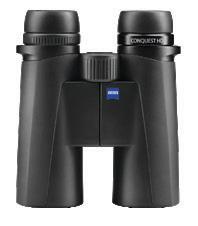
2ND PLACE: Zeiss 3-12x44 Conquest V4 Riflescope (MSRP $1,449.99)


THIS CONTEST IS only open to residents of Canada (except Quebec). No purchase is necessary. Professional photographers are not eligible. Photographs must have been taken in Canada on or after January 1, 2023. Entries must include details of when and where the photos were taken. Please enter your high-resolution digital images online at: WWW.OUTDOORCANADA.CA/OCPHOTOCONTEST
3RD PLACE: Zeiss Terra 10x25 Compact Binoculars (MSRP $599.99) www.berkley-fishing.com


1ST PLACE: Berkley Fishing Tackle Prize Pack (MSRP $750)


2ND PLACE: Berkley Fishing Tackle Prize Pack (MSRP $500)
3RD PLACE: Berkley Fishing Tackle Prize Pack (MSRP $250)

YOU MAY ALSO submit original prints or slides, or discs or thumb drives with high-resolution images, to: Outdoor Canada Photo Contest, 9 Billings Avenue, Toronto, Ontario, M4L 2S1. Please specify the category you are entering, and include your name, address, phone number and when and where the photograph was taken.
PHOTOS DEPICTING WILDLIFE AND/OR NATURAL LANDSCAPES IN CANADA


1ST PLACE: VSSL JAVA portable hand coffee grinder (MSRP $200)

2ND PLACE: VSSL Camp Supplies (MSRP $185)


3RD PLACE: VSSL Mini Stash Speaker (MSRP $130)

HUNTING FAMILY WILDLIFE & WILD PLACES FISHING
www.zeiss.ca www.vsslgear.ca
Follow our sponsors on Instagram! @13fishing @zeisshunting @berkleyfishing & @VSSL
ANY ASPECT
SPORTFISHING
FOR COMPLETE RULES, PLEASE VISIT WWW.OUTDOORCANADA.CA/OCPHOTOCONTEST
PHOTOS DEPICTING
OF
IN CANADA
PHOTOS DEPICTING ANY ASPECT OF SPORT HUNTING IN CANADA
PHOTOS DEPICTING YOUNG CANADIANS ENJOYING FISHING AND/OR HUNTING ENTER NOW! ANNUAL PHOTO CONTEST 13 th www.13fishing.ca WWW.OUTDOORCANADA.CA/OCPHOTOCONTEST
BY KEVIN WILSON
Lighten up
ARE
HEAVY DRAW WEIGHTS STILL NECESSARY FOR BOWHUNTING?
AS I WATCHED two gemsbok approach, it was obvious by his heavy, weathered horns that one was a mature trophy bull. So, I drew and waited patiently as he quartered away. I was shooting my wife’s bow—more on that in a minute—and questioning the light poundage because gemsbok are so thick-bodied and muscular, comparable to elk. Settling the sight pin on the crease behind his shoulder, I tightened my back muscles and released. The arrow hit perfectly, penetrating deep into the bull’s chest. After a short, 40-metre run, he collapsed (see above).
I had to shoot my wife’s bow, purple accents and all, during that 2016 trip to Africa because someone back at the lodge had dry-fired mine, leaving it completely dysfunctional. I generally bring a backup bow, but not on that trip, so I had no choice—if I were going to bowhunt, I’d have to use my wife’s bow. On the bright side, it was the same model as mine, just with lighter custom limbs. Set at a draw weight of 48 pounds, the bow was also deadly accurate, as my wife had already taken a warthog, a baboon and a gemsbok with it.
In the end, I also successfully arrowed a hartebeest with that bow, making me realize bigger isn’t necessarily better when it comes to draw weight, especially when you keep the following factors in mind.

PICKING THE POUNDAGE
I got my first compound bow, a PSE Polaris, back in 1989. It was set at 78 pounds, and had a 28-inch draw length. I was 22 years old at the time, and bigger and stronger than I am today—I can’t imagine pulling that poundage now. Luckily, with today’s advances in bow technology, I don’t have to. Archery is a precision shooting sport. While muscle memory and fitness will always be part of the equation, there’s simply no need to pull extreme draw weights these days.
I know many competitive 3D archers and hunters who pull between 55 and 60 pounds. Most of the year, I pull 62 pounds. That’s comfortable and accurate for me, and I shoot well out to 90 yards. When I’m hunting during November’s extreme cold conditions, I even turn my bow down to 56 pounds. That helps compensate for the bulky clothing and inevitable fatigue during long frigid days on a stand.
With practice, most averagesized males between the ages 16 and 40 don’t have an issue pulling higher draw weights. Is it necessary? Not really. Is it better? The answer is layered. Faster bows will indeed shoot flatter, which means tighter sight pins and theoretically less margin of shooting error. Slower bows—or those set at lighter draw weights—require sight pins to be set farther apart.
It’s also important to understand that bows shoot better at the upper limits of their limb window. For example, if you have 50- to 60-pound limbs, your bow will usually perform best set closer to 60 pounds.
LOWERING THE LIMIT
As it stands, the majority of jurisdictions across North America have minimum draw weight requirements for bowhunting. The rationale is to ensure sufficient penetration for a quick kill. That magic number is generally 40 pounds, established decades ago when bows needed to load with greater poundage to deliver suitable downrange energy. Again, that has all changed in recent years, with today’s more efficient limb and cam technology delivering stored energy better and faster.
Why is this relevant? A valid argument can be made to now lower the minimum draw weight requirement. Some suggest 30 pounds would be more suitable in order to accommodate youths just getting into bowhunting, as well as for people of smaller stature. For them, the 40-pound minimum can sometimes be a challenge.
Then there’s the whole age thing. With both males and females, our muscles atrophy as we age. As a result, most men will adjust their draw weights on average to between 50 and 60 pounds around the time they turn 50.
Still, for many bowhunters, the question remains, is a bigger draw weight really better? Perhaps it would better to ask if it’s really necessary. The laws of physics and the efficiency of today’s bows would suggest the answer is no. OC
BOWHUNTING
28 | OUTDOOR CANADA [ HUNTING SPECIAL 2023 ] WWW.OUTDOORCANADA.CA
KEVIN WILSON
ALBERTA BOWHUNTER KEVIN WILSON PURSUES A WIDE VARIETY OF GAME.
A 48-POUND DRAW WEIGHT HANDLED THE AUTHOR’S GEMSBOK








SPORTSMANCANADA.CA CANADA FEATURING CANADA’S MOST TRUSTED AND KNOWLEDGEABLE PROGRAMS FREE PREVIEW! OCTOBER 1-31
BY KEN BAILEY
Breaking barriers
TO ACCESS PRIVATE PROPERTY TO GO HUNTING, IT PAYS TO MAKE NICE
AS WE CONTINUE to lose crown land to residential, agricultural and industrial development, gaining access to private land is becoming increasingly important for hunters. Unfortunately, some hunters don’t always appreciate the concerns of landowners, creating a barrier to access. To better understand this problem, the Alberta Conservation Association surveyed both private landowners and hunters in 2021 and 2022—and the interesting results point to a clear solution.
Seventy-two per cent of landowners said their property is used primarily for agriculture. But when asked what makes their land most valuable, 78 per cent listed habitat for plants and animals, revealing the importance they place on wildlife stewardship. This undoubtedly factors into their decision about whether to allow hunting, as well as about what type of hunter they’re willing to accommodate.
When asked about the frequency of hunters seeking access, meanwhile, 38 per cent said there’d been no change in recent years, 36 per cent identified an increase, and 11 per cent said they’d had no requests. As for granting permission, 54 per cent said their decisions haven’t changed over time, 40 per cent said they’re less likely to say yes, and six per cent indicated they’re more likely to grant access. Interestingly, when asked whether they could accommodate more hunters, 15 per cent said yes.
LANDOWNER PREFERENCES
Trespassing topped the list of concerns for 90 per cent of landowners who allow hunting, and for 95 per cent of those who don’t. Next in order of concern for both groups were safety, property damage, poaching, liability issues, wildlife populations, and their own personal hunting enjoyment. Clearly, any hunter who trespasses is making it harder for us all.

When asked what would motivate them to permit more hunter access, 61 per cent of landowners who don’t allow hunting said nothing would change their mind. However, 43 per cent of those who do allow hunting pointed to property damage from increased deer and elk populations as the main reason they’d allow more access. The next reason would be to accommodate more opportunities for mentored youth hunts.
Not surprisingly, landowners are far more likely to give access to family, friends and neighbours than to others. When they do consider new people, locals and other rural inhabitants are preferred over city dwellers, who, in turn, are favoured over non-resident hunters. Hunters guided by a professional outfitter are the least likely to gain access.
Landowners are evenly split on the question of whether granting permission is influenced by the species or sex of the animal being hunted. I would suggest those hunting cow elk or does are more likely to gain access, particularly from landowners contending with depredation problems.
HUNTER PERSPECTIVES
As for hunters, two-thirds said they rely on private land for most or all of their hunting, with 50 per cent indicating they’ve had a multi-year relationship with a landowner. Still, a good number said they hunt on private land where they have no relationship with the owner.
When asked how they seek permission, 68 per cent said they knock on doors, while 60 per cent said they phone (some do both); only 20 per cent communicate via text or email. Forty-six per cent of hunters said they contact two to four landowners for permission annually, while four per cent contact 30 or more. Now that’s persistence.
When surveyed about the reasons they’re given if denied access, 26 per cent said previous trespassing problems were cited most often, followed by a general opposition to hunting and previous damage to property. Tellingly, only three per cent of hunters reported having no success in gaining access, while a full 68 per cent said they were generally satisfied.
So, what’s the take away here? Most landowners will grant hunting access, but the survey reinforces the importance of building trust. It’s just a matter of putting in the effort. Be conscious of how you appear, and of how and when you speak to landowners. For example, consider the impact of roaring up to their gate on opening morning in a mud-encrusted four-wheeler with oversized tires.
Perhaps more importantly, be respectful of their decision and their land, and be prepared to build a relationship over time, complete with small gestures of appreciation. All you need to do is use the manners your mother taught you, and you’ll be more successful in gaining access than you might think. OC
GOOD MANNERS CAN GET YOU PAST THE GATE 30 | OUTDOOR CANADA [ HUNTING SPECIAL 2023 ] WWW.OUTDOORCANADA.CA
LOU CANNON/SHUTTERSTOCK.COM IN THE FIELD
HUNTING EDITOR KEN BAILEY ALWAYS TREATS LANDOWNERS WITH RESPECT.
8
LEARN MORE ABOUT THE SURVEY RESULTS AT WWW.OUTDOORCANADA.CA/ACASURVEY.
$200 OFF FROM AUGUST 1ST TO SEPTEMBER 18TH, 2023 GET $200 BACK WITH THE PURCHASE OF A NEW A400 XTREME PLUS BERETTACANADA.CA/REBATE
XTREME PREPARATIONS XTREME CONDITIONS XTREME EXPECTATIONS

THE A400 XTREME PLUS. BUILT TO GO WHEREVER YOUR HUNT TAKES YOU.

Designed to withstand the toughest waterfowl environments. Engineered to be the softest-shooting, most reliable 3.5" waterfowl shotgun out there. The A400 Xtreme Plus features Beretta’s exclusive Steelium Plus barrels, a first for hunting shotguns providing the best patterning possible from all hunting loads, along with further felt recoil mitigation. #BerettaTribe
*NEW 20 GAUGE AVAILABLE IN 4 DIFFERENT PATTERNS

@BERETTACA BERETTACANADA.CA
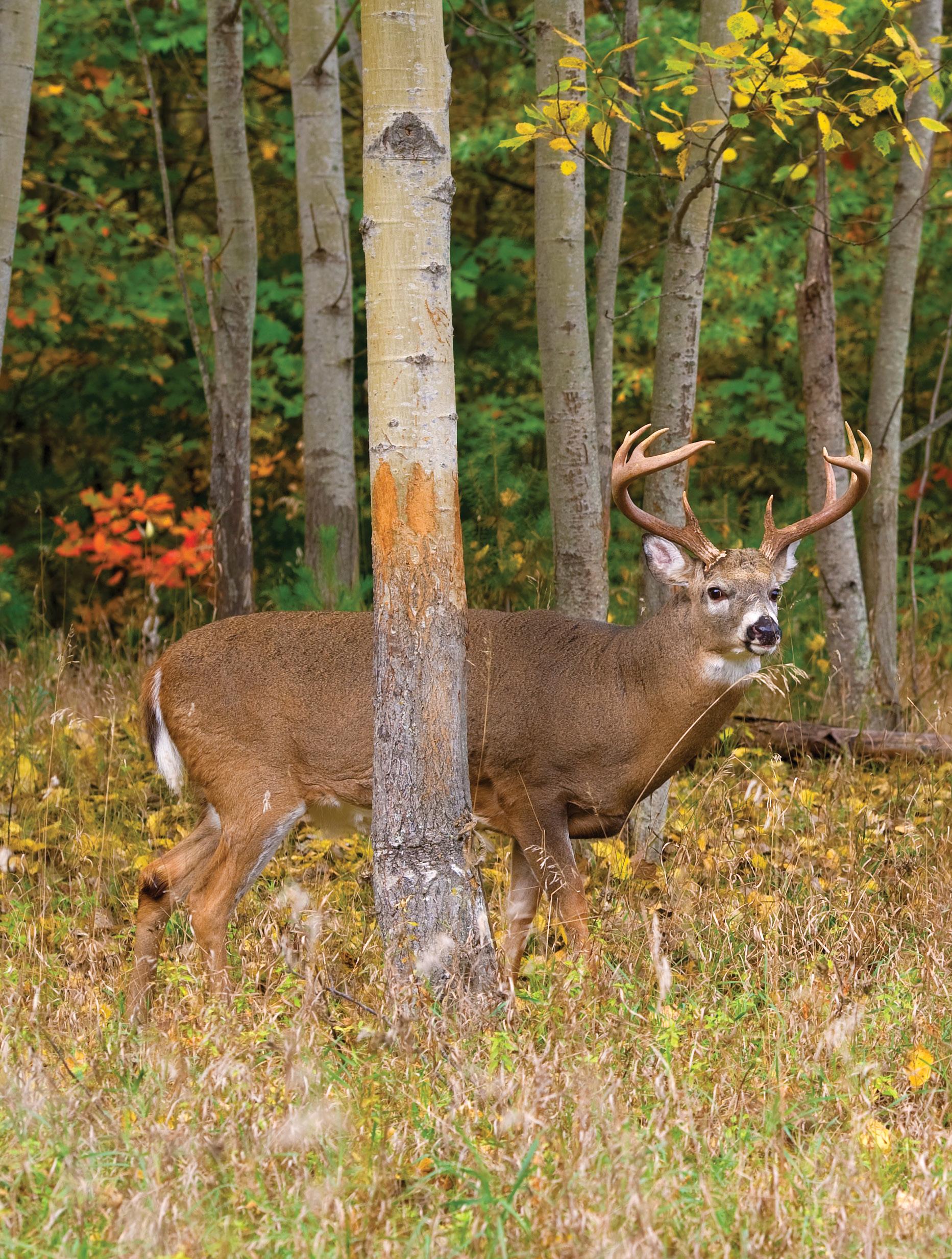


32 | OUTDOOR CANADA [ HUNTING SPECIAL 2023 ]
A rub line reveals a big buck is a regular visitor
SIGN, SIGN,
How to interpret rubs, tracks, droppings, scrapes and more to boost your odds of connecting with a trophy white-tailed buck this fall
 WORDS & PICTURES
BY MARK RAYCROFT
WORDS & PICTURES
BY MARK RAYCROFT
Alot has changed in the world of whitetail hunting over the years, except for one thing: the deer themselves, and the clues they leave behind. Understanding deer sign such as rubs, scrapes and tracks is key to predicting whitetail movement patterns, which in turn forms the backbone of consistent hunting success. And once your scouting reveals evidence of a healthy deer population, the rest depends on time spent afield, a keen eye and a bit of luck. Here’s how to unravel the clues to pattern a big buck this fall, and fill your freezer in the process.
WWW.OUTDOORCANADA.C A | 33
everywhere a sign
RUBS
A fresh rub is proof a testosterone-charged buck has been in the area. A carved-up tree trunk—its white, fleshy underlayer exposed by the grinding of a buck’s gnarly antler bases—is as easy to spot as flagging tape. A visual marker covered with scent from the buck’s forehead gland, a rub’s purpose is to mark his territory. These signposts are mostly made near bedding areas and along travel corridors leading to feeding locations. Bucks prefer to sneak along habitat transition zones where two types of habitat converge, so start your search for rubs where forests meet fields, hardwoods meet cedars, or cedars meet wetlands, for example.
The size of a rub does not necessarily reveal the maturity of the buck that made it. While small bucks are only successful at rubbing small trees, huge bucks will also occasionally beat up on skinny saplings. If you find shredded bark on a tree that’s more than a few inches in diameter, however, it has definitely been worked over by a mature buck. You’ll know if the rub was freshly made if the exposed woody cambium is golden yellow; if it’s a faded grey, it’s from a previous year’s rut.

A rub line—three or more rubs in close proximity—indicates a buck regularly travels through the area (see photo on previous page). He will always rub the side of the tree he approaches from, telling you the direction he came from, and the direction he’s headed. He won’t necessarily make a fresh rub every time he passes through, but when he does it will typi-
cally be on a different tree each time. The rub lines offering the greatest opportunity for daytime action are found along the edge of a bedding area, part of a buck’s range where he feels safest. More on that later.
TRACKS & DROPPINGS

Tracks are the easiest proof to find that deer live in the area. The challenge lies in identifying the sex and age of the deer that made them. For the most part, only tracks left behind by fully grown bucks and small fawns can be identified with confidence—if the hoofprint is wider than


a .308 cartridge, then it’s probably from a buck (see photo, left). Heavyweight males will also leave behind dew claw marks if the ground is soft. In all cases, the direction of travel is wonderfully obvious, and you’ll know if the deer was running at the time if the toe marks are splayed.
As for droppings, bucks leave behind the largest pellets, which clump together more often than doe pellets (depending on the amount of moisture in their diet at the time). Along with tracks, droppings are best used to simply verify that deer have been using the area.
34 | OUTDOOR CANADA [ HUNTING SPECIAL 2023 ]
Bucks create rubs to mark their territory
Big bucks leave tracks wider than a .308 cartridge
SCRAPES
Made from early October through to December, scrapes are the best sign of buck activity you can find. An active scrape is a patch of exposed soil roughly two or three feet in diameter where the buck has pawed away leaves and other debris with his front hooves, then urinated to both mark his territory and attract does in heat. Hunting over scrapes is one of the most successful tactics for the pre-rut and post-rut weeks when bucks are cruising their territory at the beginning or end of the day.
Before pawing the ground, the buck will stretch his head up to nibble and moisten the tip an overhanging branch, aptly called a “licking branch” (see front cover photo). He also rubs his face and forehead on the tip to deposit scent from his preorbital and forehead glands. After several seconds of licking, the buck will paw the ground directly under the branch, then step forward to urinate over the tarsal glands on his rear legs as he rubs them together. This creates a musky odour in the freshly disturbed earth, completing the strongest communication hub of the whitetail rut.

Breeding bucks will rework their favourite scrapes every few days, unless they’re tending a doe (which usually only lasts for approximately 48 hours). By keeping his scrapes fresh, a boss buck can entice receptive does to stay in the area while he makes his rounds. The best time to scout for fresh scrapes is two or three days after it rains. Since scrapes will have been smoothed over by the rain, any defined tracks you find will be fresh, meaning the scrape has
been worked very recently. Which scrapes are bucks most likely to hit during legal shooting hours? It’s all about location. Most daytime scraping occurs in areas where the buck feels safe, often near a habitat transition zone back in the timber near his bedding area. Once you find a fresh scrape (or rub), select an ambush location for a stand or blind that’s within range on the downwind side.
Some scrapes are hit perennially, as long as there continues to be a licking branch. Keep this in mind when you find a hot scrape,
as it could be used year after year. Never hang scent wicks on a licking branch, as the spot is already set up with ample scent for success.
Should the licking branch break off from all the head rubbing, however, it will effectively kill the scrape. If there’s another branch nearby, the buck will likely switch over to it. If not, you can keep the scrape going by replacing the broken branch. Simply cut a similar branch (typically four or five feet long) and attach it in place over the
scrape using zip ties.
If you can’t find any scrapes, you can create a mock version to test if there are bucks nearby. Select a sheltered spot with an overhanging branch along a habitat transition zone, and use scent-free rubber boots to kick away leaves and other forest debris to expose the soil. Then snap the tip off the overhanging branch while wearing scent-free gloves. To monitor the scrape for evidence of fresh activity, set up a trail cam.
» WWW.OUTDOORCANADA.C A | 35
Fresh scrapes entice hot does to stick around
BEDDING AREAS

It’s exciting to find oval depressions in grassy openings where you hunt. In the summer, deer will rest in these exposed locations during the daytime to escape the swarms of biting insects in the sheltered woods. In the fall, however, these beds are almost always made by whitetails under the cloak of darkness. The upside of finding exposed beds is that they at least confirm deer are active in the area. Now it’s
just a matter of figuring out where they rest during autumn’s daytime hours. Hunting bucks in those areas can reap big rewards. For the weeks leading up to and following the rut, mature bucks choose their daytime refuge with the upmost care. They’ll often settle in the hardest to reach area of their home range, where it would be virtually impossible to sneak up on them. Bucks frequently head up southfacing forest ridges, for example, where they’ll bed against deadfall or a grouping of trees to break up their outline. This is where they’ll spend the remainder of the morning and early afternoon, chewing their cud and napping.
Another daytime haunt for bruiser bucks can be a small rise along the edge of a marsh, where the cattails and water make it impossible for an intruder to approach without making noise. Bucks will also hide during the day among felled treetops in areas that have been logged. During the post-rut in the late season, cold snaps will find bruisers bedding down in such areas closer to their food sources to conserve energy. In all cases, these daytime hideouts will typically be ringed with telltale rubs and scrapes if they’re being used by a buck. Given the foolproof vantage point provided by these bedding areas, the only way to outsmart a
buck using one is to set up at dawn well before he returns from his morning routine. Or, you can intercept him along his travel route as he returns. Always approach the area with the wind in your favour and never cross the deer’s return route.

During November’s rut, meanwhile, bucks don’t have predictable bedding routines—or any routines for that matter—as they’re basically chasing does non-stop. They will bed down after tending a doe in heat, but the location is dictated by her. Usually, a doe in estrus will hide in the densest thicket available for a couple of hours following mating.

36 | OUTDOOR CANADA [ HUNTING SPECIAL 2023 ] WWW.OUTDOORCANADA.C A »
Deadfall makes for a prime daytime buck hideout

TRAILS

Deer travel routes are dictated by whatever their favourite food sources are, which can change from one year to the next, especially in farmland where crops are frequently rotated. When travelling from their daybed hideout to their preferred feeding spot in the evening, deer always choose the path of least resistance and remain as concealed as possible. The same applies when they return in the morning. To find signs of daytime deer trails, scout the likes of forested ravines, the perimeters of beaver ponds, below beaver dams, mature pine plantations, and agricultural drainage ditches that are overgrown with willows or sumacs.
Once you know what route deer are taking between their bedding and feeding areas, study the landscape to find pinch points in the terrain to intercept them. Manmade barriers such as farm fences and hedgerows can also funnel deer movement. And don’t ignore smaller woodlots during the rut, especially in farmland. What might appear to be too small to conceal a big buck could make for the perfect hideout for a doe in heat and her crowned suitor.
In the prairies in particular, make note of areas where the elevation changes, such as rivercarved ravines meandering through grasslands. Deer will feed, drink, rub, scrape and bed down in these sheltered valleys, which are
largely hidden and offer a natural windbreak in the otherwise vast expanse. Note that most major deer trails are primarily made and used by does and fawns. Bucks prefer the security of more secre-

tive routes during the preand post-rut, so look for less-worn secondary trails that typically run parallel to the main runways, 30 or 40 yards away. These subtle travel routes should have rubs and scrapes
along them to verify they’re being used by a buck. The exception to this is during the rut, when hormonecharged bucks will eagerly check any area where does are active, including primary game trails.

38 OUTDOOR CANADA WINTER 2012 WWW.OUTDOORCANADA.CA 38 OUTDOOR CANADA WINTER 2012
38 | OUTDOOR CANADA [ HUNTING SPECIAL 2023 ] » WWW.OUTDOORCANADA.C A
Intercept bucks along their travel routes











→ in AURIC ™ Concealment MAXUS® II WICKED WING browningcanada.ca 23-BCA-145_Maxus II_AURIC_Waterfowl_Ad_8.25x10.5.indd 1 6/1/23 8:06 AM
WATERING HOLES
Deer need to drink throughout the day, so one of the best areas to scout for active buck sign is around waterways. Deer are not only attracted to ponds, marshes, rivers and creeks for hydration, but also to escape human pressure. They will typically drink in the morning before bedding down, then around midday, and again before heading out for their evening feed.
Tracks should be evident in the exposed earth along shorelines, where deer might travel parallel to the water, or cross it. As well, tall grass hugging the

shoreline will be packed down where the deer travel. If you find a lot of tracks in the area, you’ll know you’ve discovered a well-used water source.

Finally, deer are excellent swimmers, so it’s also worth checking out any

islands you may come across. Such areas are rarely scouted, if ever, so a short canoe ride can really pay off. Look for flattened beds, rubs, scrapes and/or tracks to confirm the island is a trusted bigbuck hideaway.
 Numerous tracks indicate a popular watering hole
Numerous tracks indicate a popular watering hole
STAGING AREAS

A staging area is a small opening where deer feel confident as they linger in the morning to feed a bit more before returning to their bedding area. They’ll also visit their trusted staging area early in the afternoon to snack before heading to their larger feeding grounds when it gets closer to dark. Rubs and scrapes will be evident if bucks are using the area.

The concealed corner of an old apple orchard is one of my favourite staging areas to hunt. A small soy-
bean or alfalfa field in the back 40 that’s surrounded on three sides by woods can also be very productive. Best of all is a huge oak tree that’s covered the forest floor with acorns, 30 yards inside the treeline. Find one of these active staging areas, and it could prove to be yet another gem of a hunting spot—and your ticket to success. OC
LONG-TIME CONTRIBUTOR
MARK RAYCROFT HUNTS AND PHOTOGRAPHS WHITETAILS AND OTHER BIG GAME ALL ACROSS CANADA.


FREE SHIPPING IN CANADA with some restrictions deluxe wall tents www.deluxewalltents.com perry@deluxewalltents.com 250-704-2534 H custom wall tents H wood stoves aluminum frames H tarps H game bags H bedrolls H diesel heaters H cots WWW.OUTDOORCANADA.C A | 41 FOLLOW US! @outdoorcanadamagazine @outdoorcanada&outdoorcanadawest @outdoorcanada @outdoorcanadaw (Outdoor Canada West)
Old orchards can provide buck staging areas
Be ready to cover a lot of ground hunting sharptails



42 | OUTDOOR CANADA [ HUNTING SPECIAL 2023 ]
KEN BAILEY
BY KEN BAILEY
Wingshooting is a highly varied and equal-opportunity pastime. It’s pursued by farm boys in rubber boots carrying Grandpa’s single-shot, and by business executives in English tweed toting $50,000 custom-fitted doubles. Most of us fall between those two extremes, but we all share a passion that’s as hard to shake as it is to explain.
As fall approaches, our thoughts turn to cool crisp mornings, coveys of partridge and grouse, skeins of ducks and geese, trusting dogs and trusted shotguns. We can smell the harvest of grain on the slightest waft of wind, and the odour of the marsh, that complex mix of sweet wild mint and the stink of decomposition. We’re attuned to the familiar calls of migrating geese, and we relish the evening winnowing of snipe. And we need only close our eyes to recall the thrill of whirring wings and the annoyed cackling of a flushing rooster.
What’s not to love about wingshooting, especially in the West? For those of us who live or hunt on the prairies of Manitoba, Saskatchewan and Alberta,
From waterfowl, snipe and cranes to pheasant, grouse and partridge,
WINGS OVER THE WEST
we have the best of the best at our doorstep. We enjoy near endless acres of prime habitat, landowners who are generally welcoming, and friendly prairie towns with hotel diners offering bottomless cups of coffee. Most of all, we enjoy diverse and healthy populations of birds. For the uninitiated, here’s what you can expect.
SHARP-TAILED GROUSE
will have an abundance of snowberry, buffalo berry and other shrubs.
Early in the day, they can often be found feeding in harvested grain fields, their heads poking above the stubble, giving them away to keen-eyed hunters. As morning progresses, they will invariably move back into cover. Most often, they’re hunted with wideranging pointers and flushing dogs, and you must be prepared to put many kilometres on your boots—the reward can be numerous random flushes of singles and pairs. Without dogs, your best bet is to hunt the headlands between stubble and pasturelands, as well as the perimeters of willow sloughs.
With the extirpation of the greater prairie chicken in Canada and sage grouse populations below huntable numbers, the sharptailed grouse reigns as the true native son for prairie bird hunters. Sharptails are birds of the edge, associated with native prairie; ideal habitat for them »
As the season progresses,
the Prairie provinces offer wingshooters unparalleled opportunities
WWW.OUTDOORCANADA.C A | 43 »
sharptails begin to congregate in larger coveys, but that means more eyes alert to approaching danger. Be warned—they’re the wariest of our upland game birds and they get jumpy easily, often flushing out of shooting range. For that reason, many hunters consider the early season to be more productive.
Unlike Hungarian partridge, which typically flush as a covey, sharptails are prone to flushing in succession, in a series of singles and pairs. Experienced hunters always have extra shells at the ready to quickly reload after a flush. The key is to reload before taking another step, as that will often trigger the next flush.
Most consider the dark meat of sharptails to be the poorest table fare among prairie upland birds. That may be true, but cooked low and slow in a sauce, they can make for surprisingly fine dining.
HUNGARIAN PARTRIDGE
Known colloquially as “Huns,” Hungarian partridge were initially introduced on the Canadian prairies more than 100 years ago. Also referred to as grey partridge, they’ve been here so long and have adapted so well to our prairie climate that we generally now accept them as one of our own. It doesn’t hurt, either, that their drab brown-grey reminds us of our native grouse.
Prime habitat for these partridge can look intimidatingly barren, a sea of stubble broken up by the
occasional fenceline hedgerow, slough bottom or abandoned farmyard. Rest assured the birds are out there somewhere, though—you just have to find them. Luckily, their home range is pretty small, so if you’ve found Huns in a specific location in the past, there’s still likely a covey or two nearby.
Experienced partridge hunters keep bankers hours; there’s little sense trying to catch these birds in the open stubble, where they feed on grain and insects, early in the morning. You’re better off waiting until mid-morning, after the dew is off the grass, when they’ve returned to cover; they do not like wet conditions. Search the obvious patches of habitat thoroughly, and you’ll enjoy success.
Huns will often hold tight, especially early in the season, and typically flush as a covey, so you must always be ready. Resist snap-shooting or flockshooting; you’ll either decimate these delicate birds or miss altogether. Count a Mississippi or two after the flush, pick an individual bird, and mark where

it falls before swinging onto another. Huns have a unique way of disappearing when they go down, and when wounded they can squeeze into cover so tight an anorexic butterfly couldn’t slip through.
Given time, Huns will recovey after they flush. Mark where they land and go after them immediately; you’ll often flush them again as singles and pairs.

RING-NECKED PHEASANTS
Pheasants are another introduced bird on the prairies. Like Hungarian
partridge, they’ve been here for more than a century, but there’s no mistaking these long-tailed, garish birds for a native. Still, we love them. In fact, more corporate logos in southern Saskatchewan and Alberta honour the pheasant than any other creature.
The reasons for our love affair with pheasants are pretty simple. For one, they are beautiful, and they’re terrific on the table. They’re also relatively slow flyers and therefore easy targets. That makes them the perfect game for introducing


44 | OUTDOOR CANADA [ HUNTING SPECIAL 2023 ]
KEN BAILEY
Slow-flying ringnecks are perfect for novices
Huns often flush as a covey, so always be ready
beginners to hunting; for many novices, our other birds or big game are simply a bridge too far.

Pheasants haven’t adapted to our climate as well as Huns have, and their populations are often supplemented by released birds. Don’t poo-poo those programs—they’re perfect for beginning hunters and dogs in training. And when raised properly, released pheasants will run, flush and fly as well as a wild rooster. They’re also wellsuited to hunters in the twilight of their career, looking for that one last bird to harvest.
That’s not to say pheasants are necessarily an easy bird to hunt. They’re cautious by nature, quick to associate the sound of vehicles and people with danger, and they’d rather run than fly. To be consistently successful, you must design and execute a game plan that not only takes into consideration where you expect the birds to hold, but also where you expect
them to run to once they’ve sensed something’s up.
Ringnecks are most often found where quality food sources (cereal grains or corn,) dense grass (for nesting) and protective cover from weather and predators (shelterbelts, ditch banks, brushy coulees or cattail sloughs) are found in close proximity to each other. They can be hunted without dogs, but welltrained canines offer a significant advantage.
Pheasants don’t consistently hold for points, so expect a lot of false points. Trust your dog, though, and let him have his nose. Push all cover to the very end, and don’t be surprised if several birds erupt at once.
SNIPE
Although snipe were once a popular quarry, few hunters pursue them these days. That’s a shame, because they’re terrific sport and make for unique table fare. They’re what I call a crossover bird, hunted much like traditional upland birds
despite the fact they’re migratory, like waterfowl.
Throughout the fall, snipe are found on shallow flood plains dominated by grass and sedge. They have nerves of steel and will often sit tight, letting you walk by. When they do flush, you’ll nearly always be alerted by the distinctive “scaipe” sound they make. They burst from cover as little brown blurs, twisting and turning low to the ground. Resist the urge to shoot immediately, as there’s no predicting whether they’ll zig or zag. Instead, wait until they lift skyward, which they’ll typically do after 10 or 20 metres. They’re fast, too, so always be ready.
Expect to cover lots of ground searching for snipe. The particular mix of soft, flooded soil and cover they prefer can be difficult to locate, and where you find birds one year, or even one day, you won’t necessarily find them on subsequent hunts. The good news is, where you find one snipe, you’ll likely find others. In productive habitat, expect to flush four or five birds within a few hundred metres.
For the unexperienced, snipe can be difficult to differentiate from other shorebirds. One rule of
thumb is that if you see a small flock of shorebirds resembling snipe on a mud flat, they’re a different species; snipe are nearly always found as singles. Remember, too, that snipe are migratory birds, meaning non-toxic shot is required under federal law.
DUCKS
The Canadian prairies are at the heart of North American waterfowl production, and with some 20 different species available, it’s safe to say ducks are the West’s most popular gamebirds. And of those, mallards unquestionably stand head and shoulder above the flock. Few other sights stir a shotgunner’s passion more than hundreds, sometimes thousands, of greenheads descending into a field of peas or grain stubble.

Hunters targeting mallards generally look first to agricultural fields, where they lay out a spread of decoys, often including spinning-wing dekes. Then they wait in a blind for the first mallards to arrive, generally just as legal light peeks over the eastern horizon. On days when it all goes right, the hunt can be over in minutes.
When they don’t have the time or gear for a field
» WWW.OUTDOORCANADA.C A | 45
Duck hunters can often expect to quickly limit out
Fast and erratic, snipe make for great sport
shoot, duck hunters can turn to one of the thousands of ponds peppering the western landscape. On the smallest of ponds, such as willow sloughs often found within cultivated fields, huge flocks of mallards can be hunted as they water before and after feeding on waste grain.
On larger ponds, the diversity of species increases significantly; a wide variety of ducks can be taken by shoreline hunters hiding in natural cover, equipped with little more than a dozen floating decoys and a pair of waders. This is the simplest, and some would say purest, form of duck hunting, taking many of us back to our schoolboy days when time and money were rare commodities.
For an enterprising few, hunting diving ducks on large wetlands represents the epitome of waterfowl-

ing. It’s wet and cold, most often requiring a boat overloaded with decoys, and it takes several hours to plan and execute. The rewards, however, are unparalleled, with canvasbacks, redheads and scaup in the bag, and memories that can never be matched by the relative starkness of a field or pond hunt.
GEESE


Distribution For Canada by






While ducks may be the most commonly hunted gamebird across the prairies, geese are undoubtedly the most prized, particularly the immense Canada goose. There’s just something about the sight of young hunters holding Canada geese nearly half their size that just screams Canadiana.
Geese are almost always hunted over decoys in agricultural fields, though admittedly, some birds are harvested by pass shooters, and the odd one is taken over a wetland. Tradition supported by success, however, dictates that hunting in cropland is the standard. That means scouting is absolutely fundamental to success; some would say 75 per cent of goose hunting triumphs can be credited to dedicated scouting.
Large flocks of geese can do significant damage when grain is still in swaths, so it’s seldom a problem gaining access from farmers who don’t want to contend with these marauders. At one time, goose hunting on the prairies meant chasing Canadas, but hunters have

now learned to also pursue the healthy, growing Arctic populations of snow and white-fronted, or specklebelly, geese. In fact, these alternative species are often considered better eating.
Snows, and their little cousin the Ross’s goose, are now hunted in both spring and fall as waterfowl managers look to trim their burgeoning populations. Dedicated snow goose hunters are gear junkies out of necessity, and no snow goose set-up is complete without several types of motion decoys, e-callers and as many decoys as you can possibly haul into the field.
Specklebellies are becoming the most coveted of our geese, largely because of their reputation as having the sweetest, most flavourful meat. They’re early migrators and typically depart the prairies by mid-October, so the window of opportunity for hunters is limited. While you can fool early-season or juvenile specks with Canada goose decoys, many veteran hunters say to consistently attract mature specks, with their beautiful and distinctive barred breasts, you must use dedicated specklebelly decoys.
As for Canada geese, they may not be as revered as roasting birds as they once were, but they’re still a popular menu item. These days, many hunters have turned to grinding them, either for making sausages or as ground meat for various recipes; they’re superb prepared this way.

Customer & Dealer Inquiries Contact Email: info@alscornerstore.ca Phone: 613-623-7463
your local dealer for Choke Tubes!
Contact
46 | OUTDOOR CANADA [ HUNTING SPECIAL 2023 ]
KEN
Scouting is key to hunting geese on western croplands
BAILEY
SANDHILL CRANES
With the 2020 introduction of a sandhill crane season in Alberta, hunters can now pursue these prehistoric-looking birds across all three Prairie provinces. Sandhills are ungainly in appearance, all legs, neck and bill, like avian teenagers who’ve yet to grow into their bodies. What they lack in aesthetics, however, they more than make up for in challenge. They can be frustrating to decoy and equally difficult to anchor. And their outlandish physical characteristics lead many hunters to shoot before they’re within effective range.
As with geese, cranes roost on large waterbodies, making return morning and evening trips to feed in nearby grain fields. When they don’t have far to travel between their roosting and feeding areas, they fly quite
low, leading many hunters to hide along their flight path and pass shoot them as they fly over. Wounded cranes are notorious for being aggressive towards dogs and hunters alike, so be careful when approaching them and go to all lengths to ensure your retriever doesn’t get itself into a dangerous situation.
Decoying cranes offers the most excitement, but you have to pay attention to the details. Cranes see exceptionally well, so your blind must be well camouflaged or situated up against natural cover. Fullbodied crane decoys make a huge difference in your hunting success, but they’re expensive and cumbersome. Fortunately, you can get away with just a couple dozen, especially early in the season.
Often referred to as “the ribeye of the sky” for their
reputation on the plate, sandhills have garnered a cult-like following of hunters. If you haven’t had the chance to hunt these birds yet, invite yourself along with the next group of crane hunters you encoun-


ter. Trust me, the experience will be worth every après-hunt breakfast you have to buy in exchange. OC
ALSO SEE HUNTING EDITOR KEN BAILEY’S COLUMN ON GAINING ACCESS (PAGE 30).

C M Y CM MY CY CMY K BCO-OC DMT halfpg ad.pdf 1 2019-07-24 1:45 PM
Sandhills make for a challenging hunt and fine table fare
FAMILY


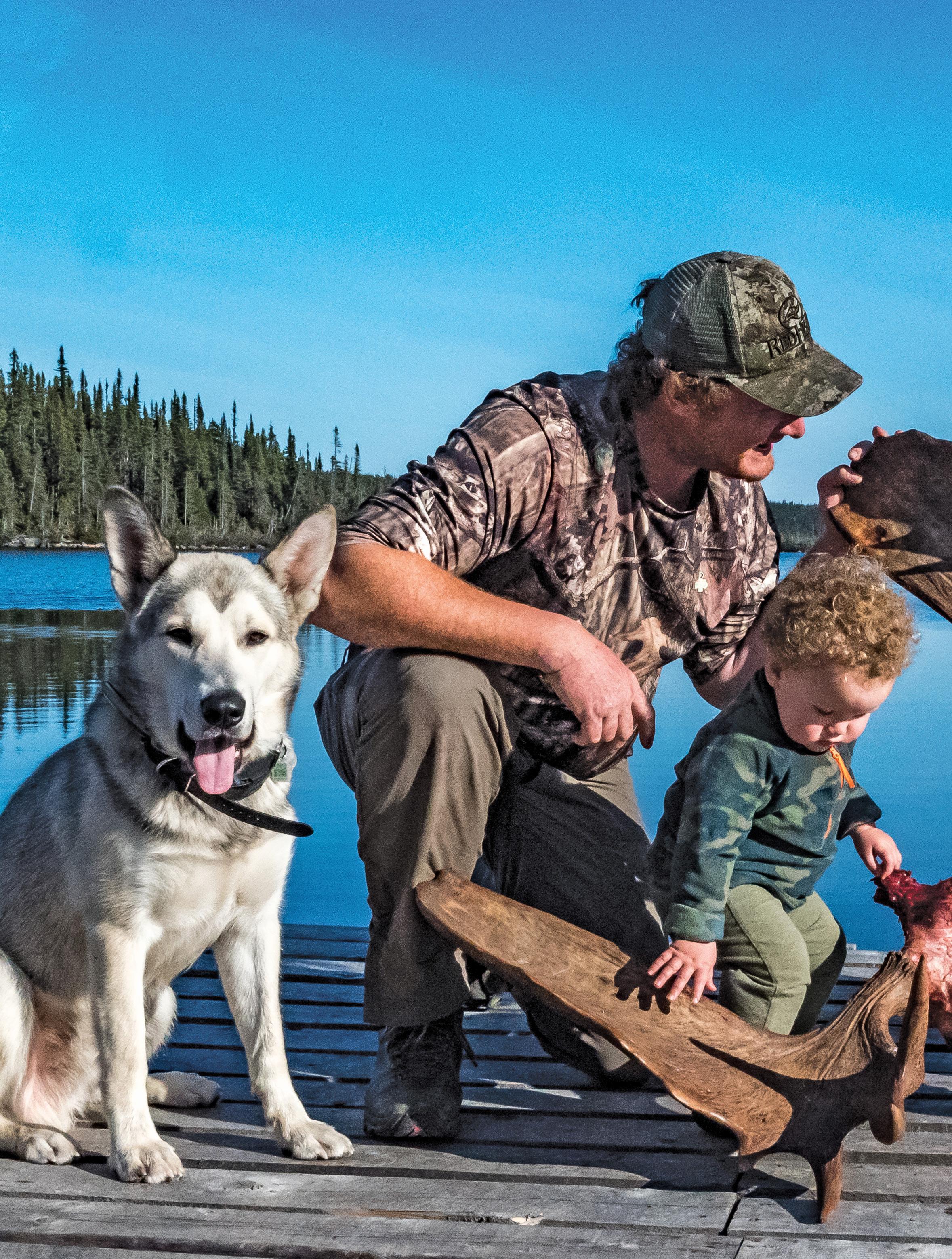
48 | OUTDOOR CANADA [ HUNTING SPECIAL 2023 ]
AFIELD
BY JIM BAIRD
Don’t let having young kids
The sun has not yet risen over the mountains to the east as my wife, Tori, and I navigate the icy dock to load our gear, two sons and pet husky into a de Havilland Beaver. It’s mid-October 2022, and we’re heading to a remote cabin in the interior of Newfoundland’s Great Northern Peninsula for a moose hunt. Our adventure didn’t begin here on the float plane dock on the peninsula’s eastern shore, though
“They came through Labrador,” our hunting outfitter, Leonard Payne of Portland Creek Outfitters, tells our bush pilot as he introduces us. And so we had, travelling by road all the way to Newfoundland from our home in Ontario. During our 10-day overland odyssey, we camped out of our off-grid teardrop camper, and now Tori and I were ready to continue with our boys on the next leg.
“It’s rare to see kids of that age come into remote moose camps,” Payne tells me as we board the Beaver, motioning to my sons, fouryear-old Wesley and 14-month-old Hudson. Maybe so, but as the float plane taxis and lifts off the water, I can see the wonderment in the boys’ eyes. I know it’s going to be another great experience for our entire family.
Many believe having children means your outdoor adventures must come to an end, but

keep you from your outdoor adventures, including backcountry hunts. With the right planning, you can bring them along instead
WWW.OUTDOORCANADA.C A | 49
»
The author and his family after their Newfoundland hunt
JIM BAIRD
that certainly doesn’t have to be the case. Take it from me—I’ve gone on all kinds of excursions with my kids, and in all seasons. I won’t sugar-coat it, though, as it’s definitely a lot of work. But the benefits of spending time outdoors with your children are definitely worth it.
Careful planning, outdoor skills and a good mix of bravery and humour are important elements for a successful trip with youngsters. Whether you’re interested in camping with your kids for the first time, or you want to step up your hunting (or fishing) game as a family, the following nine tips can help make your next outdoor adventure a success.


#1 MIND THE ELEMENTS
Particularly during winter, you all need to wear proper clothing, including a merino wool base layer, a fleece mid-layer, a warm parka and snow pants. Good boots, a toque and mittens are also key, and always pack extra handand toe-warmer heat packs. On cold days, my wife and I swap out our kids’ warmers every five hours or so. If you’ll be camping during
winter, a canvas tent and portable wood stove is the way to go, along with warm sleeping bags and good ground pads.

In the summer, meanwhile, fast-drying noncotton clothing, widebrimmed sun hats and good rain gear are the apparel of choice. I recommend dressing kids in longsleeved rash-guard tops to help keep them cool, while also protecting them from the sun. During bug season, bring bug shirts, familyfriendly mosquito repellant and a screened-in bug shelter. No matter the season, the goal is to ensure your kids are always comfortable out there.
child floating face up. Of course, teaching your children how to swim as early as possible is also priceless when it comes to water safety.
When camping, avoid sites with cliffs or jagged rocks in favour of flatter areas set back from the water. Be particularly alert around camp if you’re travelling with toddlers, as they require constant supervision. If you need a few minutes to take care of something, zip your young ones into a tent momentarily with some toys, but overall, plan to always have an adult at their side. And if you’re hunting, practise the same firearms safety around camp as you would at home to keep guns out of little hands.

The earlier you set out, the easier the overall trip
#3 SET OUT EARLY

#2 PLAY IT SAFE
If you plan to be on the water at any point during your trip, equip your kids with high-quality, properly fitting life jackets, designed for their weight. Opt for a life jacket with large collar flaps to support the child’s head when in the water; it should also be designed to keep the

Before setting out, take a basic wilderness first-aid course that includes specific advice for dealing with sick or injured children. Likewise, make sure to modify your first-aid kit to also accommodate kids. For example, include items such as child-strength antihistamine, acetaminophen and ibuprofen. And throw in some bandages with dinosaurs on them while you’re at it.
Finally, if you’re travelling far into the backcountry and won’t have cell service, bring some form of alternative communication device, such as a satellite phone or emergency beacon, to summon help in case of an emergency. And as with any lengthy outdoor sojourn, leave a copy of your itinerary and planned travel route with someone back home.
Everything takes a lot longer when you have kids. This is especially true when you’re preparing to bring them on an outdoor adventure. Plan the day with the goal of getting started early, then get up an hour or two earlier still. Doing this will make things less stressful and safer, because you won’t be rushing. Plus, you’ll get to camp earlier and generally just have more fun. And if others are expecting you, be prepared to impress them when you show up early with the whole family in tow.
#4 MANAGE YOUR EXPECTATIONS
It’s not going to be like it was when you headed out with your significant other or your buddies before you had kids. Instead, you’re going to have to scale back your expectations when it comes to the distance you plan to cover, or the amount of hunting and fishing you expect to do. For example, instead of planning to portage three lakes deep into the back-
50 | OUTDOOR CANADA [ HUNTING SPECIAL 2023 ]
Raingear and life jackets are key for boat travel
Protecting kids from rain, cold and the sun is essential
Expect to hang around camp more than on solo trips
country in search of trout, plan to portage to just one lake. Or instead of hunting for eight hours a day, plan to stay out for just four. Include the kids as much as you can, and share the supervision and camp duties with your partner. Remember, teamwork makes the dream work.
When you cut back the intensity of your activities from what you’re used to, it can feel a little discouraging at first. While it’s true the adventures aren’t going to be the same, I can assure you they aren’t going to be lame, either. They will just be different, and once you wrap your head around that, you’ll realize it’s still amazing to be out there. And the memories you create will be just as good as, or even better than, before.
You’ll also realize that scaling back your trips doesn’t make them any easier. The challenges may be different when you have kids along, but they’ll still test your problem-solving skills every day. And as with any outdoor adventure, the ability to overcome those challenges will ultimately be fulfilling. Also know that the added concern you’ll have for the well-being of your children will make a scaled-down trip still feel like a large-scale adventure. Remember, a little fear is a good thing, as it leads to more meticulous planning and better decision-making in the field.
#5 THINK OF YOURSELF
With all the preparation needed for a big trip with kids, it can be tempting to just decide to stay home instead. So, why should you head into the wilds with your children? For start-
ers, outdoor adventures with family will get you out more. With the amount of outdoor adventure many of us crave, there’s just no way we can do it all without including the family, in part because we simply don’t want to be away from them for too long. And with more outdoor time for you, it will make you more fulfilled in the long run (don’t worry, it’s okay to be a little selfish in this context).
#6 EMBRACE THE DIRT
When camping, most of us loosen up on our personal cleanliness, and the same should apply to kids—it would be impossible for you to have a good time while constantly trying to keep them clean anyway. Bringing some extra baby wipes and hand sanitizer can help, but let’s face it, your kids will most likely have dirt on their hands and faces for prolonged periods of time. Remember, when children are exposed to germs early in life, it helps their body learn to defend itself from pathogens. So, relax and let them get messy—it’s good for them. And there’s a lot that can be learned from simply playing in the dirt.
#7 EXPECT THE UNEXPECTED
When venturing into the backcountry with your family, time should not dictate your itinerary—safety and the weather should. Even if you’re just taking the kids on a day hike, always bring along basic survival gear, including a small flashlight, a lightweight tarp, extra gra-

If taking your kids afield gets you out more, that’s a win
nola bars and multiple ways to start a fire. You never know when or why you may unexpectedly need to spend the night on the trail. And if you’re prepared, it won’t be the end of the world.

Remember, too, that the
long trips, be ready to set up camp almost anywhere if the kids are having a meltdown and it’s getting dark.



#8 IGNORE THE NEGATIVE
Since I’m active on social media, I regularly upload videos of my family adventures. Unfortunately, my posts often garner discouraging comments from people who think I’m being irresponsible and endangering my children. Safety is always my top priority, however (see tip #2). Indeed, if you use common sense and have solid outdoor skills, your kids are in more danger as passengers in a car and more likely to get sick from going to school than they are when camping.
more experience you have in the backcountry, the safer your family will be. So, before you head out, buck up on the essential survival skills, such as starting a fire and rigging a tarp for shelter. Also, always bring extra food and water in case the trip takes longer than anticipated. And on days-
So many people have been detached from nature in today’s world that most outdoor actives fall well beyond their comfort zone. They’re often well-meaning people who simply didn’t have the privilege of being raised in the outdoors, and they can be frightened by things they don’t understand. If you’re considering taking your kids into the backcountry and have someone in your life who is openly concerned for their safety, it is likely
» WWW.OUTDOORCANADA.C A | 51
Be prepared to set up camp at a moment’s notice
Don’t stress about constantly keeping kids clean
coming from a good place. You can take their thoughts into consideration, but ultimately rely on advice instead from child psychologists, pediatricians, early childhood educators and other parents with experience in the outdoors.



#9 REAP THE BENEFITS
I believe young children who get to experience outdoor adventures develop faster both physically and mentally. They learn practical skills such as paddling, hauling wood and lighting fires, and in turn come to enjoy hard work. At the same time, they learn a lot about nature and develop a
love of the outdoors, making their lives all the richer for it.
Due to a rare genetic syndrome, my older son, Wesley, has some considerable developmental challenges that prevent him from walking and talking. His therapists have often reiterated how spending time in nature is good for any child, but that it’s especially beneficial for children with disabilities. My wife and I can see how he loves our adventures, and we’ve seen him improve
over time because of the outdoors. He’s become more engaged and aware of his surroundings, and he’s learned to sit up on his own, no doubt due to building up muscles from sitting in the canoe and around camp.
37

My youngest son, on the other hand, learned how to snowshoe at 16 months. By that age, he’d also learned to carry wood and put it on the fire all by himself. And don’t worry—since the age of one, he’s known that fire is hot, and to not
get too close. His balance is also impressive for his age because of all the uneven ground he’s been navigating during our outings. The skills and knowledge he’s already acquiring as a small child will ultimately help him become selfreliant, and build his confidence. From my experience, it’s amazing how little it takes to positively influence a child in the outdoors—and that alone makes family adventures into the wild more than worth it. OC
JIM BAIRD ’S NATIONAL GEOGRAPHIC TV SHOW, HOME IN THE WILD , FOLLOWS HIS FAMILY’S ACTIVE OUTDOOR LIFE.
8
WHAT’S ON JIM BAIRD’S PACKING LIST FOR OUTDOOR FAMILY ADVENTURES? SEE WWW.OUTDOORCANADA.CA/FAMILYGEAR.
C M Y CM MY CY CMY K outdoorcanadabcmayjune2023f.pdf 1 2023-03-23 9:39 AM
Your kids will be all the better for the outdoor experience

























GET OUTDOORS ALL YEAR LONG BONUS: 50 PRO TIPS FOR HUNTING (& CATCHING) MUSKIES Hunting SPECIAL ISSUE HUNTING SPECIAL $9.99 www.outdoorcanada.ca CANADA’S ONLY NATIONAL HUNTING & FISHING MAGAZINE STRATEGIES, GEAR, DESTINATIONS, TRENDS HOT SPOTS GUIDE 50 WHITETAILS BEARS MOOSE CARIBOU MULE DEER SHEEP ELK & MUCH MORE! 2022 5MOOSECALLING ESSENTIALS TOP BUCK SECRETS FIELD STRATEGIES FOR DOWNING MORE DUCKS THE FORGOTTEN ALLURE OF GUNNING FOR SNIPE + 2022 FLY - FISHING BASICS •CHANNEL CATS •FISHING HATS 50HOT SPOTS! • MUSKIES BASS • WALLEYE • TROUT • PIKE SALMON PANFISH & MORE! HOT SPOT #32: ONTARIO’S LAKE ST. CLAIR ALL- NEW GEAR GUIDE CATCH MORE FISH WITH LEECHES MEET THE ORIGINAL IZUMI p 40 EXPERT FAVOURITES of Canada’s Great Outdoors Celebrating FISHING HUNTING CONSERVATION SPECIAL 50TH ANNIVERSARY EDITION BONUS PHOTO CONTEST WINNERS REINDEER LAKE ADVENTURE SUMMER 2022 $7.99 www.outdoorcanada.ca CANADA’S ONLY NATIONAL FISHING & HUNTING MAGAZINE Order online outdoorcanada.ca/subscribe Call 1-800-663-7611 service@outdoorgroupmedia.com MAILED RIGHT TO YOUR DOOR
LOFTY


When you’re obsessed with sheep, the Yukon’s high country beckons. The tale of one hunter’s quest for a really, really old ram

54 | OUTDOOR CANADA [ HUNTING SPECIAL 2023 ]
How do you know he’s old?” I asked.
“It’s easy. Look for a swayback and a pot-belly. Then look at the face. Is he bright-eyed? If he looks kinda out of it, he’s had a good, long life and he’s not getting around very much anymore.”
“He lays around, and thinks about what used to be, but he doesn’t have the zip to do it again.”
“Probably has poor teeth, too. That’s why he might be a loner, and really cranky. Nobody wants to put up with him.”
“Swayback, pot-belly, looks dull in the face—shoot that one.”
I straightened my back, sucked in my stomach, opened my eyes a little wider and smiled brightly. “I can do that.”
“And look for dark horns, broomed and chipped up a bit. That’s a fighter.”
I was remembering those snippets of conversation as spring rolled around back in 2018, gems of wisdom disguised as advice at a Yukon sheep hunters’ gathering. They were terms of endearment, too, for old Dall’s rams, seemingly disparaging remarks, yet directly correlated to admiration.

Soon after, my limited entry sheep permit for zone 7-22 arrived in the mail from the Yukon Department of Environment. That’s the Game Branch, for you other old-timers. I was elated. “This year, we go up there and look for a big old ram. And if we can’t find a really, really big one, we’ll try for a really, really old one,” I said to my then 35-year-old son, Graeme.

In our family, when you say “really” twice, you really, really mean it. Some people add cuss words or swear for emphasis. That’s not the Mennonite way. We just say “really, really,” and add “for sure” if needed.

“Let’s do it,” Graeme replied. “For sure.”
Two weeks later, another letter arrived from the Game Branch: permit rescinded. Oh well, I thought, there are old Dall’s in other places, so I did some research. How old is old for a ram? Surely, Google had an answer for that, too.
I found a study on ram mortality by wildlife biologist Olaus Murie, conducted long ago in Alaska’s Mount McKinley National Park, now called Denali. He collected the horns of 608 rams—all dead, of course—and counted the annuli, or growth rings.
The study included lots and lots of numbers on a chart. They were meaningful. They were all over the page, with no pictures. It was exhausting. Better come back to this some other time, I thought.
Then two weeks later, another letter came. The permit was now “unrescinded.” God works in mysterious ways. And so does the Game Branch, it would appear.
With the hunt back on, I made a strong cup of coffee and revisited Olaus Murie’s ram mortality chart. Aha! There were some words there I hadn’t seen last time. They explained the numbers. The 608 Denali rams had been “extrapolated,” or turned into 1,000 for statistical comparison. So, how many rams per 1,000 lived to be 10? The chart said 439. Another 252 made it to age 11, and 96 lived to be 12. After that, only six lived to be 13, and just three saw the age of 14. Beyond 14? Well, let’s just say this is no country for old men.
In the two weeks allotted for our hunt, we expected to see no more than 100 rams. That was only a tenth of the Denali study’s total, so I simply divided the data by 10 to get a picture of what we might expect to find. Our goal was to get a 13- or 14-year-old. According to my calculations, however, there would only be 0.6 of a 13-year-old and a mere 0.3 of a 14-year-old. That’s not even a complete ram when you combine the two age groups.
»
“ WWW.OUTDOORCANADA.C A | 55
»
The author at the successful end to his quest
GRAEME PETERS
Such meagre math didn’t dissuade us, though, so we carried on, turning to social media for hints on finding a worthy ram. I typed in “plenty of rams.” Pictures of a California football team popped up. Clearly this was not the right strategy. We had to do something real—go to where the Dall’s live, and look them over in person.

Early that August, Graeme and I did just that up in zone 7-22, nestled in the Yukon’s Coastal Mountains east of Kusawa Lake. We looked. And we walked. It was hot. The rams were also up high, bands of plentiful bright-eyed youngsters with straight backs, six-packs and light-coloured horns, thin and beautifully tipped out, some above the nose. It was quite a collection of six- and seven-year-olds. But where were the veterans? Had the warm spell in January melted the snow and covered the grass on the winter range with ice, starving them? Was it the late spring? Was it wolves?
After three days, we moved camp to the other side of the zone. We saw lots more of the same until the sixth day. Far in one corner we found them, a group of seven. Very Canadian. One ram, in particular, stood out. It was very special. Not really, really big, but really, really old. He had it all: a swayback, a pot-belly, battered up dark horns, and a face that could sink 1,000 ships. This guy had character. But we let him be.
Why? Commitment
issues. It’s generational they say. Leave your options open. Besides, if we took a ram, our hunt would be over. Did we want to go home, sit on the deck for the rest of the season and watch robins hop around on the front lawn? Nope. And so we left the mountains with light packs.

Two weeks later, though, we were back. Rams move around more than you might think, so we were hoping a really, really big and really, really old ram might show up out of somewhere. It’s happened before.
Our second hunt went much like the first one, except that no hunts are ever quite exactly the same. We ran into a grizzly at 50 yards, then encountered another large boar draped over a ripe, half-eaten sheep carcass, its belly distended. Neither of them wanted us, thankfully. Why? Commitment issues. Or perhaps we didn’t smell right.
After three days of hunting, we found the group of seven again. Pure white
they were against the brown sandstone next to a pale green slope, with dark fir trees below and a turquoise waterway bottoming out the valley. The ram with the dark, broomed-off horns was bedded down on a promontory slightly above the rest.


earlier brush leaves he stripped off with his gums. Three front teeth, hollow haunches and little fat were what we found when we dressed him out. What would his last days have been like if my other son, then 16-year-old Jody, had not taken him that October? (See photo above.)
Graeme took a long look through the spotting scope. “Better take him, Dad,” he advised. “That’s a really, really great ram.”
“Let’s do it,” I said. “For sure.”
Graeme planned the stalk: stay above them, out of sight, crawl to the edge of the slope, then take care when you peek over. It took us about an hour, giving me lots of time to think about old rams and memories. I thought of an Ernest Thompson Seton story I’d read as a kid called “Krag, the Kootenay Ram,” about the haunting of a hunter remembering what had been. Then I recalled the ancient 14-year-old ram we watched a number of years earlier, getting by on buck-
Then I contemplated the old ram below us on the rampart, gazing past his cohorts over the vast extended valley framed by forest, cliff and mountain. Was he also in his last summer? I thought of the Dylan Thomas poem “Do not go gentle into that good night,” and wondered how many more years I would walk the alpine trails with my boys, now strapping young men who could carry more and walk just as far as their father.
Of old rams and old men, dignity and endurance, courage and camaraderie, adventure and contemplation, beginnings and endings—all these thoughts pile up and mingle freely in thin air and high places.»
56 | OUTDOOR CANADA [ HUNTING SPECIAL 2023 ]
The author’s sons, Jody (left) and Graeme, with their 14-year-old Dall’s rams, taken years
WWW.OUTDOORCANADA.C A VERN PETERS










in AURIC ™ Concealment COLD FRONT PARKA browningcanada.ca 23-BCA-149_AURIC_Apparel_Ad_Cold_Front_Parka_8.25x10.5.indd 1 6/1/23 8:05 AM
I took off my hat and slithered forward, up and over the large, flat rock just below the rim. “He’s going to be exactly 200 yards below us when we get to that rock,” Graeme said, motioning ahead as he outlined the stalk. Interesting, I mused to myself. Twenty years earlier, I judged the sheep, planned the stalks and called the shots. Now Graeme did. How does that happen?
The wind was behind us, rising with the warm afternoon sun and taking our scent up and over the rams. No hurry here. We both took another look through our binoculars.
“He’s got good weight. Really, really heavy,” Graeme said.
I poked the rifle over the rim, rested my hand under it and waited until Graeme was right beside me with his binos trained on the ram. The crosshairs settled and I gently squeezed.
“Too high, wait.” Graeme’s voice was now my command. “He’s moving to the right. Don’t shoot. Ram in front of him. He’s the one still moving to the right. He’s furthest to the right now, in the clear. Wait, he’s coming up toward us. Wait till he turns. Gotta aim lower, Dad. Okay, now!”

The ram fell, rolled twice and stopped. I scrambled to my feet and was lifted way up into the air and squeezed with a giant bear hug. “I’m so proud of you, Dad! Good shooting—eventually,”
Graeme said, and laughed.
“Just like your old ram in the glaciers,” I said, recall-
ing the 14-year-old Dall’s he took in 2001. “Had to shoot over him a couple of times to make him run towards you.” (See photo, previous page.)
We slid down the shale and onto the green slope. “At least 12, probably 13 years old,” I said when we reached the ram. Then I counted the annuli, starting at number three since he was broomed off past the second ring. He was 13, later confirmed by wildlife technicians at the Yukon Department of Environment.

“Twenty-five,” Graeme announced.
“Twenty-five what?” I asked.
“Twenty-five years of us hunting sheep together.”

Suddenly, that very moment, and the hunt, took on all the more significance.
We took a number of days to pack out the ram. Why hurry? The alpine in late August is beautiful, after all, and loved ones appreciate you more if you come home late. Plus, sheep meat is a pleasant burden, and the sight of gnarly old horns on top of a heavy pack never gets old.

The mount of my old ram is now in a place of honour in my home in Whitehorse. Below it is a belt buckle with the engraving “Oldest Ram 2018 taken by a Yukon Fish and Game member,” a plaque commemorating “25 Years of Sheep Hunting, Graeme and Dad,” and a framed picture I took from the treeline of zone 7-22, showing a few scraggly old alpine firs silhouetted against the azure lake far below. “It’s a Group of Seven photograph of where
the ram lived,” I tell visitors. The mounts of the two 14-year-old rams taken by my sons are on either side of my Dall’s. Their horns are also dark, battered up and broomed off. One has an old bullet hole near the tip. And in the bleak days of mid-winter, when all is frozen outside and blanketed in snow, my boys and I gather to gaze at the three old rams. We pour a shot of well-aged whisky, sip slowly and cast our minds back to the bright sunshine, high alpine meadows, towering peaks and shimmering lakes far below. Most of all, we consider the old rams, and memories of the hunts. They haunt us still.
They really, really do. OC
YUKONER VERN PETERS HAS BEEN PURSUING SHEEP FOR MORE THAN 50 YEARS.

58 | OUTDOOR CANADA [ HUNTING SPECIAL 2023 ]
VERN PETERS (PACK, MOUNTAIN VISTA); GRAEME PETERS (VERN PETERS)
WWW.OUTDOORCANADA.C A
Ram country (clockwise from top left): The alpine vista where the hunt took place; the author’s pack; the hike out






















BOOKS ABOUT THE OUTDOORS BROWSE OUR STORE VISIT OUR BOOKSTORE FOR MORE GREAT READING! SHOP.OPMEDIAGROUP.CA 1-800-663-7611 NATURE • ADVENTURE • MARINE • OUTDOORS • HISTORICAL • FISHING • AND MORE! Buy Local
BY RICK BRYNE
UP IN THEAIR
A primer on the challenge and thrill of hunting upland birds, waterfowl and small game with trained birds of prey


A

MARK ADAM
gyrfalcon-prairie falcon hybrid chases a sharp-tailed grouse
60 | OUTDOOR CANADA [ HUNTING SPECIAL 2023 ]
The falcon climbs into the clear blue Saskatchewan sky as the falconer lets his dog out of his truck, sending it into the field to find the grouse that just landed in a small patch of cover. The dog quickly finds the birds’ scent and goes on point. The falconer looks skyward to locate the falcon, which is now more than 600 feet up and still climbing while circling above the dog.
After letting the falcon make one more loop, the falconer commands “flush” as the raptor passes over the dog. With that, the dog rushes in and seven sharp-tailed grouse rise into the air. The falcon folds her wings back and begins her stoop, or dive. Reaching a breathtaking speed of some 200 kilometres an hour, she intercepts a fleeing grouse and knocks it to the ground, leaving a trail of feathers in the air. The falcon then wings over and lands on her prize. This is the very moment the falconer has spent a year or more preparing for—a hunt with no weapons other than two living hunting partners, a falcon and a bird dog.
Many hunters and anglers aspire to level the playing field, upping the ante by taking their pursuits to the next level and making them more challenging. Hunters may restrict themselves by only using muzzleloaders or longbows, for example, while anglers may opt to only use light tackle or fly rods. Falconry takes it one step further by using a trained bird of prey as the means for taking game. Want to spread your wings and give falconry a try? Here’s an overview of what you need to know to get started.
THE BIRDS OF PREY
Falconry is the sport of hunting wild quarry with birds of prey, or raptors, which includes falcons, hawks and eagles. It has been practised for many thousands of years, reaching its pinnacle in Medieval times when the aristocracy embraced the sport. Even now, falconry continues to enjoy a small community of devotees (see “The raptor ranks,” next page).
A raptor used for falconry is not a pet, but rather an important member of a hunting team that also includes the falconer and typically one or more dogs. Not all birds of prey are suitable for falconry, however; it depends on whether the raptor’s style of hunting and typical prey are compatible with the sport and the interests of the falconer.
For example, large falcons are ideal if the quarry is primarily waterfowl or upland game birds, as is the case on the Canadian prairies.

Smaller falcons, such as the merlin, are held in high esteem simply because of their dramatic pursuit flights, even when the quarry is only a small bird such as a sparrow or starling. Hawks and eagles are more suited to hunting mammalian prey such as rabbits and squirrels, which are often found in areas close to large urban centres. Then there’s the centuries-old practice of hunting foxes with golden eagles on the Asian steppes, which has been highlighted recently in several documentaries.
In many areas where permitted, wild raptors can be taken from the nest when they are young, or trapped during the fall migration, for use in falconry. However, more and more falconry birds are now produced through captive breeding. In the mid-1900s, for example, falconers developed techniques to breed peregrine falcons in captivity when their populations were threatened by pesticides. This included the production of hybrids among species, sometimes providing falconers with birds specifically suited to their needs.
Today, in fact, many falconers prefer to fly hybrids between peregrines and gyrfalcons. That’s because the peregrine is noted for its tendency to “wait on,” circling high above its intended quarry, then providing a spectacular, highspeed stoop. The gyrfalcon, meanwhile, provides the size (it is the largest of the falcons) and the hardiness of an Arctic resident, which helps when the temperatures drop below -20°C on the prairies.
THE PREY
In the flat lands of western
Canada, ducks and geese are the most common prey hunted with large falcons, with the abundance of small ponds most years providing ample opportunities. The most challenging of all western Canadian prey species is the sharptailed grouse, a formidable quarry for falcons. Sharpies are big, strong, fast birds, yet still highly manoeuvrable. They have the ability, unlike the pheasant, to fly long distances, and if your falcon is not in great shape, it won’t keep up. Some hunters might be surprised by the way sharptails respond when being attacked by an avian predator, compared with their rather slow flap-and-glide response to being flushed under the gun.
As for eastern Canada with its more forested regions, it sees more falconers using birds such as red-tailed hawks and goshawks to pursue rabbits and squirrels.
THE SET-UP
Hunting with trained raptors entails much more skill and effort than hunting with a firearm, which can be cleaned and stowed away until the next season rolls around. Falconry birds require a suitable enclosure »
» WWW.OUTDOORCANADA.C A | 61
Gyrfalconperegrine hybrids are a popular choice
with perches, and they must be fed and cared for daily. For most forms of falconry, an appropriate dog is generally also a necessity for success. As with the bird, it needs to be cared for throughout the year, too, complete with countless hours of training and conditioning.

Specialized equipment, often made by falconers themselves, is also required. This includes leather hoods for the birds,
THE RAPTOR RANKS

gloves (or gauntlets) for the falconer, leashes, lures for training, and so on. Modern falconry also now includes the use of kites and drones for training, and radiotelemetry technology for locating lost birds. Most recently, falconers have
FALCONRY IS PROBABLY the most highly regulated hunting sport in the world. Here in Canada, birds of prey come under the jurisdictions of the individual provinces and territories, each with its own set of regulations that may differ considerably. All birds of prey used in the sport, however, must have a special permit and leg band issued by the respective provincial or territorial wildlife department.
Owing to the varying regulations across jurisdictions, most provinces and territories have their own falconry clubs or associations. The Saskatchewan Falconry Association (SFA) is the oldest falconry group still in existence in North America. It was founded in 1958 by the late Richard Fyfe, a Canadian Wildlife Services biologist, and a handful of would-be falconers. The association’s membership has always remained small, with never more than 20 active members at one time.
Now a branch chapter of the Saskatchewan Wildlife Federation, the SFA has been involved with conservation efforts for decades, starting with the successful fight to attain legal protection for birds of prey in the 1960s. The group has also long been involved in digging nest holes for prairie falcons; banding records indicate more than 1,200 prairie falcons

been using GPS transmitters connected to a smartphone app for tracking the location of their birds in real time. This has resulted in far fewer lost birds.
A common misconception is that a trained raptor can catch a bird with ease,
then bring it back to the falconer. In reality, however, regular success is difficult to achieve, and the birds do not deliver their catch to the falconer. Instead, the falconer must typically search for the raptor and its downed quarry, often with the help of radio telemetry if the kill took place far away.
Whatever the case, nothing beats the feeling when it all comes together—with the falconer, dog and raptor working as one. OC
have fledged from these artificial holes to date.
Also significantly, the SFA became involved in the captive-breeding and reintroduction of peregrine falcons when this magnificent bird was classified as endangered due to pesticides such as DDT. In 1976, the Saskatchewan Cooperative Falcon Project was formed as a consortium of the SFA, the Western College of Veterinary Medicine and the then provincial game department. Its main focus was the construction of a breeding facility, where more than 500 peregrines were
produced for release and sent to sites in the U.S. Midwest and Canada. Members of the SFA were also politically active and played an important role on the Canadian Peregrine Falcon Recovery Team.
Today, the ongoing mission of the SFA is to improve and encourage competency in the ancient art of falconry among those who are prepared to make a commitment to the sport. Members must also commit to the conservation of birds of prey and the quarry they pursue, while promoting their value and role in nature.

62 | OUTDOOR CANADA [ HUNTING SPECIAL 2023 ]
SFA PRESIDENT RICK BRYNE SUBMITTED THIS ARTICLE ON BEHALF OF THE SFA.
MARK ADAM
A trained gun dog is key to falconry success
WWW.OUTDOORCANADA.C A
8
INTERESTED IN BECOMING A FALCONER? VISIT THE SFA AT WWW.SASKFALCONRYASSOCIATION.COM.
Conservation is a major aspect of falconry













New Contests Added Monthly Your Favourite Episodes Online Fishing HOTSPOTS HOW-TO’s From Ang & Pete New Bloggers As well you can watch, hear, find and follow us on: facebook.com/FishnCanada @fishncanadaofficial on IG Spotify & Apple podcasts “Outdoor Journal Radio” FishnCanada1 on Twitter YOUR PORTAL TO ALL THINGS FISHING
FORAGE FREE-FOR-ALL
BY GORD PYZER

64 | OUTDOOR CANADA [ HUNTING SPECIAL 2023 ]

WWW.OUTDOORCANADA.C A | 65 »
LEARN THE LAKE
The first step is to understand that most of our lakes are split into three separate and distinct zones of water from late spring through autumn. First there’s the warm 25- to 35-foot upper layer of surface water, known as the epilimnion. Then there’s the deep cold basin zone known as the hypolimnion, and separating the two is the eight- to 15-foot belt-like layer called the metalimnion, or thermocline. It functions like an invisible barrier restricting movement between the upper and lower sections. You can’t see it, but if you dive down into it, you will feel it, because the water temperature will plunge at least one degree per foot of descent.
Locating the thermocline is critical, because it’s the zone where ciscoes gravitate and thrive. It’s so profoundly important, in fact, that many biologists refer to it as the “cisco layer.” I like to call it something else—the shooting gallery. That’s because ciscoes bunch up so tightly in the thermocline that predator fish shoot up and down into it to get their favourite food.
Fish are cold-blooded creatures, so the only way they can regulate and control their body temperature is to swim in water that has the ideal temperature for their survival. Walleye, bass, pike and muskies are referred to as warmor cool-water fish because their preferred temperatures are found within the epilimnion. Lake trout, burbot and whitefish, on the other hand, are cold-water loving species, with their optimal water temperatures typically found in the hypolimnion. Again, ciscoes are sandwiched between those two precincts, with their greatest abundance typically found in water temperatures ranging between 10°C and 14°C.

“Ciscoes dominate the thermocline due to the competing tradeoffs between food availability, predation risk and metabolic drivers like temperature and oxygen concentration,” Therrien says. “At the thermocline, zooplankton densities are highest as a result of seston accumulation (carbon debris)
that zooplankton feed on between the epilimnion and hypolimnion. Zooplankton is the major component of cisco diets, so it is profitable for them to stay at that depth.”
In terms of predator avoidance, the thermocline is an advantageous habitat for ciscoes to be in, as their major predators have more generalist foraging strategies. “If ciscoes can move away spatially from the other sources of prey, then their predators have to make a choice to pursue them,” Therrien says. “We can hypothesize that not all predators will make that decision, and some will instead forage for other prey away from them.”
The thermocline also has the optimal temperature and oxygen concentration that ciscoes require. “This is important, because to avoid predators, ciscoes need to optimize their metabolic rate, while keeping it low enough to not unnecessarily lose energy,” Therrien says. In short, ciscoes know they have a target on their backs, and that the predators have their crosshairs on them. The trick for anglers is to put that predicament to their advantage.
TARGET THE THERMOCLINE
Throughout the fishing season, before I even make a cast, I slowly drop down my water thermometer to the bottom of a deep section of the lake. I let it remain there for a couple of seconds, then slowly bring it back up the surface, where it tells me the exact temperature at every five-foot interval. I take particular note of the depth at the top and bottom of the thermocline, where the temperature drops dramatically, with the values ranging between 10°C and 14°C.
Let’s say we’re fishing for walleye and pike, and the thermometer tells us the top of the thermocline is located about 24 feet down, while the bottom is at 38 feet. Now it’s simply a matter of scanning an underwater contour map of the lake to identify every potential walleye and northern pike structure— underwater point, reef, saddle, rock pile and shoal—that comes into contact with this band of water.
I did just that on one of the steamiest August days on record
Cisco expert Christian Therrien (left) says predators find the silvery prey fish so delectable that they’ll vacate their preferred warm, shallow comfort zones and venture into much colder, deeper water to find them. Therrien says he’s caught smallmouth bass 40 feet down while trolling for lake trout and northern pike at depths of 90 feet, for example.
 CISCO MANIA
CISCO MANIA
66 | OUTDOOR CANADA [ HUNTING SPECIAL 2023 ]
Walleye inhabit the zone above the cisco-rich thermocline
several years ago while fishing with two anglers from Saskatchewan. We simply retrieved 3 4- and one-ounce jig heads tipped with six-inch swimbaits across mid-lake shoals that plateaued out at approximately the same depth as the top of the thermocline. And to solidify our chances of success, the swimbaits were silvery white in colour and slender, just like ciscoes. In all, we landed 11 walleye weighing more than 10 pounds, topped off by a 35-inch, 15-pound Goliath that was one of the biggest walleye caught in North America that year.
These days, I like to go a step further, using my Helix 12 chartplotter and LakeMaster VX chip and program in the top and bottom depths so I can see the high-percentage ciscobearing water highlighted in colour, where it intersects with each structure (see chart above). Talk about opportunity meeting preparation.

Throughout the open-water season, this strategy is responsible for many of the biggest pike, muskies, smallmouth bass and lake trout I

catch. And all it takes is navigating the subtle ups and downs of the thermocline based on the local weather conditions, and a change of baits or tweaking of presentations based on the targeted predator. For northern pike and muskies, for example, the only alteration or modification I typically make is to swap out the 10- to 15-pound monofilament or fluorocarbon walleye leader for an ultra-thin, nearly invisible 13-, 20- or 26-pound leader of tie-able stainless steel. When I hook a fish with my heavy paddletail, the only question is whether it is a walleye, northern pike or muskie. When I want to minimize catching walleye and concentrate more on big toothy critters, I’ll switch to a much bigger, cream-coloured Bondy Bait or Water Wolf Shadzilla. Typically, I vertically jig the Bondy Bait around the rim of the structure, keeping it within a few feet of the bottom at all times. With the Shadzilla, I cast it out and let it sink to the bottom before retrieving it back to the boat.
LET IT HANG
By now, the latest secret is out about catching cisco-crunching smallmouth bass, thanks to Kenora, Ontario’s Jeff Gustafson winning the prestigious 2023 Bassmaster Classic. Hanging a four-inch cisco-impersonating, fluke-style bait— super-glued to a 3⁄8-ounce Nishine Smelthead jig—is as simple and as deadly as it gets. About the only thing that will shock you is how many of the vicious strikes arrive at the side of the boat in the form of a giant walleye or mammoth northern pike instead. The fish just can’t tolerate seeing a lonesome solitary cisco above their heads, suspended in the middle of the water column. Watch your lure on the sonar screen and you’ll see a mark appear below it, then streak up and annihilate it. But wait, it can get even better. Let’s go back to that scenario where »
LOOK-ALIKE LURE
When angler Ken O’Brien caught his 65-pound Ontario record muskie (left) on Georgian Bay in 1988, he was trolling without a leader for whatever would bite. His bait of choice? Perhaps not surprisingly, a four-inch Rapala Countdown—the quintessential cisco imitation.
 CHRISTIAN THERRIEN (BASS, LAKE TROUT); GORD PYZER (WALLEYE)
CHRISTIAN THERRIEN (BASS, LAKE TROUT); GORD PYZER (WALLEYE)
WWW.OUTDOORCANADA.C A | 67
Target lakers and more where the thermocline intersects with structure (right)
Suspended cisco imitations will fool smallies, as well as coldwater predators
the water thermometer told us the bottom of the thermocline—the cisco layer—was 38 feet down. This time, slide over to a nearby 45-foot hump and dangle the same flukestyle cisco bait over the top of it. You can even use your electric trolling motor, set on a low speed, to slowly stroll the bait off the edge, over 50, 60, even 70 or more feet of open water. Just be sure you’ve got a good grip on your rod because the lake trout hiding in ambush in the shadows below will try to rip it from your hand. This tactic is so exciting and effective, I rarely troll for lakers anymore. What we’re doing here is calling up cold-water predators such as lake trout and whitefish to the base of the thermocline to attack our cisco-masquerading baits. At the same time, we’re pulling down the warm-water plunderers to the top of the roughly 15-foot-thick band of water, where a disproportionate amount of the predators’ favourite food is concentrated.
HIT THE FALL SHALLOWS

Like all good things, the ciscoshooting gallery shuts down with the erosion and eventual elimination of the thermocline during fall turnover. Instead of cisco-based patterns petering out, however, they actually strengthen instead— so much so you almost have to feel sympathy for these baitfish. Their Achilles heel? They spawn in late fall on shallow gravel shorelines and shoals, often in natural or windinduced current areas, such as constricted channels.
Knowing this, the biggest walleye, bass, muskies and pike, in particu-


ROOM TO GROW
The preferred water temperature for the growth and survival of many fish species changes as they mature and grow bigger. Large walleye and northern pike, for example, seek out deeper, colder water to reduce their metabolism and devote more energy to the production of eggs. They achieve this by moving more closely to the thermocline, where they can prey heavily, often specializing on ciscoes. It’s an outrageously brilliant adaptation.
68 | OUTDOOR CANADA [ HUNTING SPECIAL 2023 ] FREE PREVIEW! OCTOBER 1-31 CANADA SPORTSMANCANADA.CA
lar, will wait at the prime intersections and maraud the arriving migrants. It’s often a bloodbath, occasionally revealed by floating cisco carcasses on the water’s surface. For this reason, I always look for fish-eating birds, especially bald eagles and gulls, squawking chaotically and diving onto the surface, or perched up high in nearby trees.
The key is locating the best rock structures—including sea gull rocks, whale backs, shallow boulder shoals and saddles—that lie in the path of the incoming cisco schools. I have one favourite tiny island point on Rainy Lake, for example, where so many huge predators group up and wait for dinner to arrive that you can’t predict what will hit your bait next. One cast it will be a gargantuan northern pike, the next a double-digit walleye and the third a plump smallmouth stuffed with so many ciscoes it spits them out as you bring it to the net.

On another lake, I have a similar spot where it’s deep on one side of a piece of structure and shallow on the other. The same multi-species fall brawl plays out there, too. One time,

when my grandson Liam was young, we were duping chunky walleye by retrieving cisco-imitating paddletails. Liam hooked an obviously big fish, and I watched his rod double over dangerously as he yelled for me to grab the net. I took my time, thinking it was a large walleye. I barely had the net in my hand, however, when one of the biggest smallmouth bass I’ve ever seen erupted from the water right beside the boat, and cartwheeled four feet into the air. I swear it looked me straight in the eye as it twisted and turned— and spit the hook. Such is the drawing power of ciscoes. OC
ALSO SEE PAGE 24 FOR FISHING EDITOR GORD PYZER ’S NED RIG ADVICE.


GORD PYZER WWW.OUTDOORCANADA.C A | 69
Big pike will feed on late-fall ciscoes arriving to spawn

MIKE FITZGERALD 70 | OUTDOOR CANADA [ HUNTING SPECIAL 2023 ]
PRESSURE TACTICS
BY MIKE FITZGERALD
MANY ANGLERS, MYSELF included, prefer not to spend their fishing time competing with crowds for limited space. In my home province of Ontario, the congestion is especially noticeable on the Great Lakes tributaries that have autumn migrations of steelhead. Even if you have a full-time job and can only fish for a handful of hours on weekends, however, it’s still possible to find success on these heavily pressured steelhead waters. The secret is fishing in the places most other anglers overlook. Here’s how to find and catch your own secret stash of steelhead this fall.
THE CROWD FACTOR
STEELHEAD ARE FAIRLY predictable, in that they’ll stack up in the exact same places each autumn as they migrate up the tributaries (these same patterns should generally hold true with West Coast steelhead, too). Early in the fall, the fish sometimes stage in out-of-the-way parts of the river where they won’t be harassed by the spawning Pacific salmon, especially big chinooks, that migrate up the same rivers. As the salmon die off, however, the steelhead then move into the kind of classic pools and runs you’d expect to find them.
The problem is, many anglers know exactly where to find these pockets, so they get a lot of fishing pressure. When that happens, some steelhead drop out of the prime holding locations and move into smaller, less noticeable spots most anglers walk right past without giving a second thought. Those are the secret areas you want to find.
Just keep in mind that fishing for hidden steelhead is not a numbers game. These are the fish to look for when you can only get to the river on weekend afternoons, and the classic spots are thronged with crowds. The key to catching these hidden chromers is to do your research, then employ subtler-than-usual fishing tactics.

THE SECRET HIDEOUTS
IF YOUR HOME waters take an arse-kicking during the fall migrations, one of the best things you can do is explore the rivers well before the migration even begins. How early? I generally start in late July or early August, when the water is at its lowest. If you’re stuck in a heatwave and the tributaries are dry, there’s no better time to go scouting for steelhead hideouts. Also keep in mind that a particularly wet spring, with high runoff, can drastically reshape a river’s characteristics. So for that reason alone, I walk my favourite rivers at least once a year during summer, in case the spring
When fall’s angling hordes descend on your river’s most popular steelhead stretches, target these secret fish-holding spots instead
WWW.OUTDOORCANADA.C A | 71 »
Pressured steelhead will lurk in surprisingly small hidden pockets
floods created new hiding spots.
What exactly should you search for? For starters, take a walk both upstream and downstream of the popular fishing spots that are lined with anglers during the weekends. As you’re walking, look for nooks and crannies that seem like they could hold a handful of steelhead when the water gets much higher. One common spot is where a couple of boulders create a tongue, just big enough to fit two or three steelhead underneath. Shallow logjams or broken retaining walls can also be good.
Another one of my favourite places is where erosion has exposed the clay on the river bottom. Steelhead will often position themselves where the rocky bottom meets the clay, usually on a bend in the river, making them practically invisible. Add a tree hanging over the water to provide shade and protection from predators above, and you’ve got yourself a winner.
To really get the lowdown on spots such as these, I often peer into them using a GoPro camera mounted on a broom handle. You wouldn’t believe how many boulders on my favourite stream have
spaces under them just big enough to hide a steelhead. But without seeing them for yourself during low-water scouting missions, you would never know these spots were even there.
Sometimes when the camera doesn’t give me a good overall sense of an area, I’ll go snorkeling instead to get the full scoop. Some years ago while doing this, I discovered a crack in the foundation of a bridge support, directly beneath a major highway. I had already suspected something was going on beneath the surface there—the previous
autumn, I watched a large, fresh steelhead approach the support then literally disappear. As it turned out, the crack was large enough to hide a half-dozen fish during the fall run. That was in 2014, and since then I’ve watched plenty of folks walk right past it, not once stopping to fish.

As a bonus, these same spots where steelhead hide during the fall also act as fantastic holding areas during the peak of the spring migration, when the fish are bent on getting as far upstream as possible in the shortest amount of time.
THE SALMON INFLUENCE
GENERALLY, STEELHEAD DON’T like to mix with chinook salmon, but if the conditions are right in September, they will migrate into the rivers at the same time; the earliest I’ve found steelhead

on my home waters was September 10. When this occurs, as noted earlier, the salmon quickly displace the smaller steelhead, pushing them into skinnier, secondary locations. So, even if the fishing pressure isn’t heavy, it’s best to head straight
to those places. Steelhead will also sometimes position themselves downstream of spawning salmon to gobble up their eggs. While this isn’t as common as we all wish it would be, it does happen, especially if the salmon are spawning just upstream from a deeper holding area. In such deeper areas, the steelhead can avoid conflict with the exceptionally aggressive chinooks, yet still remain close to the eggs drifting by. The bigger the spawning riffle, and the more salmon that are using it, the more likely there could be a couple of steelhead downstream gorging on eggs.
Many anglers who look for these egg-eating steel-
head never find them, however, because they search too close to the salmon. Instead, start looking at least 10 to 15 metres downstream of the salmon, in the next spot where the depth increases. Even what seems like an insignificant depression in the river bottom can, and will, hold steelhead, especially if the water is high after a rainfall and the clarity is a bit off.
As yet another bonus, these same places are often the preferred fall hiding places of migratory brown trout. It can really light up your day when you’re fishing one of these hideaways for steelhead and also pluck out a couple of beautiful migratory browns.
72 | OUTDOOR CANADA [ HUNTING SPECIAL 2021 ]
72 | OUTDOOR CANADA [ HUNTING SPECIAL 2023 ]
In spring, steelhead will often hold in the same hideouts they used during the fall
Steelhead typically avoid chinook, but they will gobble up their eggs
MIKE FITZGERALD (STEELHEAD, ANGLER); MANUFACTURERS (NYMPH, BAIT)
THE TACKLE & TACTICS
THE IMPORTANT THING to remember when you finally start fishing the secondary spots you discovered is that these are pressured fish. Whether the pressure came from bigger spawning salmon or angling activity, these steelhead have fled from the places they feel most safe and secure. Secondary hiding spots also often require steelhead to expend more energy to stay in place, which means they need to take in more calories. Still, these are going to be nervous fish, and they will almost never take a big meal.
For bait, you can never go wrong with trout worms, or wrigglers, which are smaller than nightcrawlers and redder in colour. They’re sold at some bait shops, but you can also collect your own at night from April through to October immediately following a good rain. If I can’t get my hands on some lively wrigglers, I’ll usually run nymph flies or highly realistic, soft-plastic nymph imitations. Mayfly and stonefly nymphs, along with hellgrammites, can be absolutely deadly on pressured steelhead.


One of my favourite soft-plastics for steelhead is True North Baits’ Mini M’eh Fly, in the 1.3-inch size. I rig it on a size 10 Raven hook, with two small splitshot about a foot above it. With flies, stick with nymphs a size smaller than you’d usually use. I’ve had good success drifting versions with all-wire bodies, such as Brassies and Copper Johns. They’re small yet heavily weighted with a thin profile, so they can get down in front of the fish in faster water.
For delivering baits and lures, I use a medium-action, nine- to 11-foot-long spinning rod. The longer rod helps with getting a drag-free drift for this type of close-quarters fishing. I spool up with six-pound braid and add a six- or even four-pound fluorocarbon leader running from the float all the way to the bait. For fly gear, choose a nine-foot-long, 7- to 9-weight outfit, with a large-arbor reel to manage those drag-burning steelhead runs.
THE PERSISTENCE GAME
I CAN’T TELL you how many times I’ve done everything right, but still walked away from the river empty-handed. That’s fall fishing in pressured steelhead tributaries, for you. No matter how much water you cover, and how hard you fish, sometimes those hidden steelhead just aren’t there. But don’t give up on your spots. Autumn steelhead are notorious for slipping unnoticed into the tributaries, often in water conditions you’d never suspect a fish that large would tolerate. Try again a few days later, and you may well find them tucked against that shallow logjam or under that boulder, finally giving you a chance to pull up some hidden chrome. OC
ALSO SEE MIKE FITZGERALD’S HOMAGE TO “THE SIT,” NEXT PAGE.
REGS REMINDER
In many jurisdictions, the regulations covering autumn fishing in rivers can be quite complicated. Sometimes, steelhead will come up a river when the typical trout season is still open, but later in the season, the rules can change. And one tributary could have kilometres of legal fishing water, while another may only have a few hundred metres. Plus, the rules can change from year to year. With that in mind, always read the regs carefully to make sure you know exactly where you’re allowed to be—and when you’re allowed to be there.
Follow us on social media and keep up-to-date with Canada’s only national fishing and hunting magazine.



WWW.OUTDOORCANADA.C A | 73
effec-
Outdoor Canada magazine is published 6 times per year Order online outdoorcanada.ca/subscribe Call 1-800-663-7611 service@outdoorgroupmedia.com
The likes of Brassie flies and Mini M’eh Fly plastics can
be
tive options
HOMAGE
BY MIKE FITZGERALD
The sit
THOSE ENDLESS HOURS OF SOLITUDE, WATCHING THE HUNTING MAGIC HAPPEN

ITHINK ANY time spent afield is a privilege, but I’ll take that solo morning sit above all else. I’m talking about getting into position in the dark, finding the perfect spot with just the right vantage point and just enough cover that game won’t know you’re there. Or venturing under moonlight to that blind or stand you’d set up before the season even got underway.
For me, the why of the sit doesn’t matter so much as the when. If I were to have it my way, my sit would always begin before first light, before the landscape awakens and the legal shooting hours arrive. I want to hear the woods and marshes come to life, that harmonious morning choir of the wild filling the still air. It’s what I long for each spring and fall. I want to hear a shock gobble from across the field, and the whistling of wings above the cattails. And few things compare to the stillness of the morning woods or the cool breeze rustling through the marsh as you sit motionless, watching it all unfold.
As with the deer hunters of fall, I also like to take a sit in a treestand, albeit in June, after the blackflies have tapered off and the black bears are on the move instead. Mornings aside, I’ll also gladly soak in a spring evening’s dying southwest wind, letting the silence descend all around me, heightening my senses to all but the most subtle of movements below the stand. Unlike the autumn mallards that come screaming in from above, or the spring toms that alert the entire countryside, bears move like silent ghosts. All of a sudden, seemingly out of nowhere, they just appear. Deer hunters know the same feeling.
Wherever and whatever you hunt, and no matter the result, a good sit always leaves you wanting just one thing: to do it all over again. OC
HOMAGE BY BOB SEXTON WWW.OUTDOORCANADA.CA MIKE FITZGERALD 74 | OUTDOOR CANADA [ HUNTING SPECIAL 2023 ]
ONTARIO WRITER MIKE FITZGERALD INTENDS TO WATCH THE WILDS AWAKEN AS MUCH AS POSSIBLE THIS FALL.




































































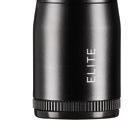
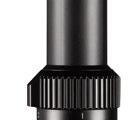

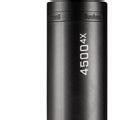
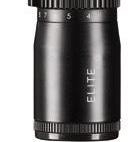
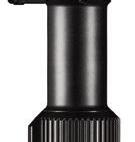
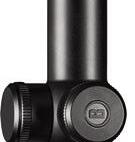
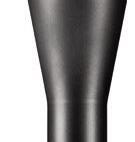
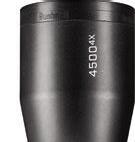
ALL THE OPTIONS, WITHOUT THE EXTRA COST. BUSHNELL.COM ELITE 4500 4X BEST IN CLASS, PROVE US WRONG! EXTRA-LARGE EYEBOX Puts you on-target with zero effort, and zero time wasted when your eyes are tired and the adrenalin’s pumping. 4X MAGNIFICATION Gives you four more options than you’ll find in any of its 3X competitors. EVERY HUNTING ADVANTAGE Superior optical quality and advanced lens coatings deliver true-to-life images so you can get it done no matter the conditions. LI FE TI ME IRONCLAD WARRANTY EXTRA COST. 2.5-10x40mm 1-4x24mm 4-16x50mm
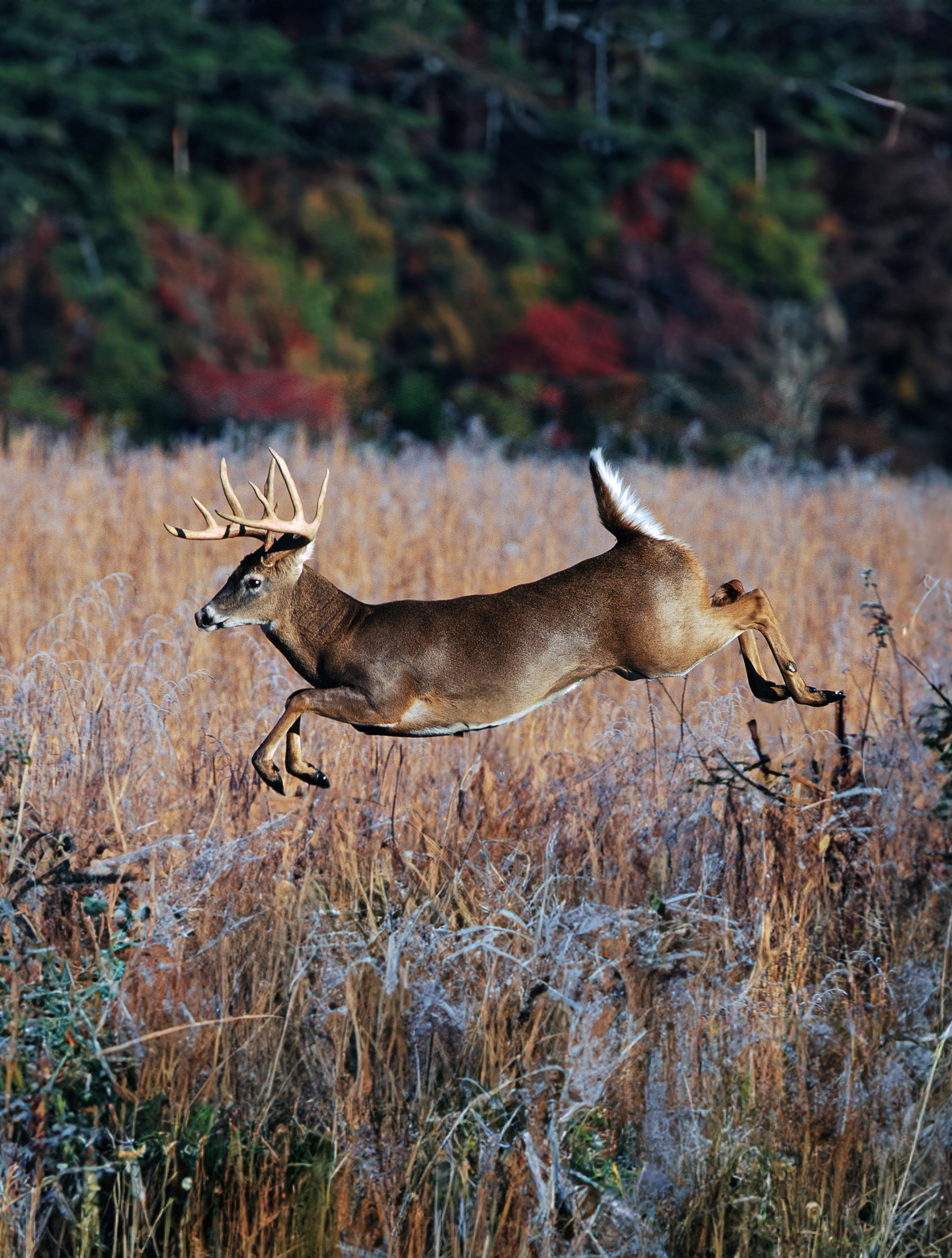


Now it’s up to you. We deliver reliable stopping power Available calibers Constructed for quick and massive energy delivery Lead lock guarantees deep penetration Great for medium and large game
















































 BY MARK RAYCROFT
BY MARK RAYCROFT


 BY JIM BAIRD
BY JIM BAIRD
 BY VERN PETERS
BY VERN PETERS

 BY RICK BRYNE
BY RICK BRYNE



 BY GORD PYZER
BY GORD PYZER
 BY MIKE FITZGERALD
BY MIKE FITZGERALD




















































































 BY MIKE HUNGLE
BY MIKE HUNGLE
 BAILEY
BAILEY






 BY ROBERT PYE
BY ROBERT PYE



















 STRAUSS
STRAUSS






 —KEN BAILEY
—KEN BAILEY

































































 WORDS & PICTURES
BY MARK RAYCROFT
WORDS & PICTURES
BY MARK RAYCROFT




















 Numerous tracks indicate a popular watering hole
Numerous tracks indicate a popular watering hole



















































































































 CISCO MANIA
CISCO MANIA


 CHRISTIAN THERRIEN (BASS, LAKE TROUT); GORD PYZER (WALLEYE)
CHRISTIAN THERRIEN (BASS, LAKE TROUT); GORD PYZER (WALLEYE)
























































